Tools for Cruising Boats Sailing Around the World
THIS POST MAY CONTAIN AFFILIATE LINKS. PLEASE READ OUR DISCLOSURE FOR MORE INFO.
Last Updated on September 13, 2023 by Amy
One of the things David and I love about cruising is being out in remote locations, away from cities and towns. During our world circumnavigation , we’ve been able to go to some amazing places like the Lau group of Fiji and the Ha’apai group of Tonga . This also means we’re away from professional repairmen, chandleries, and Amazon Prime shipping. Therefore, we have to be fairly self-sufficient. Part of this is having a well-stocked selection of tools onboard our sailboat to get the projects done, both improving our boat and making repairs to critical systems. While a lot of them aren’t specific sailing tools, sailboat maintenance is more than your rigging.
While this is a list of what we think are the best tools for a sailboat, it is by no means an exhaustive list of what you should have on your boat. Every boat is different, and your boat will have different needs from ours. Also, some of our tools are relatively old as some of them belonged to my dad. We’ve linked to the best looking, highest rated tools on Amazon for this list. Additionally, some items may have made their way into the bag for a special project recently, and who knows if we will use them again. Some we’ve never used, but we bought them because we borrowed a tool from someone else and thought it would be a good addition.
Table of Contents - Click to Jump

2022 Update!
After spending the summer and fall of 2022 doing a refit on the boat, we have added quote a few things to our tool kit.
We did buy tools that we ended up not keeping – a circular saw and two different sanders immediately come to mind – but before we left Rhode Island we went through everything and decided what we wanted to keep.
Tool organizers – we ordered two different kinds of organizers to try to tackle the mayhem of a tool bag. One is a roll up tool organizer and one is a set of zippered bags . So far, the zippered bags are our favorites, as the tools to fit in the roll up organizer have to be just right to work.
Heat gun – David’s angry he didn’t buy one sooner because a heat gun makes working with hoses and connections so much easier.
Hole-saw kit – we had one before, but we upgraded. Considering how many holes we had to drill with the electrical work, this was a good call, and the Milwaukee hole-saw kit has a good variety and a small case.
Rubber sanding block – for any kind of flat sanding, you really need to have a sanding block if you are going to do it manually, like I did for my fiberglass projects.
Specialty screwdrivers – we had a fixed one before but when you are working in tight quarters, it really make sense to have a ratcheting low profile screwdriver . Additionally, short screwdrivers are handy too, like this phillips head stubby screwdriver . And when we need more power, we have a small powered screwdriver . The most important thing we bought – his and hers ratcheting screwdrivers . These are the workhorses of tools, and we both needed our own when we had so many projects going on at once.
Work table – last year, when David was working on the batteries, he bought a collapsable workbench . It ended up being really handy over the season, and then we got a lot of use out of it over the refit. We have a set of clamps to go with it too.
Drill guides – for many projects, you don’t really need to be super exact with getting your drilling perpendicular to the surface, but for a woodworking project like my new galley pull-out shelves, we did. We got a metric drill guide and an imperial drill guide .
Strippers and crimpers – with all the electrical work, we needed crimpers. This ratchet crimp tool is for coax cables while this ratcheting crimper has interchangeable teeth which makes it a good jack of all trades tool. This one works as a stripper and a crimper , which we primarily use for small gauge wire stripping. This square self-adjusting ratchet crimper works for ferrules. Lastly, we kept a large gauge cable stripper .
Scissors – I didn’t have these on the list before, but it’s kind of an obvious one: a really good pair of scissors . The tool bag should have it’s own set so that the galley or office ones don’t disappear all the time.
Jigsaw – yeah, we have manual tools to cut materials with, but over the refit we found the Ryobi jigsaw to be very helpful and easy to use. Additionally, we bought a jigsaw blade kit to cover the variety of materials we need to cut.
Protection and safety gear – David’s knees take a serious beating so we upgraded his knee protection to volleyball kneepads .
Specialty wrenches – David had apparently been wanting this crows foot wrench set for a while and finally bought them to wrench in small spaces. To replace our thru-hulls, we needed a 10-inch wide jaw wrench and a 12-inch wide jaw wrench . These have very wide jaws but shorter handles, making them easier to store.
Tapping tools – for several projects we needed to tap into metal so we paired this adjustable tap wrench with this drill and tap set .
Electric sanding – while we didn’t think we needed a big sander like I used for the fiberglass project, we did keep multi-tool sanding pads , which we use with our multi-tool to sand small areas.
Endoscope – oh boy. We got stumped a lot trying to run cables or remove parts and often needed to see what was happening beyond our visual ability. We bought a wireless endoscope which rescued us a lot!
Tool Bag v Storage
We divide most of our tools into two places, the tool bag and the storage underneath our couch in the main cabin. The tool bag is easily accessible and contains the most common tools we use around the boat. Items kept under the couch tend to be bigger project tools.
The Sailing Tool Bag
The tool bag itself is a soft-sided bag with lots of pockets and solid handles. We’re very pleased with the size, as it’s easy enough to carry and hold the most critical items.
Sailing Tool Bag Contents
- Ratcheting screwdriver with double drive and 30 bits
- Two putty knives
- Stubby screwdriver set
- Phillips and flat head screwdriver set
- 8″ extra large screwdriver
- Vise-grip locking pliers
- Metric AND SAE hex key sets
- Slip joint, long nose, and diagonal pliers
- Butane torch
- Adjustable wrench set
- 4″ adjustable wrench good for fitting in tight spaces
- Metric and imperial tape measure
- Vise-grip long nose locking pliers
- Paint can opener
- Two utility knives and spare blades
- Plastic putty knives
- Assorted zip ties
- Thread seal tape
- Electrical tape
- Loctite Blue Strength
- Loctite Red Threadlocker
- Silicone grease
- Tactical knife
- Outlet tester
- Sharpie markers
- Waxed whipping twine white with a needle
- Flexible screwdriver extension
- Paint scraper
- Paper towels
Kept right next to the tool bag are a clamp meter and one of our top favorite things on the boat, period: kneeling pads .
Tools in Storage
- Hacksaw with extra blades
- Ryobi Multi Tool with extra attachments
- Ryobi Power Drill with accessories and extra batteries
- Impeller puller
- 15″ adjustable wrench
- Rubber mallet
- Pipe wrench 10″
- AC Voltage detector
- Lighted mechanical pick-up tool
- Lighted and magnetic pick-up tool
- Strap wrench
- Gear oil pump (specific to our outboard)
- Fixed wrench sets for metric and SAE
- Socket wrench set
- Dremel rotary tool
- File & rasp set
- Variety set of stainless steel screw, bolts, washers, and nuts
- Hole saw kit
- Screw extractor set
- Screwdriver bit set
- 3/8 inch torque wrench and 1/4 inch torque wrench
- Blind rivets
- Soldering gun with a rope cutter attachment
- Kill a Watt electricity usage monitor
- cotter and clevis pin kit
- Rivet assortment pack
- Wet or dry sandpaper
- Soldering iron kit
- Coax cable toolkit
- Pipe cutter
- Heat shrink tubing set
- Heat shrink wire connector set
- Universal boat motor flusher
Miscellaneous Tools for Sailing Boats
- Fid set kept with spare lines, a very important sailing tool
- Chamois kept in the main salon cabinet as we use them all the time
- Fuel filter and siphon kept in the engine room
What We Don’t Have
When we first left home we had a sander/polisher onboard. Firstly, we had trouble powering this tool. Even when we did our DIY bottom job , we’d rather have someone else do the sanding. It’s the nastiest part of a bottom job. Polishing is something, with our new boat, we’ve only done every haul out, so we’ve paid someone to polish our topside.
More Sailing Tool Stuff!
There are a few more things we use here and there. Absolutely all of the best tools for sailing boats are in this post and even more are in our Out Chasing Stars Amazon Storefront .
Did we miss any? Let us know!
17 Comments
Thanks! Very helpful to see another’s list.
You need a good DVM
We have one listed in the tool bag section – we call it a clamp meter, but it accomplishes the same thing.
Hi I was impressed to see your tong Ammeter reads both ac and dc amps This is essential and often overlooked As most tong ammeters will read only ac amps or only dc amps As the ac and dc amps use a different sensor
That’s really nice post. I appreciate your skills. Thanks for sharing.
You are welcome!
That’s really great post. I appreciate, Thanks for sharing.
I don’t see a grinder … unless you are using the drill w grinding heads? Also … don’t see any fiberglass rollers; not counting those, … or just using paint roller? Asking cuz I am trying to figure out what kind of “glass/epoxy” tool kit to carry …
Hi Gwynne! The dremel has grinding attachments that we have found very helpful. I didn’t include consumable type-items in here such as chemicals or rollers. Total Boat and West Systems have some great epoxy kits.
- Pingback: living space and room for spares
Thanks, this is a super helpful post. You can bet I will be making any of our purchases from your Amazon store. One question, not sure if Starry Horizon’s has snaps on her cushions but if so, what do you use to replace them as they fail. Thanks
Glad you found the post helpful! We do not have snaps on our cushions. The interior cushions have Velcro and the exterior have straps and… I’m not sure how to describe it!!
Great list! I guess sika isn’t a tool, but pretty much usable everywhere. We also have a couple of vice clamps onboard.
Yes, Sika is in another cabinet! Must write more .. 🙂
Circlip/snap ring pliers?
Don’t have any onboard!
Leave a Reply Cancel reply
Your email address will not be published. Required fields are marked *
Notify me of followup comments via e-mail. You can also subscribe without commenting.
This site uses Akismet to reduce spam. Learn how your comment data is processed .
- BOAT OF THE YEAR
- Newsletters
- Sailboat Reviews
- Boating Safety
- Sails and Rigging
- Maintenance
- Sailing Totem
- Sailor & Galley
- Living Aboard
- Destinations
- Gear & Electronics
- Charter Resources
- Ultimate Boating Giveaway

Must-Have Tools
- By Green Brett
- Updated: February 14, 2017
The modern cruising boat is a complicated machine that needs to function off the grid in a harsh marine environment. It requires constant maintenance and on-the-fly fixes that would make MacGyver proud. Assuming that your vessel has the usual tool kit of wrenches, screwdrivers and duct tape, here are useful tools to have aboard.
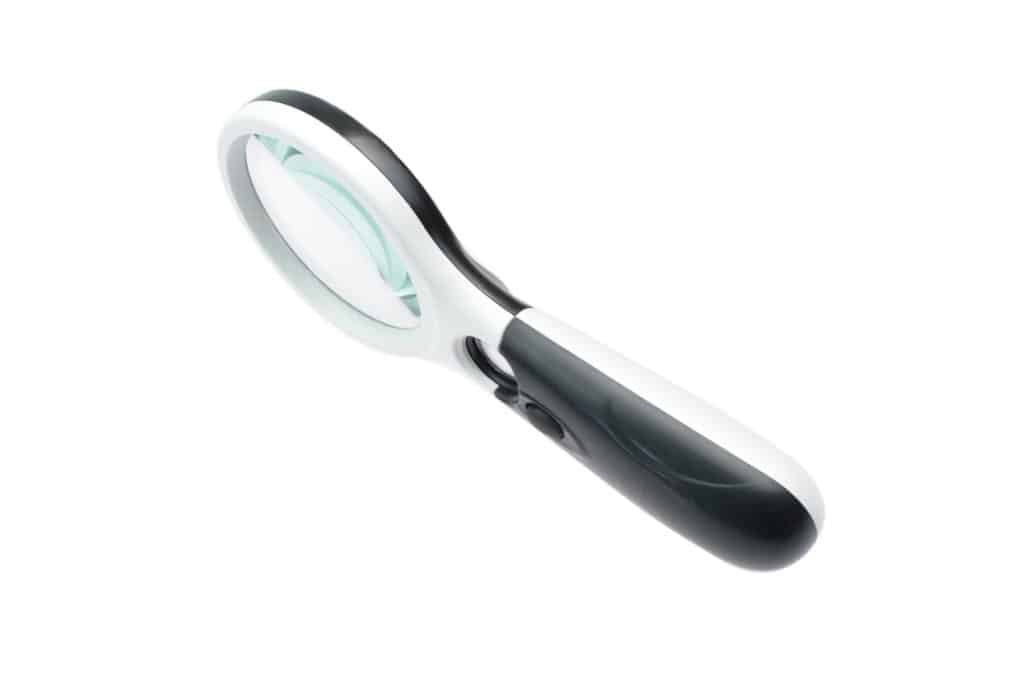
Magnifying glass
A good-quality magnifying glass with an LED light is often overlooked. Use one to inspect metal for hairline cracks or simply to see better when you are working on small objects.
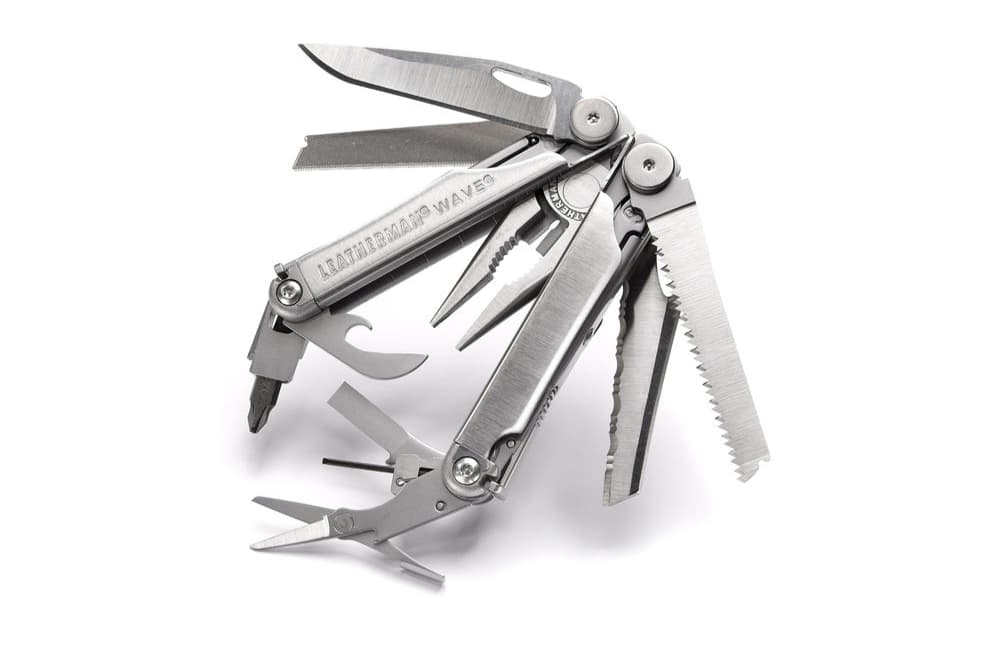
Pocket Multitool
A good multitool such as the Leatherman Wave is indispensable. Always close at hand, it can be used for opening shackles, slicing line, filing corrosion and oh so much more.
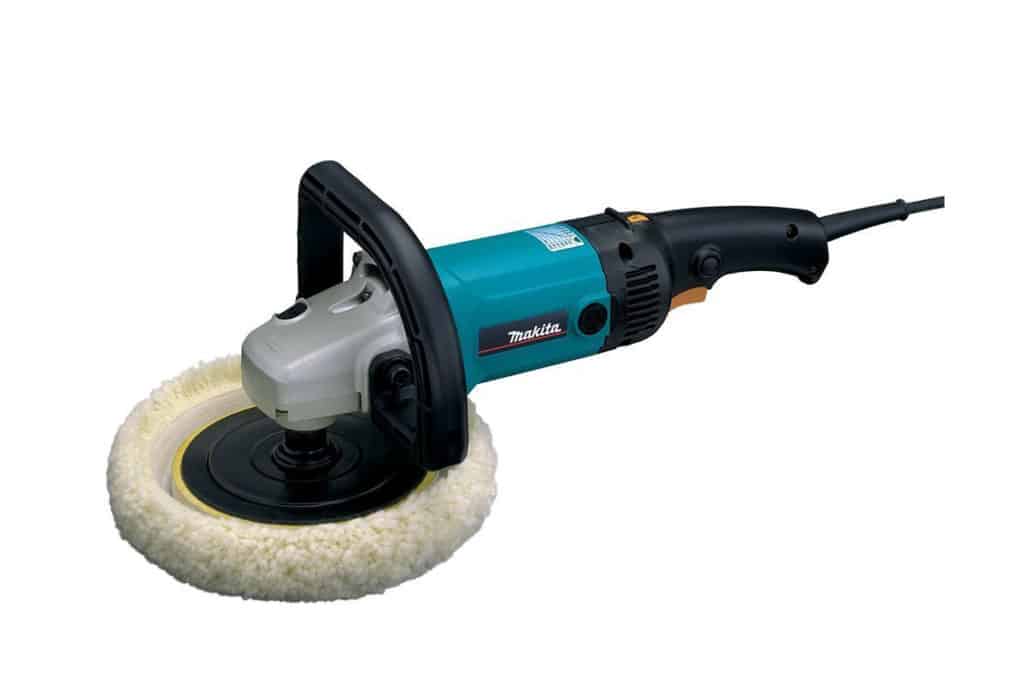
7-inch polisher with polishing kit
If your hull needs a polish and wax, a good polisher does a better and quicker job than rubbing with rags.
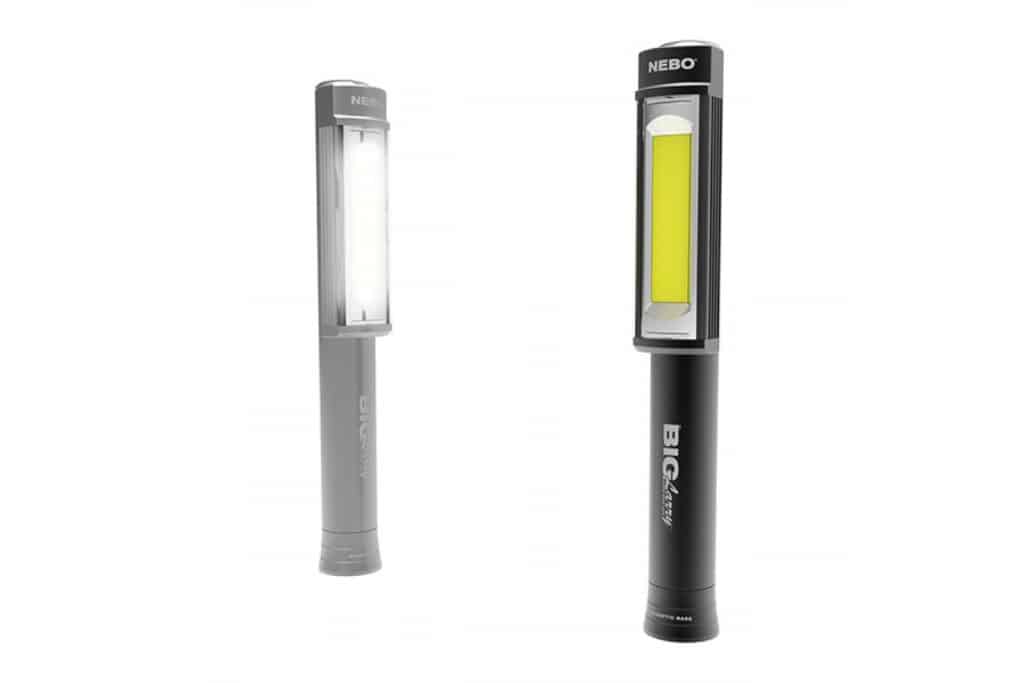
Magnetic LED light
Many spaces in a boat are dark. A bright LED light is a must-have in many situations — preferably one with a red option and a strong magnet. In engine-room spaces, the light often can be placed on the motor to keep both hands free for working. The magnet can also fish out the nut or wrench that just fell out of reach.
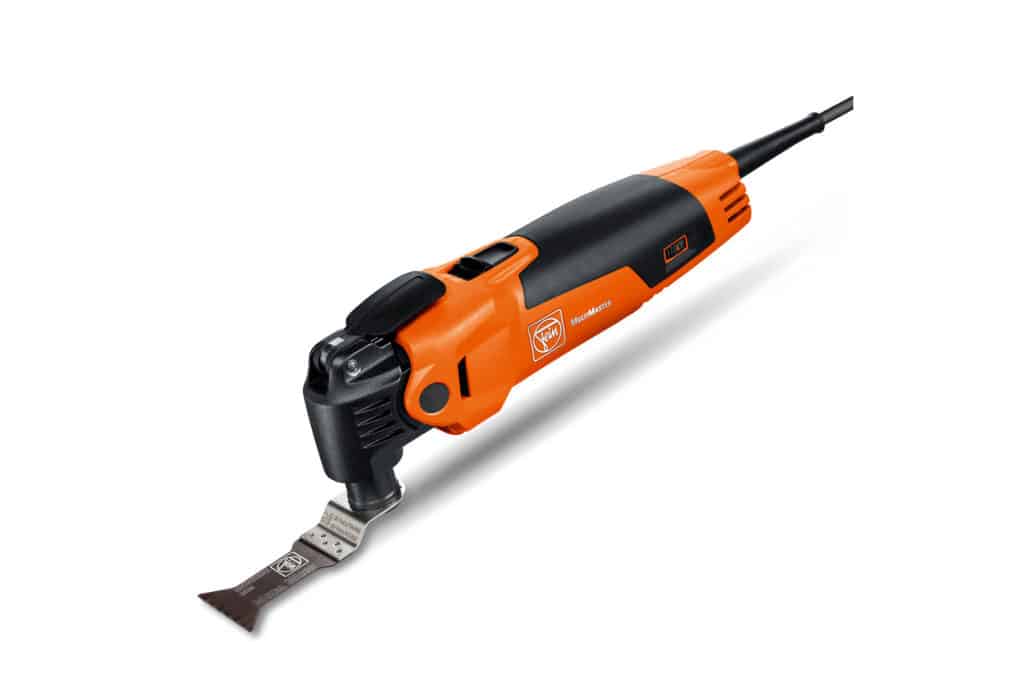
Oscillating Electric Multitool
With a variety of blades and sanding pads, a tool such as the Fein MultiMaster can make small, clean cuts and sand in tight corners.
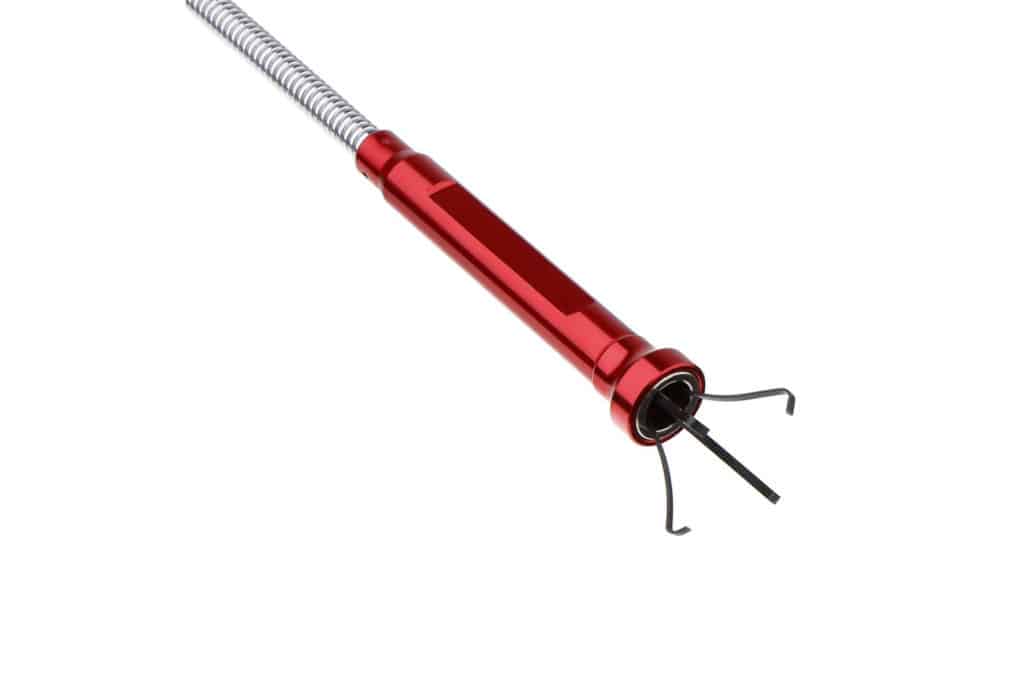
Retrieval claw
Things fall into inaccessible spaces on boats all the time. A quality magnetic-retrieval claw with a light can save the day.
- More: Gear , lighting , livingaboard , tools

Cruising World’s Deals of the Week

Gear Test: Cruising Solutions’ Wireless Headphones
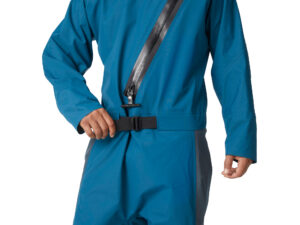
Mustang Survival’s Quadra Dry Suit
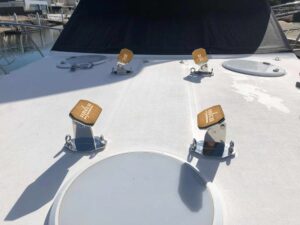
AquaChocks: Secure Tender Storage, Simplified

Gale-Force Diesel Maintenance

Riders on the Storm

The Read Rules
- Digital Edition
- Customer Service
- Privacy Policy
- Terms of Use
- Email Newsletters
- Cruising World
- Sailing World
- Salt Water Sportsman
- Sport Fishing
- Wakeboarding
- New Sailboats
- Sailboats 21-30ft
- Sailboats 31-35ft
- Sailboats 36-40ft
- Sailboats Over 40ft
- Sailboats Under 21feet
- used_sailboats
- Apps and Computer Programs
- Communications
- Fishfinders
- Handheld Electronics
- Plotters MFDS Rradar
- Wind, Speed & Depth Instruments
- Anchoring Mooring
- Running Rigging
- Sails Canvas
- Standing Rigging
- Diesel Engines
- Off Grid Energy
- Cleaning Waxing
- DIY Projects
- Repair, Tools & Materials
- Spare Parts
- Tools & Gadgets
- Cabin Comfort
- Ventilation
- Footwear Apparel
- Foul Weather Gear
- Mailport & PS Advisor
- Inside Practical Sailor Blog
- Activate My Web Access
- Reset Password
- Customer Service

- Free Newsletter

Beneteau 393 Used Boat Review
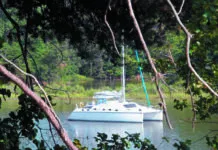
The PDQ 32 Cruising Cat Used Boat Review

Dufour 44 Used Boat Review

Blue Jacket 40 Used Boat Review

How to Create a Bullet-Proof VHF/SSB Backup

Tips From A First “Sail” on the ICW

Tillerpilot Tips and Safety Cautions

Best Crimpers and Strippers for Fixing Marine Electrical Connectors
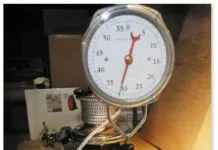
Refining Furling Line Fairleads

Revive Your Mast Like a Pro

Solving the Dodger Dilemma

Polyester vs. Nylon Rode

Sailing Triteia: Budget Bluewater Cruising

How To Keep Pipe Fittings Dry: Sealant and Teflon Tape Tests

Fuel Lift Pump: Easy DIY Diesel Fuel System Diagnostic and Repair

Propane Leak: How to Detect, Locate and Fix
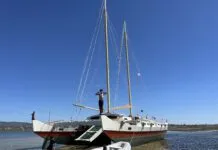
Why Choose the Wharram Design?

Winterizing: Make It Easy With Checklists

Stopping Holding-tank Odors

Giving Bugs the Big Goodbye

Galley Gadgets for the Cruising Sailor

The Rain Catcher’s Guide

Five Best Gloves: Sailing and DIYing in All Weather

Sailing Gear for Kids

What’s the Best Sunscreen?

UV Clothing: Is It Worth the Hype?

R. Tucker Thompson Tall Ship Youth Voyage

On Watch: This 60-Year-Old Hinckley Pilot 35 is Also a Working…

On Watch: America’s Cup

On Watch: All Eyes on Europe Sail Racing

Dear Readers
- Personal Gear & Apparel
- Boat Maintenance
- Sailboat Reviews
- Systems & Propulsion
The Get-Home Sailboat Tool Kit
A few basic tools can tackle almost any problem that plagues a small daysailer..

The tools and materials required to maintain and repair everything on a boat will barely fit in a room. Just the kit required to maintain vital systems will raise the waterline of a large boat and is impractical in a smaller boat. Fortunately, when day sailing and even cruising locally, all we really need to do is get back to the dock … any dock.
Instead of preparing for every contingency, our tech editor Drew Frye has developed this small kit that he carries from boat to boat, whether day sailing on his Corsair F-24 or setting out on a test sail. While it doesn’t contain everything hed like to have, it holds enough to get most small boats home for dinner. In 35 years of sailing he has yet to require assistance on the water and he plans to keep it that way.
Although the kit will differ slightly from boat to boat, the contents should focus on fixing the essentials; propulsion, steering, and keeping the water out. A few items are too big to fit in a convenient bag (ropes, boat hook, and a wet suit for cooler water), but they should be on the boat.
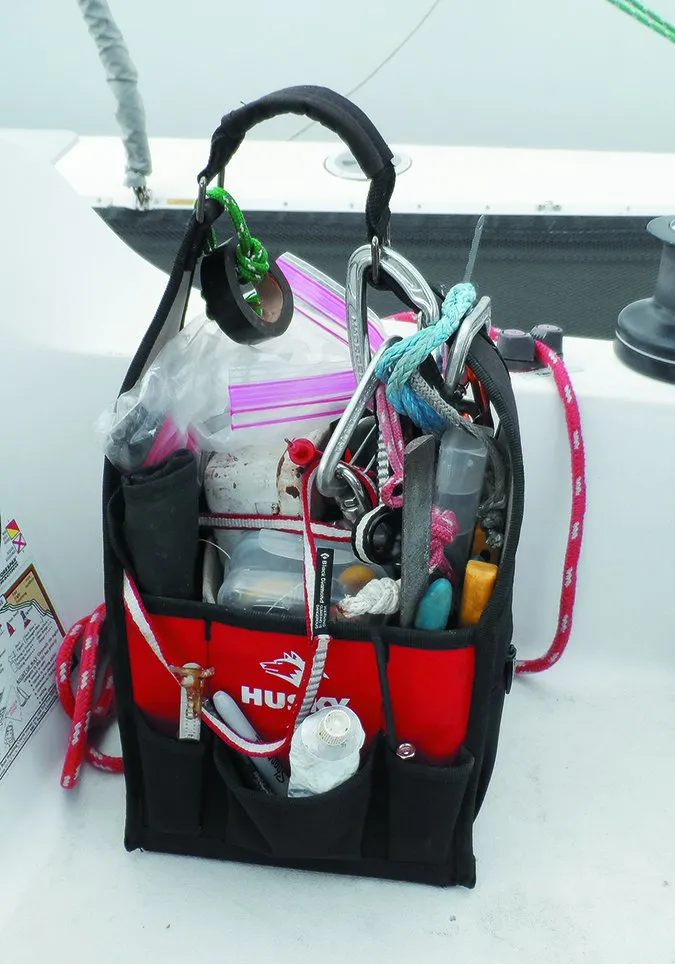
Sails and Rigging Repairs
Although a dismasting far from shore is beyond the scope of this kit, most other sail and rig trouble can be managed with some rope that should be on the boat and a few carefully selected pieces of equipment. Common problems are torn sails (reef or change sails), failed blocks (create a jury rig from a few shackles, carabiners, slings, or a snatch block), and broken lines (reeve a spare or redirect an unused line). Reefing will reduce the loads on your jury rig.
A selection of shackles, soft shackles, and carabiners. A snatch block is handy, but a pair carabiners and a soft shackle will substitute.
Some 6- to 50-foot lengths of rope. Should be on the boat.
Polyester cord. A sailors duct tape. Dyneema sounds like the modern version, but it can be too slippery, so bring both.
Tape. Sail repair tape, electrical tape, and athletic tape.
Sail repair kit. A stitch in time can save nine. A small spool of #4 whippingtwine, a needle and palm, a knife, a roll of sail repair tape, and a few yards of webbing can handle most minor problems. Include reinforced Mylar tape for laminate sails, since needle holes function like the tear-here perforations on a magazine subscription card. If you must stitch, stitch through a layer of polyester sail repair tape.
Rigging wire. We like monel because it is more malleable.
Outboard Engine Repairs
Since our focus here is on small daysailers, well only talk about outboards here. It helps to learn enough about motors to diagnose the really simple stuff. Unlike cars, most don’t run on computers. However, unless the problem is simple to fix, you’ll be sailing home.
If your destination has strong currents wait for slack tide. Choosing an alternate destination is also an option.
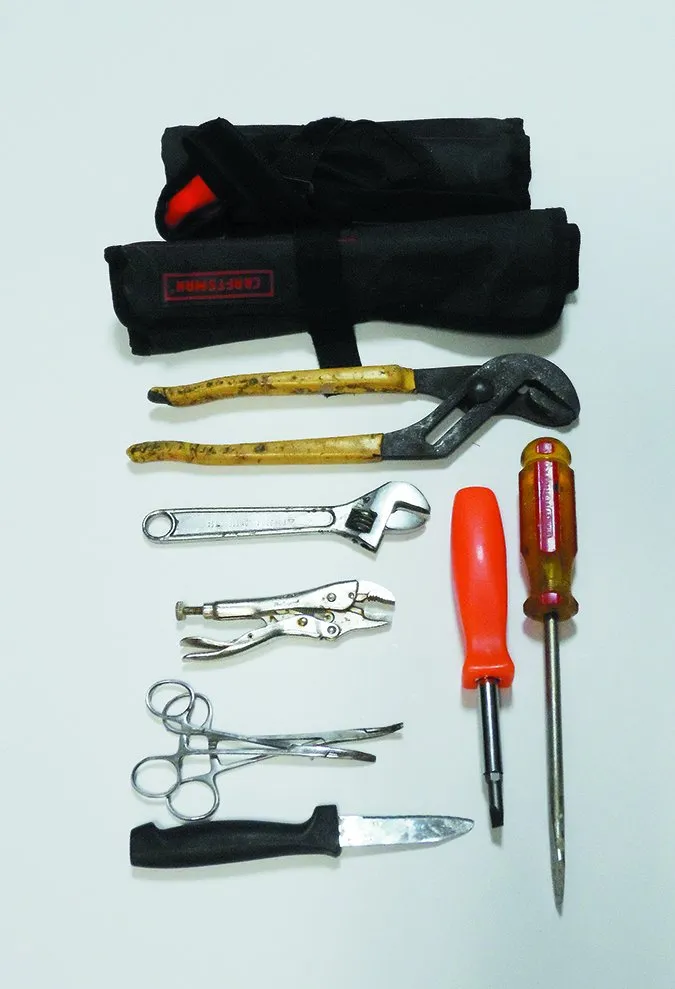
Sail to an anchorage. When choosing the anchorage, consider the wind direction, including morning conditions; its no use reaching up a narrow creek, only to face an impossible tacking battle in the morning. Practice setting and recovering the hook under sail. The sail plan for sailing on and off the anchor will vary by boat, and situation. Where ever you anchor assume you may have to sail off. Hopefully, by morning you may have sorted the engine problem out.
Sail into your slip. Safety should be your guide, but this is often not as unreasonable as it sounds. Again, the sail plan for this will vary by situation, the idea is to set the minimum maintain maneuverability. Furling sails come in handy here. Remember that you have no brakes (backing the jib does very little and will make the boat turn away) so have a bail-out plan.
Sail close and anchor. If you can’t get right into your slip, then either kedge in, beg a tow, or use the tender. In a small boat, you can probably nose up to a piling or finger pier and then warp into a slip.
But lets say you really need the engine. If the engine was running well earlier, chances are good it is something very simple.
Air leak. The tiniest suction leak in the fuel hose can make the pump cavitate. These can be brought on by motion underway or lifting and lowering an outboard. Look for loose clamps, cracked lines, and cracked fittings where the fuel line attaches to the pump or outboard. Generally, there will be some evidence of leakage, but some only leak inwards or when the engine shakes.
Water in the fuel. It was OK when you left the dock, but got stirred up underway. Is there low drain point (possible with diesel, never with gasoline)? Worst case scenario, borrow a fuel line from somewhere, bail some good fuel off the top into a dry soda bottle, duct tape it to a bulkhead (only above deck if gasoline) and run off that. This requires close attention, but I’ve done it twice.
Clogged filter. If it is an outboard, most dinghies and small kicker filters are practically interchangeable and you have one in the bag. If its a diesel with a large filter, hope the owner has a spare on board. If there are multiple filters, can one be safely by-passed?
No ignition? Install a new plug or clean the one you have. Probably not much else you can fool with at sea.
Flooded? Very common with certain motors. You must close the choke to get them to start, but if you pull more than twice, open it too soon or throttle down too soon, the intake loads up. Push the choke in and go do something else for 10 minutes. Pull 2-3 times with the choke in, then pull it out and see if it coughs.
Outboard engine won’t stay down (broken tilt lock). Tie it down with rope.
Shifting or throttle linkages not working. Disconnect and operate manually at the transmission or engine. Vise grips or cord can help.
Tools for Outboard Engine Repairs
- End wrenches in a roll. A light spray of rust preventative will keep them rust-free. Unlike a plastic case, it won’t slide off the deck.
- Pliers, several types.
- Adjustable wrench and vise grips.
- Several sparkplug wrenches.
- Screwdrivers. One multi-type, and several straight and phillips.
- Strap wrench for filters.
- Small wire brush and some emery cloth.
- Waterproof grease.
- Small flashlight for seeing in tight corners.
- In-line fuel filter and some small hose clamps.
- A few short lengths of fuel hose and a few fittings and barbs and splicers.
- Hacksaw blade.
- Swim goggles. A mask is better. Also a wet suit or drysuit if the water is too cold for swimming.
Electrical Boat Repairs

Electrical problems can be related to the engine, but running lights and sump pumps are also vital. The trouble is usually a broken wire (splice it), corroded fitting (replace), or a bad connection (clean, grease, and re-connect).
Crimping tools, including strippers, ratchet crimpers, and a small collection of fittings and heat shrink is essential. Pill bottles work well for stowing these. Sure, you could splice wires together and wrap with tape for a temporary connection, but crimping is fast, ensures a more positive connection, and will stand up better to vibration.
Multimeter. A mid-level multimeter that measures AC/DC voltage, AC/DC current, frequency, capacitance, resistance, tests diodes, and checks continuity will be more than enough.
Cable ties. Not so much for wiring as for other things.
Five feet of #14 twin lead wire. If you need smaller, trim a few strands off the end. If you need bigger, double it.
Barbecue lighter. Use this for shrinking tubing and melting fresh cut ropes.
Steering Problems
More boats are probably rescued for loss of steering than taking on water or bad weather. Something jams and all you can do is go in circles.
Steering cable or chain breaks. You should have an emergency tiller at the ready (not the bottom of a locker). Regularly check for fit and function.
Broken or jammed rudder. Although emergency rudders are possible, steering with a drogue is far simpler and can be rigged with what you have on hand in 15 minutes. It works under sail but is even easier under power (see Steering Without a Rudder for the details). An anchor suspended closely under a fender makes a good jury drogue.
Wrapped a rope around the rudder or propeller. Crab pots and lobster pots are a common hazard, but also loose bits of floating fishing line and nets. Often diving with a knife is the only answer, but sometimes a boat hook or a pair of boat hooks can maneuver it off.
Keeping Water Out of the Boat
If the electric bilge pump isn’t working, it is probably due to either a bad wire or connection, the automatic float switch is stuck or failed (perhaps you can bypass it). A dirty bilge can lead to clogging; clean the strainer, and if there is a check valve, check that too.
Duct tape. Failed hoses and pipes can be patched with duct tape (use lots), tightly wrapped with parachute cord or braced with hose clamps. For larger holes, wrap a layer of tape, insert a slightly oversized flexible metal or plastic patch, and tape over that.
Hose clamps. For -inch to 1 -inch hoses. Although not the strongest, those with continuous slots fit more sizes. If they are all the same type and width, they can be combined to get home.
Butyl tape. No curing time, works wet, and it doesn’t dry up in the bag.
Bucket. Sometimes the pump just can’t get going.
Avoid Repairs with Diligent Maintenance
Most of these hypothetical repairs (no-never happened to us!) might have been avoided if we had inspected the boat regularly and taken what we noticed to heart. A thorough inspection in the spring and at mid-season is a good use of time, and a sailor should always be listening to the engine and looking at the rigging for changes.
The Sailboat Tool Bag
On larger boats, the sky is the limit as to what you can carry. For smaller cruisers, everything can fit in one bag. Some folks like a zippered bag. That’s smart, since nothing can fall out. But these bags can make it hard find anything either.
With an electricians bag (see photo), it constantly reminds me of everything that we have, allowing us to make better use of fewer things. They are made for working up ladders, and so we can hang it if need be, and cleaned out, it doubles as riggers bag for masthead work.
Your kit, of course, should be tailored to fit your boat. Aim to keep the boat afloat and under way. You don’t need to fix what’s broke, just get her safely pointed in the right direction.
RELATED ARTICLES MORE FROM AUTHOR
Leave a reply cancel reply.
Log in to leave a comment
Latest Videos

First Look at the Brand New Catalina 316

Can A Lithium Battery Fry Your Alternator?

A Sailboat Tour of the Exquisite Little Harbor 63 Ketch

Dock and Anchor Lines – Polyester or Nylon?
Latest sailboat review.

- Privacy Policy
- Do Not Sell My Personal Information
- Online Account Activation
- Privacy Manager
Boat Reviews
- Boats Specs
- Marine Pros
- Boat Insurance
- Boat Warranties
- Boat Transport
- Boat Towing
- Marine Forecasts

Your Ultimate Boating Resource

The Essential Boat Tool Kit: Tools Every Boater Needs
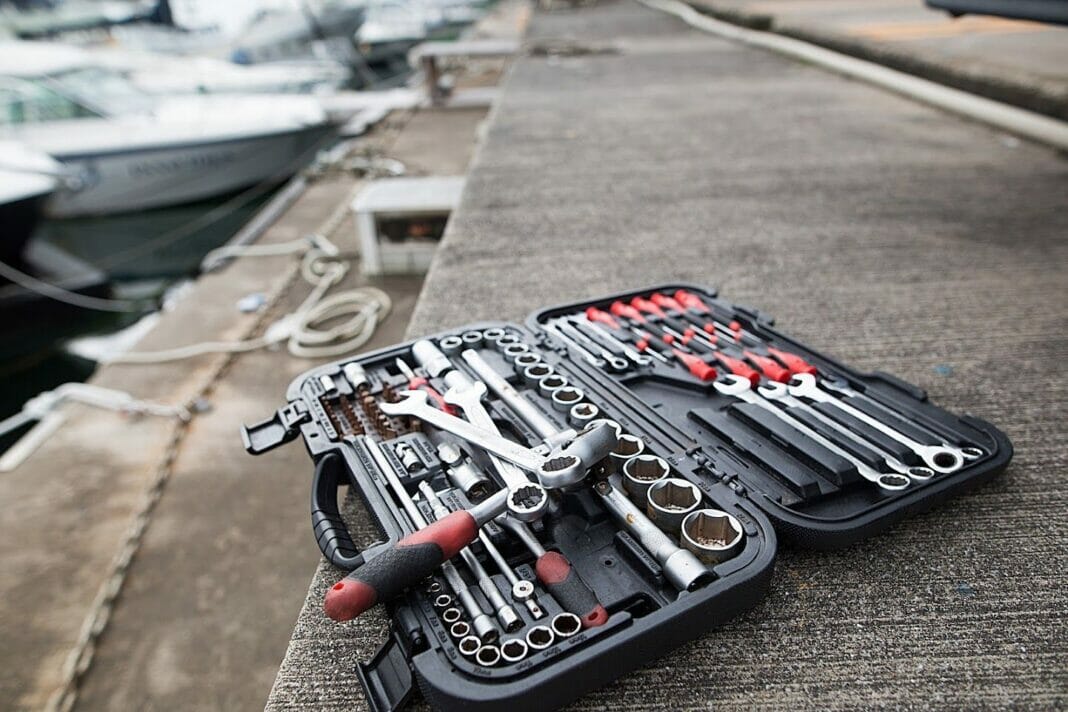
Whether you’re sailing on a small boat or cruising on a large yacht, having a well-stocked boat tool kit is essential to keeping your vessel running smoothly and ensuring the safety of everyone on board. In this article, we discuss the essential tools every boater needs in their boat tool kit.
Basic Hand Tools
These are the standard hand tools that you’ll need for most repairs and maintenance tasks on your boat:
1. Screwdrivers
A set of both flathead and Phillips head screwdrivers of various sizes is essential for performing basic repairs and adjustments. A set of small precision screwdrivers can also be useful for working with small components such as electronic devices.
2. Wrenches
Wrenches are vital for tightening and loosening nuts and bolts. An adjustable wrench (Crescent wrench) is a versatile choice to cover multiple sizes, but having a comprehensive set of combination wrenches can make removing stubborn nuts and bolts a lot easier.
A set of different types of pliers is necessary for various tasks such as gripping, cutting, and crimping. Needle-nose pliers are especially helpful for working with small components and reaching tight spaces. A pair of locking pliers (Vice-Grips) can come in handy for extra gripping power.
A basic hammer is essential for various tasks such as driving in and pulling out nails and tapping parts into place.
5. Socket set
A ratchet and socket set is an excellent investment for efficient and convenient removal and installation of nuts and bolts. Make sure to have both metric and standard sizes to cover all the potential hardware you will encounter.
6. Hex keys
Also known as Allen keys or Allen wrenches, hex keys are necessary for working with many boat components such as winches, gearboxes, and engine systems.
7. Measuring tape
A tape measure or measuring tape is essential for measuring distances, heights, and other dimensions during various tasks like rigging adjustments or installing equipment.
Specialized Boat Tools
The following tools are more specialized for specific boating needs but are crucial to have on board:
1. Marine sealant and caulk gun
A tube of marine sealant, along with a caulk gun, is essential for sealing leaks and cracks in your boat’s hull, as well as sealing areas around hardware installations.
2. Wire strippers and crimpers
For electrical work, wire strippers and crimpers are necessary for connecting and terminating wires properly. Ensure that you have the correct connector types specific to your boat’s wiring system.
3. Multimeter
An essential diagnostic tool for your boat’s electrical systems, a multimeter can measure voltage, current, and resistance to help identify issues and maintain your boat’s electrical components.
4. Spark plug wrench
This specialized wrench is necessary for removing and installing spark plugs on your boat’s engine.
Safety and Maintenance Gear
These items are essential for personal safety and maintaining your boat:
1. Personal protective equipment (PPE)
Safety glasses, work gloves, earplugs, and a dust mask should be part of your boat tool kit to provide protection during various tasks.
2. Fuses and spare bulbs
Having spare fuses and lightbulbs for your boat’s electrical system is crucial to keep your boat’s lights and appliances functional.
3. Lubricants and penetrating oils
WD-40, silicone spray, and penetrating oils can help free up stuck hardware and lubricate moving parts.
4. Spare parts
Having spare parts such as spare hoses, clamps, and belts can not only make repairs more efficient but also prevents unforeseen issues while sailing.
Organizing and Storing Your Boat Tool Kit
It’s crucial to keep your boat tool kit organized and stored in a secure and easily accessible location on your boat. A sturdy, waterproof toolbox or tool bag with separate compartments can help keep tools organized and protected from the elements. As an additional measure, you can use a desiccant to absorb moisture and prevent rusting on metallic tools.
A well-stocked tool kit with the essential tools listed above can ensure that your boat is well-maintained and make your boating experience more enjoyable and safe. Don’t forget to check your boat tool kit regularly and update it as necessary.
RELATED ARTICLES
Overview of the 2024 sea-doo rxp-x 325, overview of the 2024 parker offshore 2900 cc, what your boat’s beam is and why it matters, power cats of 2024: ultimate guide to the top power catamarans this year, navigating the heat: 10 safety tips for a safe boat ride in the summer heat, latest posts, don't miss, our newsletter.
Get the latest boating tips, fishing resources and featured products in your email from BoatingWorld.com!
What type of wood is used for pier pilings?
What is the difference between a dock and a floating pier, what is the proper technique for pulling a beginner wakeboarder, what does ‘no wake’ mean on a lake, what is the difference between wash and wake, highs, lows, and tidal know-how: a deep dive into ocean currents, 10 essential tips for fishing near private property, the benefits of using a drift sock: guidance for anglers, lure fishing: secrets for imitating live bait and attracting fish, explore the untapped depths of america’s best bass fishing spots, outboard motor maintenance: tips for keeping your engine in top shape, diy boat building: 8 tips and tricks for building your own vessel, the art of miniature maritime craftsmanship: ship in a bottle, antifouling paints: a guide to keeping your boat shipshape, gelcoat repair guide: everything boat owners need to know, beginner’s guide to standup paddle boarding: tips and techniques, boating for fitness: how to stay active on the water, kayak safety: how to stay safe on the water, anchoring in a kayak or canoe: how to secure your small boat, overview of the 2024 yamaha 252sd, overview of the 2024 tiara yachts 48 le, overview of the 2024 bass cat jaguar sts, 2024 pursuit os 445: an overview, 2024 aquila 47 molokai review, 2024 sea-doo switch 13 sport review, gear reviews, megabass oneten max lbo jerkbait review, fortress anchors fx-7 anchoring system review, fortress anchors fx-11 anchoring system review, fortress anchors commando anchor kit review, fortress anchors aluminum anchors review, stay in touch.
To be updated with all the latest news, offers and special announcements.
- Privacy Policy
Packing Your Boat Tool Kit
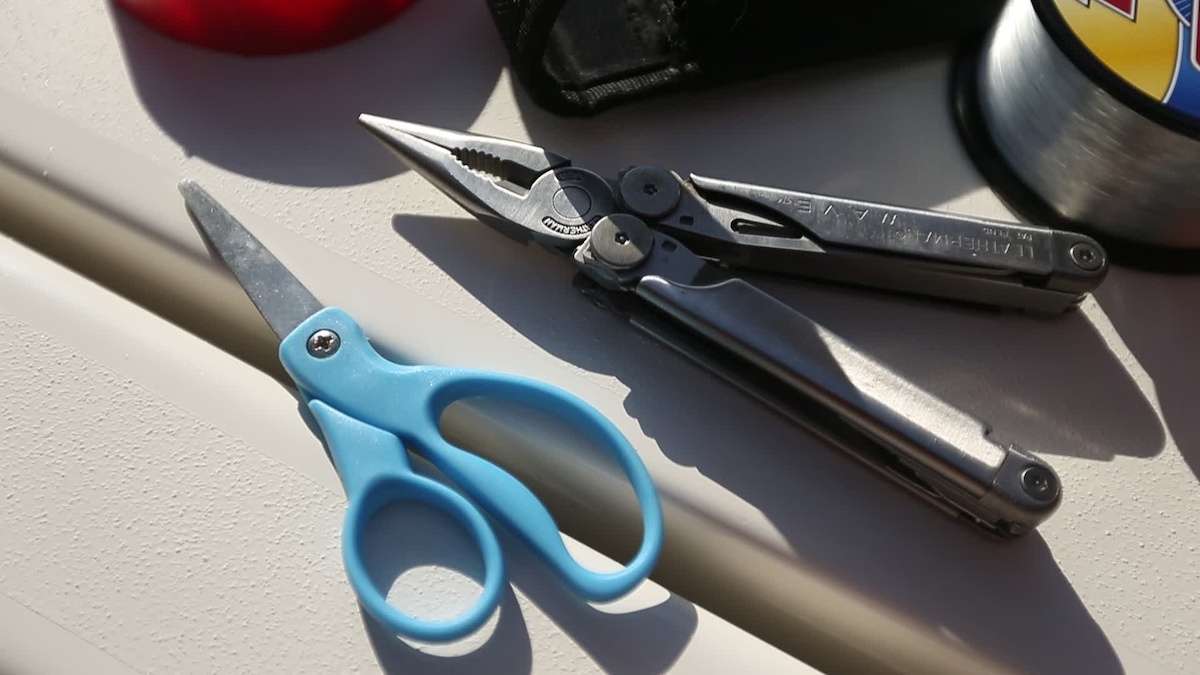
Boats of all shapes and sizes , especially boats that head offshore or long distancing cruising, should always be well-stocked with a proper onboard tool kit. Cruising sailboats , for example, head offshore with a literal ton of tools and spares for emergencies in remote locations.
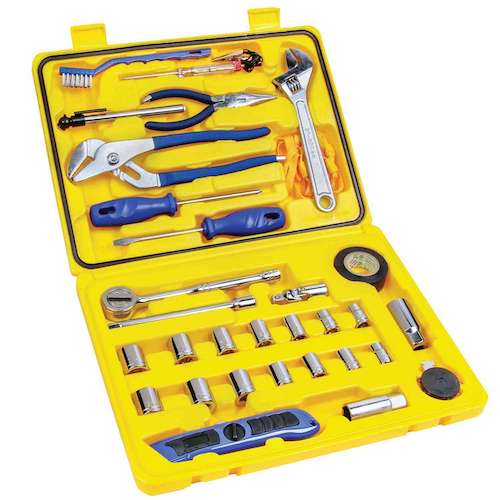
When you're getting ready to pack your own boat tool kit, you can pack just 15 things to save the average day or weekend on the water. Most of the items below can be packed into a single, soft-sided took kit that can live aboard or be moved from boat to boat.
Boat Tool Kit Essentials List
- Rigging knife
- Line and string
- Screwdrivers
- Socket and wrench set
- Spare bulbs, fuses and belts
- Thread locking fluid
- Telescoping mirror and magnet
- Jumper cables
- Wooden plugs
- Mask and snorkel
Now, let's dive into the details and the reasoning behind each of these tools.
The Ultimate Boat Maintenance Guide
1. Multi-Tool
A multi-tool is the bare minimum for quick jobs, and you can pack it easily if you’re overnighting or cruising on other people’s boats. The basics include flat and Philips head screwdrivers, pliers, assorted knives, a saw, and in even a corkscrew.
2. Rigging Knife
Most sailors, in particular, have a rigging knife in a pocket or attached to their belt. Smaller and lighter than multi-tools, these knives also come with a marlinspike to loosen tight knots in lines and a shackle key. Most also have a tether so they don’t go fall into the water.
3. Headlamp
Because problems don’t just occur during daylight hours, you’ll need a flashlight and a headlamp is perfect to keep your hands free to work. Small, inexpensive LED headlamps can be purchased anywhere and some even come with a red or white light so you don’t blow your night vision when peek at a dark compass or a chart. You can even use them to grill at night or find your pet hiding belowdecks.
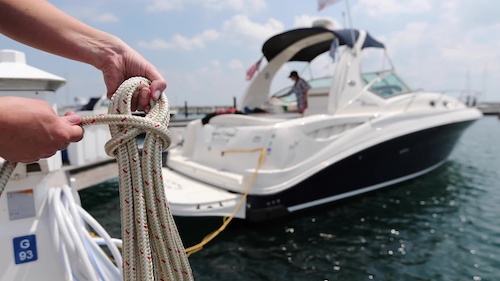
Any kind of tape is good. Electrical tape is fantastic for fixing everything from loose wiring to shoes that are falling apart. Self-amalgamating silicone tape sticks to itself and is a one-size-fits all bonding material that is small and light. For bigger emergency fixes, bring along some duct tape that can be used as temporary leak repair.
5. Line and String
Boats are already a tangle of lines, but you can never have too much. You never know when you'll need a spare docking line, a replacement line to drop anchor, or even an extra line to tie off a fender.
5 Basic Boating Knots for Beginners
6. Cable ties
Cable ties are great when line isn’t available. These small strips of plastic are strong enough to take on a real mechanical challenge but can also be used to secure a pirate flag. You can even use them as a very temporary backup to a failed hose clamp. They’re small and light, so keep a dozen in assorted sizes.
You can fit an assortment of pliers in a pouch to grab and go. Include needle nose pliers, wire strippers and even a set of locking pliers that can handle jobs of different sizes. Whether you need to hold something in place or wiggle something free, pliers are great.
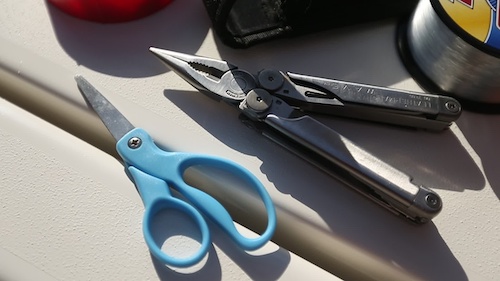
8. Screwdrivers
Flathead and Phillips screwdrivers in a couple of sizes are a must. Not just for the obvious jobs of tightening or loosening screws, screwdrivers can be used to double as a broken gear shift handle or as a small pry bar to open a stuck locker. Some screwdrivers come with multiple heads to switch out according to need.
9. Socket and Wrench Set
A small (maybe 12-piece) socket/wrench set could make the difference between a day on the water and a day stuck in the slip. These sets are inexpensive but the cheaper you go, the more likely the tools will rust in the marine environment.
10. Spare Bulbs, Fuses and Belts
It’s usually the small or overlooked items that cause the most annoying situations. A blown fuse could mean the bilge pump stops working so carry a few DC, AC and cartridge fuses for fast replacement. Spare bulbs can be swapped in quickly to make lights work and a spare belt for the engine can make the difference in getting back into the slip safely.
11. Thread Locking Fluid
This one is many for all your sailors out there—sailboats move and with the constant vibration and strain, things that should stay tight, come loose. Keeping a nut securely on a bolt, as in for example a water pump, will be easier with thread locking fluid. There are many brands of this thin adhesive that keeps nuts and bolts from loosening, leaking or corroding.
12. Telescoping Mirror and Magnet
Boats are notorious for having difficult-to-access spaces and deep bilges and it’s Murphy’s Law that the one bolt you loosened will fall somewhere where you can’t see or reach it. A polished steel telescoping mirror will let you peek under the engine or even around behind a locker. An accompanying telescoping magnet will reach that runaway bolt hiding in the murky bilge water.
13. Jumper Cables
All powerboats have a marine battery , and even most sailboats have auxiliary power, which means they also have a battery. It’s easy to run out of juice when running lights, the stereo, and other connected electronics, so cables can save the day. They won’t reach from one boat to another, but you can borrow a 12V battery and bring it aboard to get the engine started.
Marine Battery Basics
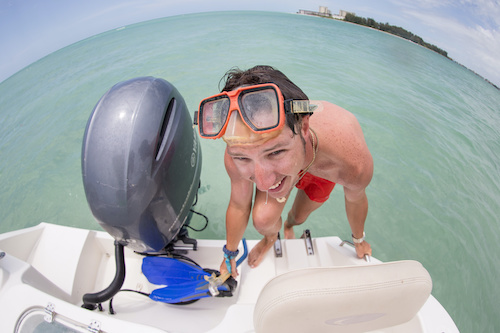
14. Wooden Plugs
Again, another one for all you sailors—hoses can come loose and that usually means water ingress. Whether the hose popped on the head intake or a thru-hull fitting has failed, a wooden plug may be the only thing that will keep the boat afloat for the day. Most chandleries sell round, wooden or foam plugs in bags of assorted sizes.
15. Mask and Snorkel
Not all problems occur on deck or in the cabin. Some issues develop under the waterline so keep a basic, inexpensive mask and snorkel on hand in case you have to cut away line wrapped on a prop or untangle kelp stuck on the keel. You’ll be able to see the problem better and get the job done faster.
Read Next: First-Time Boat Owners Checklist
You May Also Like:
- Boat Safety Checklist & Safety Equipment List
- Marine First Aid Kits & Onboard Safety Guide
- How to Clean a Boat
- Basic Trailer Maintenance Checklist
- Find the Right Boat for Your Lifestyle
Join Our Newsletter!
Get community news, buying bargains, and how-to guides at your fingertips.

Boat Sailor
Sailing tools: a comprehensive guide for enthusiasts.

Sailing is a thrilling adventure that demands precision, skill, and the right tools. Whether you’re a seasoned sailor or a newbie eager to hoist your first sail, having the right sailing tools can make a world of difference in your experience. In this guide, I’ll walk you through a range of essential sailing tools, offering valuable suggestions and reasons for their importance.
Navigational Aids
Charting your course.

Sails and Rigging
Harnessing the wind’s power.
Your sails are the wings of your vessel, and the rigging is the intricate network that supports them. As you set sail, having the right sails for your boat’s size and purpose is paramount. Equally important is maintaining a well-rigged mast, boom, and rigging system. Consider the type of sailing you’ll be doing – whether it’s competitive racing or leisurely cruising – and choose the appropriate sails and rigging to optimize your performance.
Safety Gear
Prioritizing protection on the water.

Communication Tools
Staying connected at sea.

Maintenance Equipment
Keeping your vessel shipshape.

Anchoring Essentials
Finding stability in open waters.

Weather Instruments
Navigating with meteorological insights.

Personal Comfort Gear
Ensuring a pleasant voyage.
Comfort is key for an enjoyable sailing experience. Cushions, bean bags, and deck chairs turn your deck into a cozy retreat. Don’t forget sun protection, including hats, sunglasses, and sunscreen. And for those moments of relaxation, a good book or some music can enhance the serenity of your surroundings.
Sailing Apparel
Dressing for success on deck.
Dressing appropriately for the elements is crucial. Opt for quick-drying, breathable clothing that offers protection from the sun and wind. A waterproof jacket and pants keep you dry in rainy conditions, and nonslip deck shoes provide traction on wet surfaces.
Emergency Tools
Preparing for the unexpected.
No sailor ever sets out with the intention of encountering an emergency, but being prepared is vital. Emergency tools include a fire extinguisher, a bilge pump, and tools for patching leaks. A well-stocked ditch bag with essentials like food, water, and flares can be a lifesaver if the unexpected occurs.
Navigation Rules
Sharing the waters safely.
When sailing, it’s essential to understand and follow navigation rules. These rules dictate how vessels interact on the water to avoid collisions. A shared responsibility exists between sailors, emphasizing the importance of communication and adherence to the rules. Being familiar with these rules ensures smooth sailing and safe encounters with other vessels.
Choosing the Right Sailboat
Tips for smooth sailing.
Selecting the right sailboat sets the foundation for your sailing journey. Consider factors like boat size, sailing objectives, and experience level. Starting with a smaller sailboat for learning and progressing to larger models ensures a smoother transition and a more enjoyable experience.
Embarking on Your Sailing Journey
As the wind fills your sails and the water stretches endlessly before you, the thrill of sailing is unmatched. Armed with the right sailing tools, you’re ready to conquer the seas with confidence. Remember, safety, preparation, and a love for the open water are the true compass points that guide you on your voyage of discovery.
Can I use a regular compass for navigation while sailing?
While a regular compass can provide general direction, a marine compass is designed for accurate navigation on the water, considering magnetic deviations and other factors.
What’s the advantage of using a satellite phone over a VHF radio?
Satellite phones offer global coverage, allowing communication in remote areas where VHF signals may not reach.
Are electronic gadgets like chartplotters user-friendly for beginners?
Yes, many modern chartplotters are designed with user-friendly interfaces, making navigation easier for beginners.
Can I skip learning navigation rules if I’m only sailing for leisure?
No, understanding navigation rules is crucial for safe interactions with other vessels, regardless of your sailing objectives.
What’s the best way to maintain my sailing tools for longevity?
Regular cleaning, proper storage, and routine maintenance are key to extending the lifespan of your sailing tools and equipment.

Michael Thompson
Embarking on a lifelong love affair with the sea, I found solace and exhilaration in the art of sailing. From navigating treacherous waters to harnessing the wind's untamed power, my passion has evolved into a mission to inspire others. Join me on a voyage of discovery as we explore the vast horizons of sailing's timeless allure.
More to Explore

Spiridakos Sailing Cruises: An Unforgettable Adventure
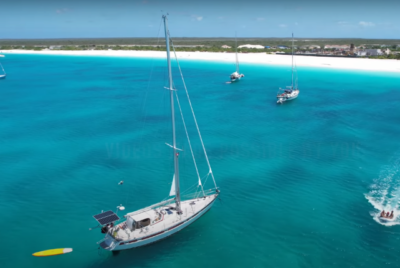
Sailing in the Caribbean
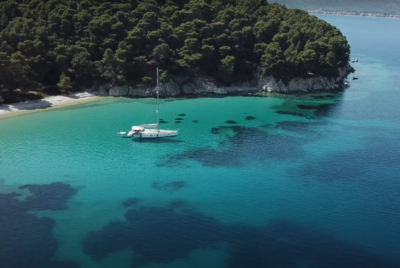
Sailing Greek Islands
Sailing Gear Essentials: the Ultimate Packing List (and PDF)
When I first started, I wish I had an overview of what I need right now, and might possibly want in the future. So here's the list with all sailing essentials.
What gear do I need for sailing? You need clothes that dry quickly, deck shoes with good grip that don't leave marks, and multiple layers of clothing. You also want to bring water and sunscreen. Depending on your type of sailing and your role onboard, you need different kinds of specialty gear.
It really matters what sort of trip you're planning. Also, if you're the skipper, you're responsible for bringing a lot of additional skipper & boat gear. I've specified the complete list below for all different conditions and roles.
I've also made a printable checklist that you can download for free.
Download free sailing gear packing list
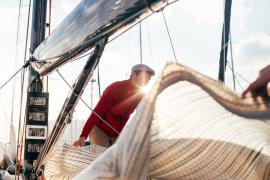
Interactive Sailing Packing List
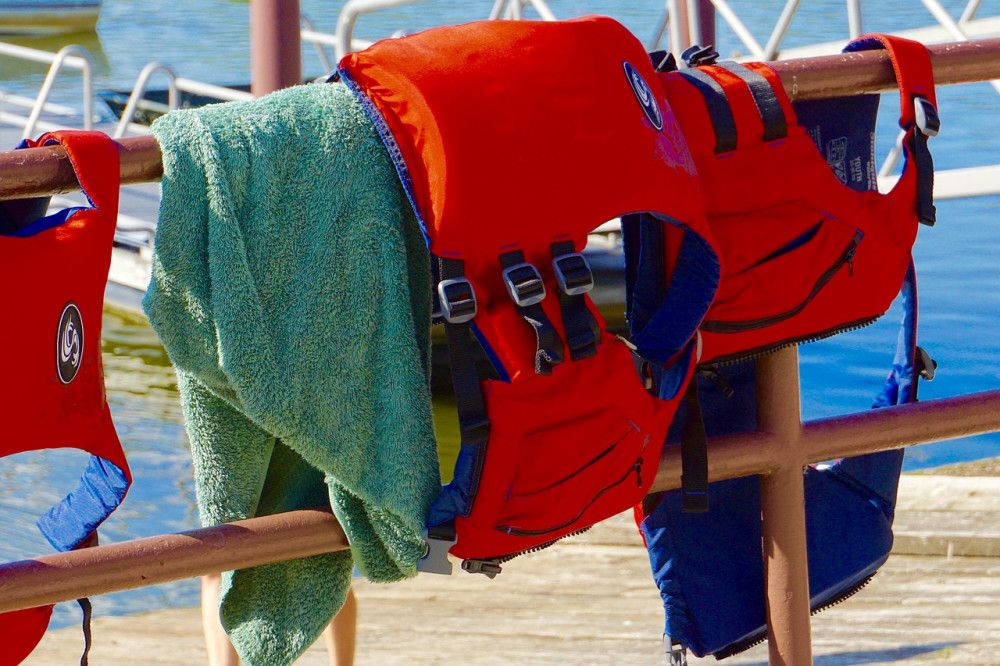
On this page:
Gear essentials: quick summary, essential sailing clothes, skipper gear, gear you need if you own a boat, related questions.
What you need to bring depends on the sort of trip, the trip length, and your role.
I categorize gear into four types of gear:
Clothing - There are some basic rules for clothing, which I'll explain below. But the best way to know what kind of clothes to wear is asking the skipper or sailors that are regulars in the area. Weather conditions on the water are very different from land.
Crew gear - All other personal things like paperwork and toiletries. Only applies for trips of multiple days or international journeys.
Boat gear - Navigation equipment, electronics, and safety gear. Boat gear is always the responsibility of the skipper, so if you're joining as crew, you don't have to worry about this.
Supplies - You always need supplies, and with long trips, this can really add up. But with one-day trips, you don't really need to worry beyond water, since there will probably be restaurants and stores around. However, you never know: a simple trip around the lake can end up in spending the night there. Mechanical breakdown happens all the time, so perhaps you want to bring at least some food and extra water.
Below I'll go into more detail for each of the different gear categories. You'll also find all of these items on the downloadable checklist. But first, let's quickly take a look at the packing list for beginner day-sailors.
What you need to bring as crew on a 1-day sailing trip:
If you're tagging along for a short trip as (beginner) crew, you don't need to bring much. You need to wear appropriate clothes and bring a bottle of water and sunscreen. Appropriate clothes are:
- multiple base layers of clothing that are comfortable and dry quickly
- non-marking deck shoes that provide a good grip like sneakers or boat shoes
- sweater and (sailing) jacket
- sun protection, like a hat or cap, and long sleeve shirts
I'll go into multiple day trips below, but first I want to take a look at the stuff each skipper needs to consider when planning a trip.
Factors that determine the supplies and boat and crew gear
If you're the skipper, you're responsible for the boat gear and any necessary supplies. You need to decide what navigation equipment you need, and how much fuel, food, and what safety gear to bring. To make planning easier, I've created a system for myself.
There are basically three kinds of trips that determine what safety and boat gear I need to bring:
- freshwater trips - not a lot needed besides basic navigation tools
- coastal and offshore trips - more safety gear required by the USCG
- ocean passages - besides more safety gear, also more supplies and tools needed
Freshwater trips - Freshwater trips are the easiest to plan. There isn't a lot of safety gear required by the Coast Guard, and you don't need a lot of supplies or fuel, because there's always a gas station nearby. So no worries here. You just need to bring your basic navigation tools. Something like a compass and marine chart will do fine, or perhaps a chartplotter.
Coastal and offshore trips - For coastal and offshore trips you need to bring a lot more safety gear, especially on larger boats. You'll also want more navigation gear, and you'll need more anchors.
Ocean passages - Ocean passages are the ultimate planning challenge. Besides all safety gear, navigation, and so on, you also need to think about your supplies and bring extra tools. Once you're out there, you're on your own, so you need to be able to do minor repairs yourself.
Make sure to check out my Ultimate Guide to Required Safety Equipment on a Boat . There you'll find a USCG safety gear checklist for all different hull lengths.
Trip length
The second factor that determines required gear is the trip length. Obviously, the longer your trip, the more you'll need to bring.
- short trips (1-2 days)
- extended trips (2 - 14 days)
- ocean passage (multiple weeks)
I mention ocean passage again here because it's usually the longest kind of trip, but it also requires special planning. You need to bring a lot more fuel than on an ordinary two-week trip along the coast because chances are you won't find any gas stations in the middle of the Atlantic.
Also, you need to bring a lot more water onboard, and spare parts for minor engine and sail repairs. With long trips along the coast, you can always find a safe harbor with a store, or request Coast Guard assistance. They will probably be there within a couple of hours at most. But in the middle of the Atlantic, chances are nobody will come for at least a couple of days.
What you need to wear depends on your role and ambitions. If you're just tagging along as crew or a curious landlubber on a sailing yacht, you need to take a good look at your clothes, but you don't need to worry as much about specialty gear. If you're a pro sailor (or want to become one), you need special sailing gloves and wetsuits. And then there are foul weather clothes for heavy weather.
For sailing clothes, the rules of thumb are:
- you want to wear clothes that are appropriate to the climate
- you want to wear multiple layers because the temperature on the water can change quickly
- you always want to bring dry clothing
- wear clothes that dry quickly; neoprene and polyester are great for cold weather, linen is great for warm weather
- wear clothes that can't be caught in lines or winh; no scarfs or shawls, rather a large blanket or a thick coat for when you get cold
Beginner sailing outfit
- in cold weather, wear heavy, thick undergarments made from water repellant materials. Neoprene sailing socks are great, but wool works as well. Always bring plenty of spares.

Professional sailing clothes
- sailing gloves
- boat shoes or sailing boots
- water shoes
- polaroid sunglasses with croakies
- sailing hat, helmsman hat, or cap with retainer clip
- high-quality sailing jacket (inshore, coastal, and offshore jackets all have different linings)
- sailing trousers - this can be a polyester legging, made from wetsuit material, or a UV protective, water-repellent chino
- canvas sailing belt - works than a leather belt in wet conditions
- drysuit for cold weather
Foul weather/offshore clothes
- foulies (heavy weather rain suit)
- ocean trousers or salopettes
Crew gear is stuff every crew member needs to have, including the skipper. The safety gear is the responsibility of the skipper, the rest is up to you.
Safety gear
Each crew member should wear the following safety gear:
- life jacket - also called a Personal Flotation Device (PFD) - if you go sailing regularly, you might want to consider buying your own
- whistle for signaling when you go overboard
- waterproof headlamp for signaling when you go overboard
- For coastal and offshore sailing: harness and tether - clips you to a fixed padeye onboard to stay within reach when you go overboard
Toiletries (for multiple-day trips)
If you're going out for multiple days on end, be sure to bring your the following toiletries:
- toothbrush and toothpaste
- medications and perhaps medication for seasickness
- dry shampoo
If applicable, make sure to bring:
- passport for international trips
- diving certificate
- drivers license
- dry bag - to protect your precious gear
- swimming/snorkeling/diving gear
- fishing gear
Additional gear for multiple-day trips
- sleeping bag
- cellphone and charger
- electronics like an e-reader, tablet, laptop, camera, and chargers
- 12V to DC adapters
- power banks and spare batteries for all electronic equipment
- outlet travel multi-adapters for international trips
As skipper, you need to carry some tools to ensure a safe boat and the general safety:
- Personal Locator Beacon (PLB) to transmit location in case of emergency
- utility knife and marlin spike, or:
- mariners knife (has a marlin spike) - used to work on the rigging, splitting lines, and so on
- sailing watch - A digital sailing watch has at least an alarm, which you need for reminding you to do check-ups on the course, weather conditions, and so on. Most sailing watches also have a digital compass and barometer, which is great as a backup.
- captains log if you use one
- marine binoculars (with rangefinder)
The skipper needs some additional paperwork:
- International Certificate of Competence (ICC) - for international trips only
- USCG skipper's license
- VHF certificate
- sailing guides on the area
- legal paperwork for the boat and captain - like boat registration document, and a photo ID like a driver's license
Boat gear consists of cockpit gear, navigation, communication, and safety gear. For short inland trips, you only need some of that gear. You don't need a lot of navigation equipment since the waters are well mapped and finding your way isn't very difficult. First I'll give you the bare minimum, and then I'll specify each category for longer trips.
The bare essentials:
- boat compass
- marine chart
- required safety gear
- first aid kit
- small tool kit or multitool
- working anchor and rode
Cockpit equipment:
- wind vane and/or handheld wind meter
- Cockpit Mayday procedure card
- compass deviation card
- boat maintenance log
Navigation equipment:
Bring at least one (but preferably two) the following:
- handheld compass
- chartplotter - make sure you bring updated charts
- backup chartplotter - this can also be a laptop, tablet, or even smartphone
- sextant & up-to-date navigation almanac
- marine charts
I always want to bring at least two means of navigation. My favorites are the compass (by far) and the GPS since these are very reliable. I also plan to dive into celestial navigation, since this is a great backup, and it's more accurate than you might think.
You can get a cheap but reliable chartplotter and compass for less than $500 - in total. If you want to learn more, head over to the recommended gear section:
- Click here for my recommended chartplotter
- Click here for my recommended compass
For a complete overview of types of marine navigation, I recommend to check out my in-depth article about it .
Communication equipment:
- satellite phone
- marine VHF radio
- handheld depth sounder
- signaling flags for international waters
Safety gear:
- air horn or whistle
- bosun's chair for rig work
- radar reflector
- flares or LED signaling light
- emergency weather radio
- first aid kit - needs to contain at least
- fire extinguisher(s)
- life raft for offshore sailing
Other gear:
- 1 anchor for inshore
- at least 2 anchors for offshore (preferably 3 - 2 storm anchors)
- tool kit for minor repairs on rigging, sails, and engine
- multimeter for checking the wiring
- full tank of fuel
- spare parts (plugs, fuses, etc.)
- heaving line 50’-70’
Supplies start to get important with longer (offshore) trips. But it's especially important with ocean passages. These kinds of trips tend to take longer than expected. The most important supplies are food, water, and fuel.
Water - Fresh drinking water is your number one priority when at sea. If you'll be on the open sea for multiple days or even weeks, you should bring PLENTY of water.
Food - Make sure to bring plenty of canned foods. A fishing rod is also a great way to ensure food, in case you run out.
Fuel - For ocean passages you ideally want to carry at least 400 - 500 NM worth of motoring range in fuel. That's roughly 125 - 160 gallons of fuel. So make sure to install additional fuel tanks if you don't have the capacity.
If you want to know more about how to plan fuel consumption: I've written an article on it. Make sure to check my article on how much fuel different engine sizes burn here .
If you're the owner of the boat, you need to have some gear to properly maintain it.
If your boat can be hauled out onto a trailer, you probably want a trailer. A trailer is, however, not always the easiest way to transport a sailboat. You have to take down the mast and rigging, which is a lot of work.
You also need some basic maintenance gear to take care of your hull, engine, and sails.
You want an electrical toolbox that contains:
- wire cutters
- wire stripper
- needle-nose and vice-grip pliers
For engine maintenance, you need a basic wrench set.
You also need:
- a good selection of screwdrivers
- nut drivers for hose clamps
- large and small channel-locks
Sailing can require a lot of gear, but you can also do with the bare essentials - especially in the early stages of sailing when you're practicing on inland lakes for example. Remember, if you're the skipper, you are responsible for the bulk of the gear, and people depend on your planning skills. Don't take it lightly. But with this resource, I hope I've made it a lot easier on you.
If you're looking for quality sailing gear, I have a section on my website with in-depth information on all kinds of gear. If you want, you can check it out here .
What should I pack for a day boat trip? You want to wear multiple layers of clothes that dry quickly. Also, you want to bring sun protection, like sunscreen, sunglasses, and a hat. A sailing jacket is recommended. Always bring dry clothes and water. Besides the essentials, you probably want to bring your swimsuit, towels, water shoes, and insect repellant.
What should I pack for an overnight boat trip? Bring a pillow, sleeping bag, and toiletries. Wear clothes in multiple layers, and bring dry clothes. Always bring sun protection (sunscreen, sunglasses, hat). It gets cold on the water: bring a warm sailing jacket and gloves. Neoprene socks stay warm, even when wet. Insect repellant and Dramamine are also recommended.
What to wear when sailing in cold weather? Wear a reliable outer layer. Most quality sailing gear is water repellant and will keep you dry. Wear warm base layers, and bring spares in a dry bag. Warm your hands and toes using neoprene gloves and socks and bring spares. Wear neck and face protection, and cover your eyes using goggles. Also, wear a helmsman hat.

Hello, Shawn! It’s fantastic that you’re sharing such useful information with others. These items are necessary for any sailing trip, whether it is for a day, two days, a week, or a month. I’d like to add one or two items that are also necessary if you’re sailing with children, particularly, children can rapidly become bored and require entertainment. That is why you should bring a variety of activities to keep your child occupied. Also, keep in mind that children are naturally curious and will want to explore the boat. They can, however, become careless, so you must take precautions.
LabnclHaito
[url=][/url] Tegs: [u][/u] [i][/i] [b][/b]
Trevorbuify
[url= https://finance-global.org/news/prodazhi-gotovyh-kvartir-v-moskve-dostigli-rekorda/ ] Why No One Is Talking About This New Financial Trend…Until Now! [/url]
[b][url= https://horecamiami.com ] [/url][/b] Pizzeria Remodel Firm Our restaurants redesign strong offers skilled restoration solutions to update your space. We focus on appearances and capability to boost client satisfaction.
Leave a comment
You may also like, 41 sailboat cruising essentials for long trips.
In this post I list the items you are unlikely to have if you have never done bluewater or long-term cruising before. There are some essential safety product and …
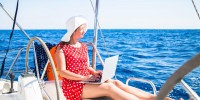
Free Sailing Resources

How Far Can You Sail In One Day?
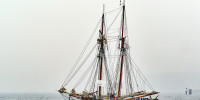
How Much Fuel Does a Sailboat Use?
20 Must-Have Sailing Accessories

While some sailing accessories are simply nice to have, others are a must if you want to have a safe and enjoyable sailing experience. From safety equipment to navigation systems and communication devices there are must-have sailing accessories.
Leaving the dry land and going sailing is, without a doubt, a lifetime opportunity. But you can only stay safe and enjoy this opportunity if you outfit your sailboat with the right accessories. While you'll hear a sailor saying he/she can't go sailing without a plumbed-in washing machine, we aren't sure if this is a must-have accessory. But going out there on a sailboat that doesn't have a wind vane self-steering gear is unthinkable. Although we all have our eccentricities, there are several accessories that you shouldn't even think about sailing without.
Sailing, of course, requires preparation, training, and practice. While accessories such as life jackets are a must-have in any sailboat, there are other must-have items that you should always have before setting out. These accessories are critical not just for safety purposes but also for an enjoyable sail.
This article, therefore, provides a handy guide to the 20 must-have sailing accessories that you should have before going out there on the water.
Table of contents
Safety Equipment
How do you escape from the sailboat should the worst come to you? Well, life raft becomes the order of the day. This is essentially a type of lifeboat that must be carried in the sailboat for emergency evacuation purposes if there's a disaster on the sailboat. Keep in mind that a life raft is a lot easier to launch than a lifeboat. This is because a life raft is designed with an auto-inflatable system, so you won't have to launch it manually.
When choosing a life raft, a rule of thumb is that the life raft should be big enough to carry more people than the sailboat typically carries. For instance, if you have a six-person sailboat, the life raft should be able to carry 8 people. Make sure that the life raft has a hydrostatic release and is kept on the deck where it can be easily accessed when there's an emergency. More importantly, make sure that the life raft is regularly serviced so that it doesn't work with a hitch.
This bag should contain all the important emergency supplies that you can take with you in the life raft. In addition to being waterproof, the grab bag should be able to float and have interior pockets where you can keep safety items. You can also add a lanyard that makes it impossible to lose the bag even if the life raft capsizes.
A grab bag is a perfect place to store all your essentials including the survival gear, vessel's signaling, medical kit, spare battery pack, flashlights, SOLAS flares mobile phone, EPIRB, and many more.
- 406 MHz EPIRB
Connected to a global satellite network, an EPIRB (Emergency Position Indicating Radio Beacon) is a small radio that can be used worldwide to alert Search and Rescue agencies about an emergency in the seas. For instance, you can use the EPIRB to alert the agencies that your sailboat is sinking.
The EPIRB is one of the most important safety items when sailing. When buying this device, you can look for an upgraded model that comes with a built-in GPS. This is essential in the sense that your position can be instantly transmitted to a nearby rescue agency. You should always keep the EPIRB in the grab bag in case things go wrong.
- Handheld VHF Radio
This is an excellent backup to the boat's VHF radio. This is because a handheld VHF radio is independent of the boat's antenna and DC system. As such, it makes sense to have one in the grab bag but do not forget additional alkaline batteries.
Some of the best handheld VHF radio models to consider include Standard Horizon and West Marine. You should keep in mind that some models can float if thrown overboard. Such models have several features such as an integral GPS receiver with full Digital Service Calling (DSC) safety features.
- SOLAS Grade Signals and Flares
Any sailboat that's going out there on the water must have SOLAS grade signals. These flares are of great importance when you want to give out a signal and call for help when disaster strikes. You should have handheld red flares as well as rocket parachute flares and at least two orange smoke canisters for daytime signaling.
It's always advisable to have at least a pair of the red, rocket parachute, and orange flares with you. You can consider placing one each in the cockpit while keeping the rest in the grab bag. You should always remember that SOLAS flares are a very powerful way of sending out signals, so you must be very cautious when using them. In other words, don't just use them; use them only when you're in serious help.
- Emergency Watermaker
Having SOLAS flares and the EPIRB will, of course, increase the likelihood of having a quick rescue but what happens if the rescue doesn't come as fast as you had thought? Well, you should have an emergency Watermaker. This is essential in producing enough fresh water that can keep nearly 24 people hydrated for days on end.
- Radar Reflector
This is an important accessory while sailing in the sense that it's what alerts other vessels, both big and small, of your presence. Although these radar reflectors may vary greatly in their performance, you should use something that's effective such as Trilens and Echomax reflectors.
Most ships out there generally use a 24-mile scale on their S-band radar but such radars are unlikely to notice a small craft in their radar reflectors until they're within a range of six-mile or less. This means that these ships can sometimes detect your sailboat when it's a little too late. As such, you shouldn't take chances. Instead, use your radar reflector and detect whether there's a huge ship or any other vessel, for that matter.
- Portable Fire Extinguisher
You should have several portable fire extinguishers to help the crew fight fire. The locations of these fire extinguishers should be clearly labeled to make sure that everyone is familiar with their locations and how to operate them.
- Patching Materials
There are certain instances when your boat may suffer from collision or any damage that may put a dent on your hull. Without appropriate patching materials, this may spell doom as there will be a constant flow of water on the deck.
You should, therefore, have patching materials that can help you prevent water from flowing into the deck, thereby allowing for emergency repairs. Some of these patching materials include underwater-cure epoxy putty and pre-cut pieces of waterproof plywood.
- Throwable PFD
Whether it's a horseshoe buoy, a throw rope bag, or a rescue stick, a sailboat must have a lifeline sling that can be used to save someone in the water. Some of these devices throw well for long distances and with good accuracy and can be used to provide flotation. Most of these devices remain connected to the vessel, which makes it a lot easier to pull the victim out of the water and to the boat.
Medical Equipment
- The Boat's Medical Kit
A medical is a must-have accessory in any sailboat. It should have partitions with each partition meant for a particular class of injury. The kit should also be readily available to the crew and have common drugs, bandages, and a first-aid kit. It should have sunscreen, common painkillers, tweezers, bandages, and many more.
Additionally, you should also get a doctor to write prescriptions for non-OTC. You can as well consider using a telemedicine service that can help you in case of a serious emergency.
Personal Equipment
- Inflatable Life Jackets
This is a personal safety gear that's not only comfortable to wear but will also offer great performance in the water. When used together with safety harnesses, you'll have a single piece of gear that has nearly all the safety gear that you need on the deck.
Inflatable jackets are great especially on the open water and should also be available for guests and everybody on the boat.
- Safety Harnesses and Tethers
Although safety harnesses and tethers may be too heavy or too hot to wear especially in warm climates, they're of great importance in keeping you safe should things go wrong. It's advisable to integrate them with inflatable life jackets and must be worn in almost all conditions. In fact, it would be appropriate if you make them mandatory on the deck.
You should make sure that the tethers do not have hooks that can accidentally unhook and cause injuries. The safety harness should also have an easy-to-release snap shackle at the chest.
Sailing requires foul weather gear just the same way a corporate business director requires a three-piece suit. Don't just buy any gear. Instead, go for a quality gear that fits lightly and can allow you to put shielding garments beneath. The fabric should be breathable for additional comfort. Some of the brands to consider include West Marine, and Henri Lloyd.
Part of this gear should include fleece jackets and pants. Fleece garments are excellent in providing warmth and cushion and shouldn't be bulky. They are also great for sleeping during long passages. You should also have long underwear to keep you from freezing. You should go for a synthetic material. Something like polyester or polypropylene fabric is appropriate. This is because such materials can cling to your skin, thereby transporting moisture away from your skin. That being said, you should never use cotton or any other natural fiber.
- Deck Shoes , Hats and Gloves
Nothing arguably ruins a fascinating sailing trip than a broken ankle or foot. It doesn't matter the type of shoes that you prefer, you must have shoes with better grip while on the deck. This is not only to secure your feet but also to prevent you from skidding, which can cause serious injuries.
While a hat may make you look like a dork, it's of great importance in protecting your head and face from sunburn and also from insects at night. Floppy canvas hats are the best thanks to their wide brim but you can also use baseball caps for extra protection.
You should also have line-handling gloves to protect your hands from wear and tear. The gloves should be manufactured from either synthetic or genuine and should remain flexible even after several exposures to saltwater soaking. They should also be waterproof to keep your hands warm.
Electronic and Communication Gadgets
- Shortwave Receiver
You should get a quality Sony, Sangean, or Grundig receiver that can work with WFAX software as a shortwave receiver. You can also choose an SSB (Single Sideband) radio as a shortwave receiver, though it will drain the battery banks quickly as it tends to draw a lot of currents.
- Spare Antenna
Although they don't have to be elegant, they're of great importance particularly if you lose your mast. There are many affordable models out there, so you can't lack something that can work for you.
- VHF Marine Radio, Antenna
This is one of the most important communication devices on a sailboat and can enable you to communicate clearly for up to 60 miles. You can use a base-loaded stainless steel whip with antennas at the masthead. They also offer remote stations as an option and are like large microphones. This is to allow you to have full-power radio that's accessible from the helm while the main radio remains at the navigation station.
- Weather Map Solutions
Good weather is of great importance if you want to enjoy safe sailing. While the Furuno FAX207 used to be the standard device on most sailboats, you can now use a laptop, an iPad, or a Xaxero.
This can work in tandem with a fixed mount network GPS that can be used to perform many tasks. The model that you choose should have a large and sharp display, as well as a good interface.
- Depth Sounder and Knot Log
Speed and distance are some of the most important navigation information. You should use a knot log to measure speed and distance and use depth sounder to measure the depth to avoid unintentional grounding while enhancing safe sailing and navigation.
- Main Compass
This is to ensure that you can know the latitudes and, of course, the direction that you're traveling at.
Whether you've been sailing for decades of just starting out on this incredible adventure, preparation is key to safe and fun sailing. Part of this preparation is being aware of all the must-have accessories that you should have in your boat. Hopefully, you're in a much better position as far as must-have sailing accessories are concerned.
Related Articles
Daniel Wade
I've personally had thousands of questions about sailing and sailboats over the years. As I learn and experience sailing, and the community, I share the answers that work and make sense to me, here on Life of Sailing.
by this author
Personal Health and Gear
Communication
Emergencies
Most Recent

What Does "Sailing By The Lee" Mean?
October 3, 2023

Best Sailing Duffle Bags: Top Picks For Boat Travel
September 27, 2023
Important Legal Info
Lifeofsailing.com is a participant in the Amazon Services LLC Associates Program, an affiliate advertising program designed to provide a means for sites to earn advertising fees by advertising and linking to Amazon. This site also participates in other affiliate programs and is compensated for referring traffic and business to these companies.
Similar Posts

The Best Sailing Schools And Programs: Reviews & Ratings
September 26, 2023

How To Choose The Right Sailing Instructor
August 16, 2023

Best Sailing Racing Electronics
July 5, 2023
Popular Posts

Best Liveaboard Catamaran Sailboats
December 28, 2023

Can a Novice Sail Around the World?
Elizabeth O'Malley
June 15, 2022

4 Best Electric Outboard Motors

How Long Did It Take The Vikings To Sail To England?

10 Best Sailboat Brands (And Why)
December 20, 2023

7 Best Places To Liveaboard A Sailboat
Better Sailing

Cruising Sailboat Equipment Essentials
There are hundreds of marine accessories available in the market that are necessary to keep on board. Some of them are just an add-up to your sailboat’s design or some extra features but others are must-haves and provide you with safety and comfort. Remember that over time, you can gather many accessories in your sailboat without even noticing! Sailboats are comprised of different parts so you might find yourself buying or even finding some of these parts before realizing that you actually needed them. Let’s now see the detailed list with some useful “must-haves” accessories to equip your sailboat with!
Household Accessories
- Refrigerator : A refrigerator is not always a must-have item when you’re not constantly cruising and you stay on the anchor to a marina for a long time. But, if you’re living on your sailboat or traveling overseas then a refrigerator is a must! Food is important when traveling at sea and most products, as well as cooked meals, need a refrigerator to be well-preserved. A freezer might also be a practical item if you’re planning on cruising the seas for a long time period.
- Cooker : As a matter of fact, cooking at sea involves some risk. That’s why a cooker might be a worthy investment for you in order to better handle liquids or hot metal utensils and in general processing or cooking food. If you decide to buy a cooker then remember to prefer a well-constructed cooker, that will serve you for years.
Safety Accessories
- Boarding Ladder : The ladder is a handy accessory suitable for swimmers but also for anyone that wants to easily and safely get aboard your sailboat. The ladder’s material is stainless steel and locks to the transom or hooks over the toe-rail. Also, if you’re traveling with your dog companion then a ladder will help him come aboard safely.
- A set of Storm Sails and a Sails Repair Kit : A storm trysail and a storm jib are practical if you’re an overseas sailor. They’re important because in case that an emergency weather situation occurs, these sails will keep you safe. A Sails repair Kit is considered a must-have on most sailboats so don’t forget to buy a fully-equipped one before setting off.
- First Aid Kit : Always make sure to have a first aid kit as well as a waterproof grab bag. These two will contain all medical and safety equipment that you’ll need in case of an emergency. The kit should contain common drugs, bandages, antiseptics, and sterile tools, among others.
- Patching Materials : These materials can help you prevent water from flowing into the deck and are more than useful for any emergency repairs. The most essential materials are epoxy putty marine and pieces of waterproof plywood.
Safety Equipment
- EPIRB (Emergency Position Indicating Radio Beacon) : An EPIRB is a radio that connects to a global satellite network. You can use it in case of an emergency in order to alert Search and Rescue agencies. It is by far one of the most important safety items to keep onboard. When buying it consider looking for an upgraded model that comes with a built-in GPS.
- Radar Reflector : This item alerts other vessels about your sailboat’s course. The performance of these radar reflectors varies so consider using Echomax and Trilens reflectors. In general, most boats use a 24-mile scale on their S-band radar but unfortunately, these radars only notice small crafts within a range of six-mile or less.
- SOLAS Grade Signals : These flares and signals are important in case you want to call for help. You need to have handheld red flares, two orange smoke canisters, and rocket parachute flares. Generally, SOLAS flares are the best solution if you want to send out signals. Thus, you must use them only if you’re in a real emergency situation.
- Portable Fire Extinguisher : Fire extinguishers are also a must-have safety item in your sailboat. Make sure to place them in an easy-access location and put labels with instructions on them in order to operate them safely.
- Life Raft : It’s always better to predict the worst-case scenarios. Generally, a life raft is much easier to launch than a lifeboat. Moreover, the life raft’s design has an auto-inflatable system, so there’s no need to launch it manually. Also, it’s advisable that you choose a life raft that is equipped with a hydrostatic release.
>>Also Read: Must-Have Sailing Equipment
Electronic Accessories
- VHF Marine Radio : This communication device allows you to communicate for up to 60 miles. Moreover, the antennas offer the option of remote stations thus allowing you to have full-power radio. This radio is accessible from the helm and the main radio remains at the navigation station.
- Depth Sounder and Knot Log : The knot log helps you measure distance and speed which is a vital element for navigation. Depth sounder measures the depth and like this, it helps you avoid grounding and ensures safe navigation.
- Compass and an Extra Antenna : Both items are particularly important to have while sailing on long passages.
- Solar Panel for Back-Up Power : A solar panel can be the best piece of emergency equipment you can buy in case your batteries die. Generally speaking, the sailboat uses more battery than a car because it has more devices and systems running. If you decide to buy a solar panel make sure to make a good purchase, don’t buy one that overcharges your sailboat’s battery.
Personal Accessories
- Sanitation System : Marine holding tanks as well as other portable toilet systems are more useful than permanent and manually pump sea toilets. They’re quite easy to install, have a removable tank, and are far more “green” than permanent toilet systems.
- Inflatable Life Jackets and Tethers : This is personal equipment that ensures safety and is a definite must-have item on board. These life jackets along with safety harnesses form the top-one piece of gear. Make sure that the tethers do not have hooks on them and have a snap shackle at the chest. Sailing requires full weather gear, so it’s of great importance to have all necessary equipment on board.
- Gloves, Shoes, Hats : Line-handling gloves are designed to protect your hands from wear and tear. The gloves you’re going to choose to have to be waterproof, flexible, and made out of synthetic material. Shoes are also important because they provide safe grips while on the deck. Last but not least, consider buying a floppy canvas hat that ensures face protection from the sun.
- Dock Lines and Fenders : Dock lines are essential when it comes to fixing your boat to the dock. You will certainly need dock lines on the sailboat if you’re tying up on an unknown dock. Fenders can also be particularly useful when tied off to large walls or obstacles. It is advisable to be equipped with at least two for the front and the back of the mooring site.
Cruising Sailboat Equipment Essentials – Conclusion
Traveling overseas with your sailboat is a great adventure and a lifetime’s experience! But always remember that preparation is the key for this type of voyage and that there are essential gears to keep on board. Accessories such as life jackets, first-aid kits, and safety equipment are a must-have in any sailboat, but there are other must-have items that you should consider buying before setting off. The most important ones are a refrigerator, a compass, a VHF Radio, patching materials, a sails repair kit, and others. As listed above, this equipment is a must-have while you’re cruising.
However, this is not an all-encompassing list but a general list. Accessories and equipment are based on your needs, your course, and your sailboat. A good way to understand the needs of your sailboat and its maintenance is to check its manual. The manuals normally contain a list of the basic tools and additional equipment needed if a problem arises. If you’re well-prepared you can assure that you’ll safely enjoy your sea voyage and deal with any possible difficulties.
Peter is the editor of Better Sailing. He has sailed for countless hours and has maintained his own boats and sailboats for years. After years of trial and error, he decided to start this website to share the knowledge.
Related Posts

Atlantic vs Pacific: Which is More Dangerous for Sailing?

Why Do Sailboats Lean?

How Does a Boat Sail Upwind? Unveiling the Mechanics of Against the Wind Sailing

How Does Sailing Work? The Physics of Sailing
- Buyer's Guide
- Destinations
- Maintenance
- Sailing Info
Hit enter to search or ESC to close.
Yachting Monthly
- Digital edition

The tools and spares you shouldn’t sail without
- Rachael Sprot
- December 7, 2022
Give a thought to your inventory this winter to keep you cruising next season, says Rachael Sprot as she takes you through the tools you need on a boat

Carrying a decent set of spares and tools gives you independence and extends your cruising range. Credit: Rubicon 3
How many 13mm spanners does a girl need in her tool box? Well, at least four it turns out.
We were a halfway across the Atlantic bound for St Lucia on our Clipper 60, Bluejay , when the flexi-coupling on the generator failed.
The crew consisted of me and a professional first mate and eight amateur sailors of mixed ability.
Engineering fell to me, and in this instance, I needed two 13mm spanners.
Lucky I set off with three then isn’t it?
The unfortunate thing about luck is that it runs out.
WERA JOKER COMBINATION RATCHET SPANNER SET WITH OPEN-END 11 PIECES
The ratchet end of these high quality spanners can be the difference between being able to undo something in a tight space and not.
excellent quality spanners, these come in a roll, which keeps everything neat and easy to find.
Buy now from Screw Fix

Have more than one set of key tools you couldn’t do without. Credit: Rubicon 3
The first one had disappeared over the side early on in the voyage.
When the second one clattered into the bilge of doom I was left with my third and final spanner and the dreaded adjustable wrench – and so a 10-minute job became a half-day affair.
To add insult to injury I had two 14mm spanners in the wrap winking at me mischievously.
‘It’s all right for you,’ I muttered, ‘you’ve never done a day’s work in your life.’
Of all the things I worry about when setting off for the season, the inventory is one of the foremost in my mind.
Offshore cruising has a way of helping you recognise what’s important in life, salient spanner sizes included.

Replacing a worn kicker swivel block on an ocean passage. Credit: Rubicon 3
At Rubicon 3 our vessels carry everything from epi-pens to angle grinders yet somehow there’s always an item that you didn’t know you needed until it’s too late.
My initial attempts at setting up the fleet inventory were a bit like Supermarket Sweep: you end up with a trolley load of buy-one-get-one-free offers but no chopped tomatoes.
It has taken time to refine and improve it.
Slowly each item on board has been weighed against three criteria: how critical it is; how likely it is to fail; and how hard it is to come by.
Continues below…

Best cordless power tools for boats
Best Cordless Power Tools for boats – and nifty accessories Sooner or later, no matter how competent or incompetent you…

The best multitool for boating: 10 tested
A multitool is a toolkit in your pocket for when you need it the most. The Yachting Monthly team put…

Best boat knife – 11 options tried and tested
The best boat knife will be a life saver and a constant sailing companion for years to come. Make sure…
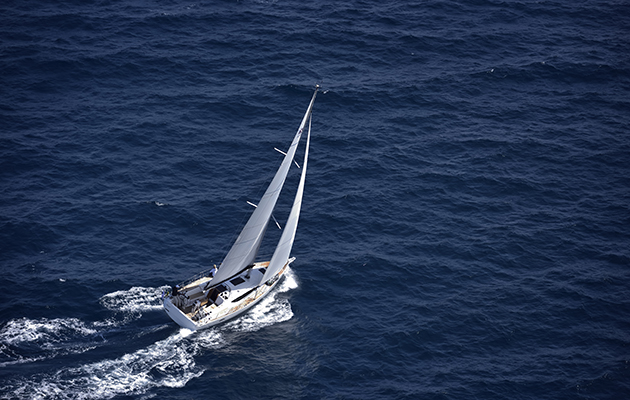
Offshore sailing skills: All you need to know
Will Bruton finds out what coastal cruisers should consider before taking their small yacht on an offshore adventure
Critical systems
The secret to cruising is that you can do without most things once you’re out there.
For many critical systems you can’t carry a spare anyway – like your standing rigging or your rudder.
But there are lots of things you wouldn’t leave without in the first place, and these are the things that you need to identify.
Sure you can cross the Channel without your loo if you have to, but you wouldn’t carry on and explore Brittany on a bucket and chuck it policy.
Don’t just think of your inventory in terms of what might go wrong at sea, think of what will stop you putting to sea in the first place.

The difference between carrying a spare impeller and a whole service kit. Credit: Rubicon 3
Identifying critical systems is easier said than done though.
The main engine is universally essential, but most yachts also rely heavily on electrics and electronics.
Domestic systems are often overlooked in the process of identifying critical spares.
Could you cope without your fridge, oven or running water for a week?
We now carry spare gas regulators (they always fail in a closed position – safe but annoying), fridge thermostats and a fresh water pump as their failure has a huge impact on life on board.
Preparing for gear failure
With our fleet of expedition yachts covering around 60,000 miles each year between them, we’ve learnt the hard way which systems are likely to fail.
They broadly fall into two categories: things that should or shouldn’t move; and things that should or shouldn’t be wet.
Things that should move
Anything which has moving parts can eventually wear out. Pumps and electric motors are two of the most common pieces of equipment to fail.
A seized electric motor isn’t serviceable at sea, so we carry spares and swap out the whole unit.
It can be expensive investing in spare water pumps, starter motors and alternators, but if you’re cruising remotely you’ll save money in the long run by not shipping parts around the world.
The rubber parts of diaphragm pumps will also degrade over time, becoming brittle.
Things that shouldn’t move
There are many things on board which aren’t designed to move, but that with time, corrosion and frequent loading and unloading become loose.
Deck hardware , spars and standing rigging are often susceptible to crevice or galvanic corrosion.
These items are expensive and difficult to replace so your best approach is to maintain them well, ensure that you have redundancy in the system and carry materials for jury-rigging.
Having a supply of soft shackles and a length of Dyneema will provide a short-term solution to many issues.
Chafe is always an issue. A spare halyard could be used for many different jobs.
Hoses and electrical cables in engine bays are often damaged too.
A cheap hose connector can be used to join damaged sections and lengths of electrical cable could get you out of trouble.
Things which should be wet
Any impeller-driven pump needs to run wet.
A blockage on the inlet will result in a shredded impeller, so spares are essential.
Wherever possible, we carry the full pump service kits.
These include paper gaskets, spare cover plate screws in case you drop one in the bilge and a seal kit, as well as the impeller .
Other things needing lubrication include windlasses, winch parts, the stern gland and rudder bearings.
You can’t always carry spares for these but regular servicing will identify parts which need replacing before they fail.
Things which should be dry
The biggest cause of electrical failure on a yacht is corrosion from the damp, salty environment.
There’s only so much we can do about this once we’re out there: the time when you notice your deck fittings are leaking usually isn’t the time to start re-bedding them.
You need a good supply of cable terminals, waterproof grease and (dare I say it?) duct tape, so that you can stem a leak and make good any corroded connections until there’s an opportunity for a longer term fix.

Domestic systems like the oven and gas supply are easily overlooked. Credit: Rubicon 3
It helps to follow this process when identifying critical spares:
Methodically consider each system on board.
Decide whether you would carry on cruising if it failed.
This is quite personal, and one person’s ‘essential’ will be someone else’s ‘luxury’.
Consult the manual for your critical systems, identify which parts could fail and which spares you want to carry.
Which tools & spares do you really need?
Sometimes it’s not economic or practical to carry spares.
If you’re selecting a yacht for long-distance cruising you need to look for redundancy in areas where you can’t carry spares: paper charts and a hand-held GPS in case your chartplotter fails; beefy chain plates and spare mast-head halyards to replace standing rigging; ways to charge your batteries should your engine fail.
Some items on board are almost impossible to source in the average chandlery.
The more expensive engine spares are one of them: alternators, starter motors, head gaskets.

Domestic systems for cooking and heating can be equally as important as mechanical systems. Credit: Rubicon 3
They may not be things you’d replace yourself, but they are things that a good mechanic could fit for you, as long as you can provide the parts.
It’s easy to forget the accessories which make up the whole job, focussing on the big-ticket items.
If you’re changing out an injector you also need to replace the copper washer which it sits on.
Wherever possible carry the spare part and its accompanying accessories like O-rings and gaskets.

Starter motors and alternators are a fairly common source of failure. Credit: Rubicon 3
It’s worth having a supply of emergency ‘bodge it’ items like plywood, Sikaflex, epoxy and fibreglass matting.
Underwater setting epoxy is particularly useful, for obvious reasons…
If you’re cruising remotely ask your local GRP specialist to put together an emergency pack for you.
The spares you carry need to reflect what’s available on shore.
In the Solent you can source most things within 24 hours; in Northern Europe, the Med and the Caribbean you’re never too far from a good chandlery, but it may be a few days away.
Once you venture further afield to the high latitudes, South America or the Pacific you need to be much more self-reliant.
To help you identify which spares you need, we’ve grouped them by three areas: coastal, where you have good facilities ashore; offshore, where you may be a few days away from support; and remote, where it might take weeks for parts to arrive.

Double up on important spanner sizes such as 8, 10, 13 and 17mm. Credit: Rubicon 3
The most important thing you carry isn’t your spares, however.
It’s your tool kit and your skillset – without them many of your spares will be useless.
Invest in the right training and equipment and it’ll save you time and money in the long run.
If there’s one thing I’ve learnt about the inventory though, it’s that it will never be complete.

Rachael Sprot is a Yachtmaster ocean instructor and director of Rubicon 3, the offshore yacht sailing school
We can never carry everything we need for all the disasters we might face, but ingenuity and imagination will often provide what our stores cannot.
After all, the wisdom of the inventory is not knowing what we do need but removing what we don’t.
Anything superfluous makes the important stuff harder to find.
Sailing is an exercise in minimalism: consciously and unconsciously when we set off from land we’ve already made the edit.
There’s no room for sentimentality on board, we take with us what we need.
So start your tools and spares inventory by making a pile of what you don’t need and you’ll start to see what’s important.
I’m starting with those 14mm spanners.
Spares checklist
Engine & generator:
Fuel filters Belts Impellers Oil filters Relays and fuses
Hose repair kit
Rigging and sail repair:
Shackles Needles and sailmakers palm Waxed thread Length of webbing Adhesive sail repair patches
Electrical:
Selection of fuses Cable terminals and crimpers Cable ties Navigation light bulbs Cabin light bulbs
Dinghy and outboard:
Dinghy repair kit
Consumables:
WD40 Duct tape Sand paper White spirit or other thinners
Fuel lift pump Length of spare fuel hose (for jury rigging into a jerry can) Raw water pump service kit
Heads service kit Bilge pump service kits Hose connectors and jubilee clips for common hose sizes (1/2”, ¾”, 1”, 1 ½”) Grey and black water pump/ macerator service kits Push fit connectors and fittings if plumbed with rigid pipe
Gas regulator
Mainsail sliders Soft shackles 2-3m of Dyneema
Selection of wire in various sizes Shore power plugs and connectors Choc-block connectors Fuses for all electrical equipment
Spark plugs Fuel filters
Sikaflex Marine grease Rust penetrant spray Anti-corrosion compound (Duralac)
Starter motor Alternator Comprehensive gasket kit Injectors and washers Propeller Engine mounts
Spare fresh water pump Spare Grey and Black water pumps Length of hose for each essential system, normally: ½”; ¾”; 1”; 1 ½” Selection of through hull fittings and ball valves
Cooker and hob valves and thermostats Fridge and freezer thermostats Heater glow plugs and filters
Large piece of Dacron cloth Halyard-length of line Swivel and snatch blocks
Spare inverter Coax cable connectors Spare battery terminals Length of battery cable, crimp connectors and large crimpers
Water pump service kit Oil filter O-rings and gaskets for draining oil
Corrosion-guard spray GRP repair kit Epoxy
Tools checklist
Hand tools:
Screwdrivers Spanners and adjustable wrenches Basic socket set Allen keys Pliers Oil filter wrench Hacksaw and blades Stanley knife and blades Tape measure
Electrical kit:
Multi-meter Crimper Side cutters
Power tools:
Drill and drill bits
Small electrical screw drivers Double up on key spanner sizes Comprehensive socket set Torx set Mole grips Files Mallet Rubber mallet
Heat gun Work lamp
Taps, dyes and helicoil sets for common sizes Extra large adjustable wrench Stilsons Wire brush selection C Clamps & Vice Vernier calipers
Soldering iron and flux
Angle grinder and cutting discs Jigsaw Gas powered blow torch

9 Helpful Things You Need in Your Sailboat Tool Kit
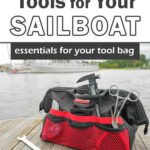
As an Amazon Associate, we earn from qualifying purchases. We also earn from other affiliate websites. See our full disclaimer .
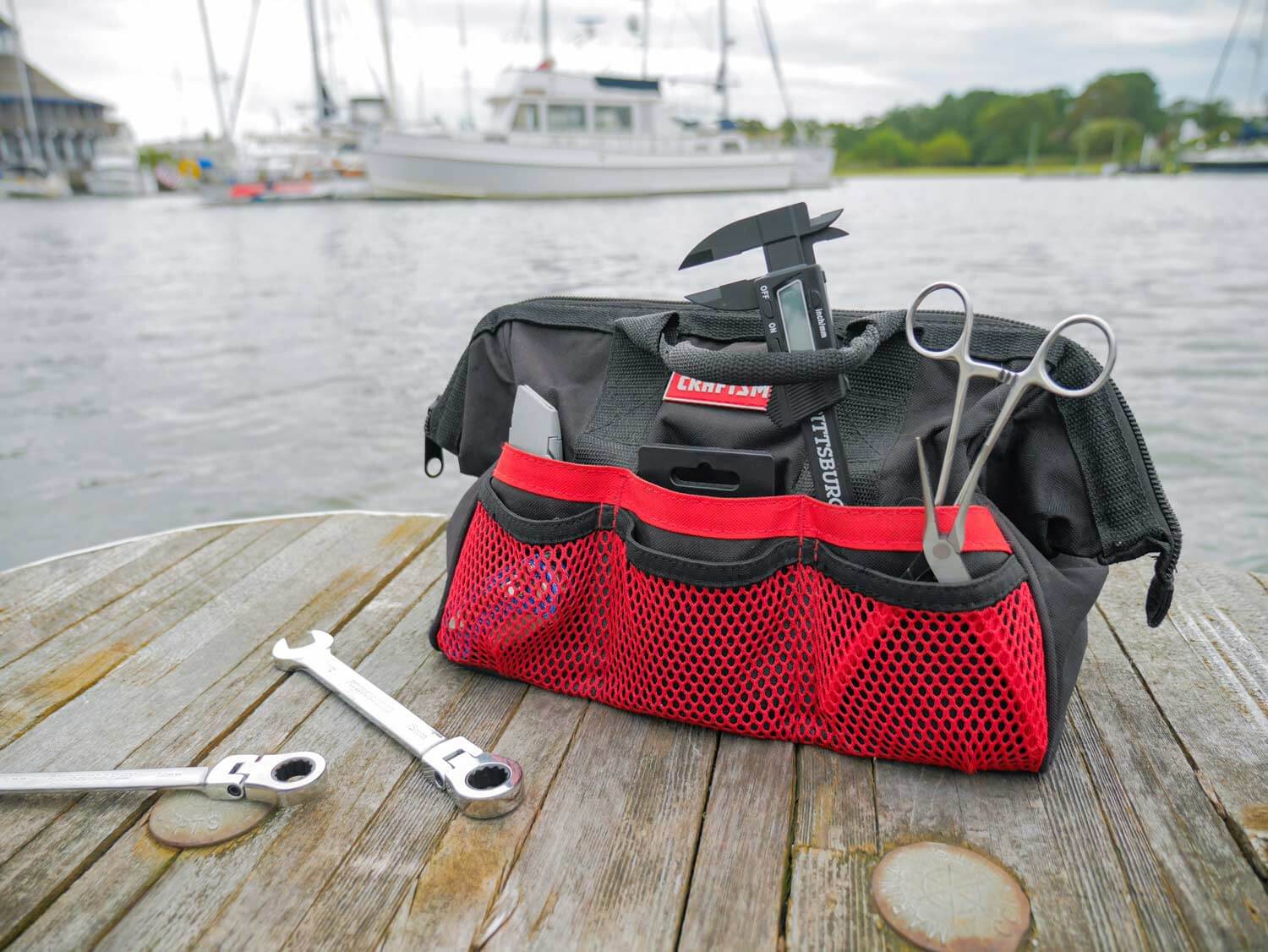
If there’s one thing all boaters can agree on, it’s that boats break… a lot. What’s in your sailboat tool bag will determine how challenging your projects are and how long they’ll take.
We are DIYers. What’s in our tool kit helps us become our own mechanic, electrician, and plumber.
If you plan to do your own work, this list will ensure you have the right tools for the job.
What You’ll Find on This Boat Tool Kit List
The items below are in addition to your standard boat repair tools, such as screwdrivers, hammers, and wrenches. This list is for things you wouldn’t find in an average tool bag. They are more boat specific and helpful for reducing time, effort, and strain on your body.
Here are nine additions to your sailboat tool kit to help your projects go quicker and smoother.
1. Hemostat Set
You might recognize these instruments from your favorite medical drama, but they also pull their weight on a boat.
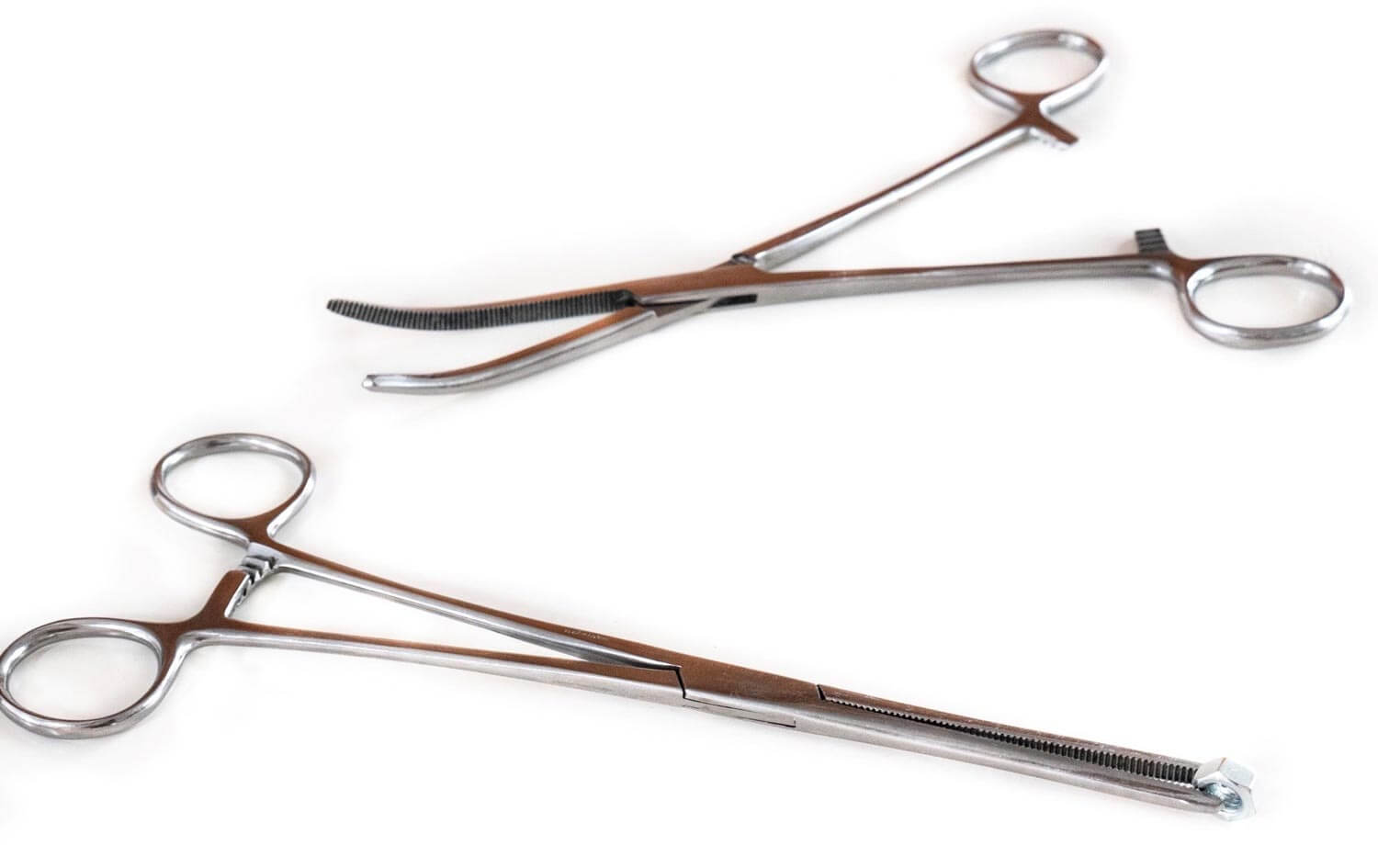
Made in both a straight and angled serrated tip, they are ideal for precision control of objects. The self-locking clamp makes for easier work in tough spots (basically everywhere on a boat).
Uses for Hemostats
- Includes curved and straight 7-inch clamps
- Locking tweezer clamps
- Features 3 locking positions
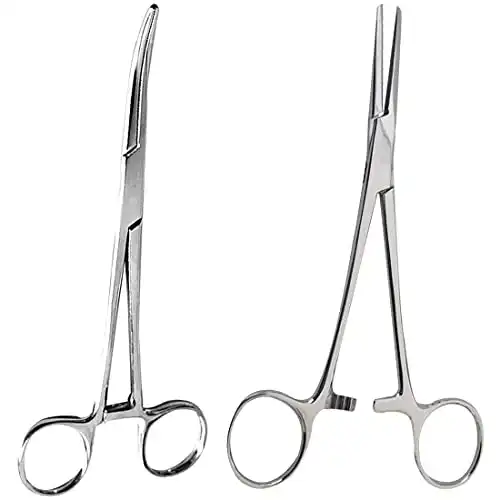
BONUS: These are stainless steel, so they’ll hold up great on a boat.
These hemostats are a versatile item in your marine tool kit you’ll always want to have handy.
2. Compressed Air
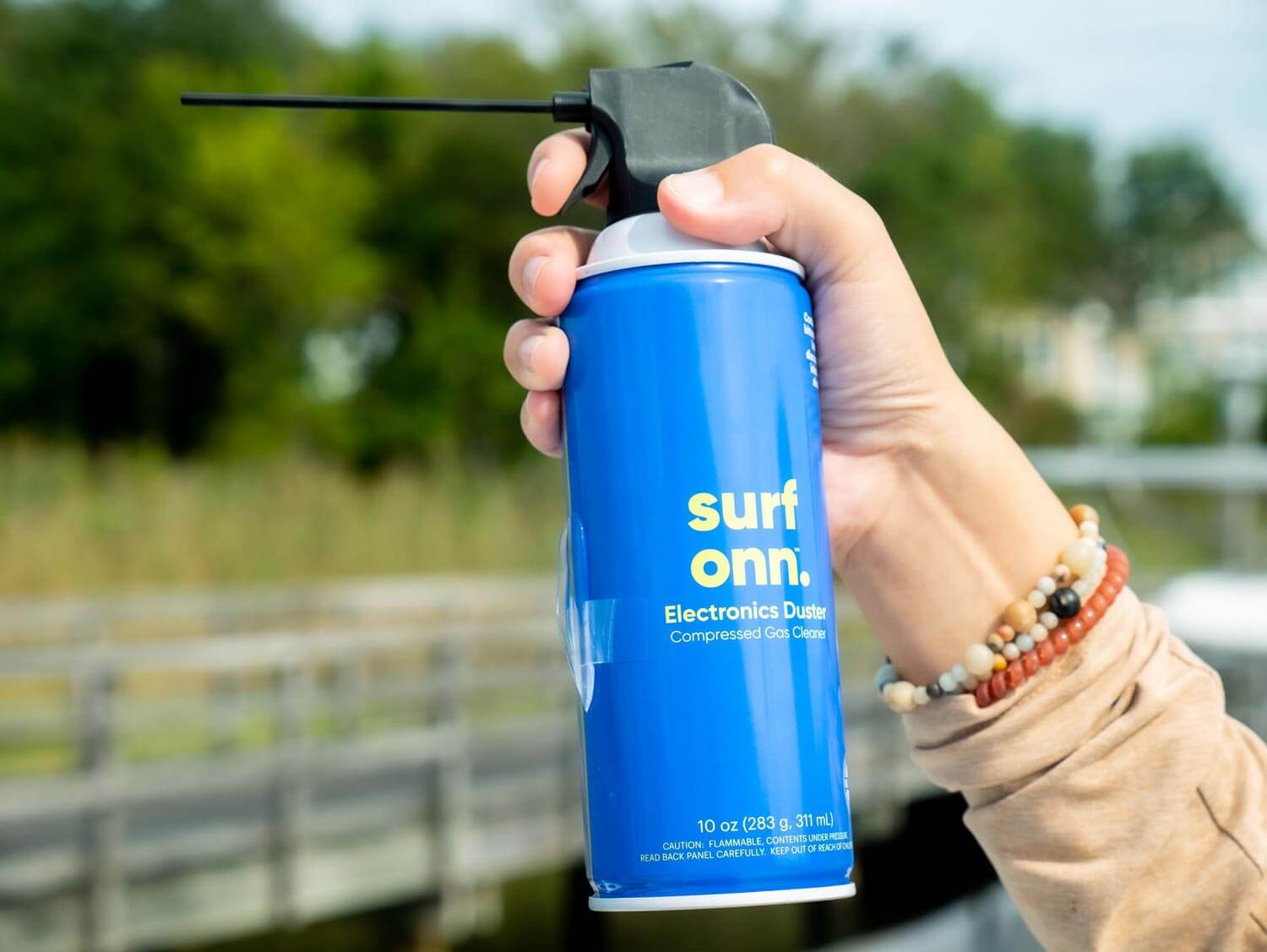
Compressed air is our most used cleaning product on the boat. We always buy this compressed air in packs of four because we go through it so quickly.
Uses for Compressed Air
- Identifying a hose – spray the air through one end and have a person on the receiving end determine which hose the air is coming out of
- Cleaning various boat parts – this is especially good for cleaning out a bolt or screw hole to prevent thread damage
- Blowing dirt out of hard-to-reach places where a rag doesn’t fit
- Useful for saving your water supply for things you can clean with air instead of water
BONUS: This stuff is great for cleaning out beard and hair trimmers.
3. borescope camera.
This unique tool allows you to see all the mystery spaces on a boat. Anything you can’t get into or inside the borescope camera can help.
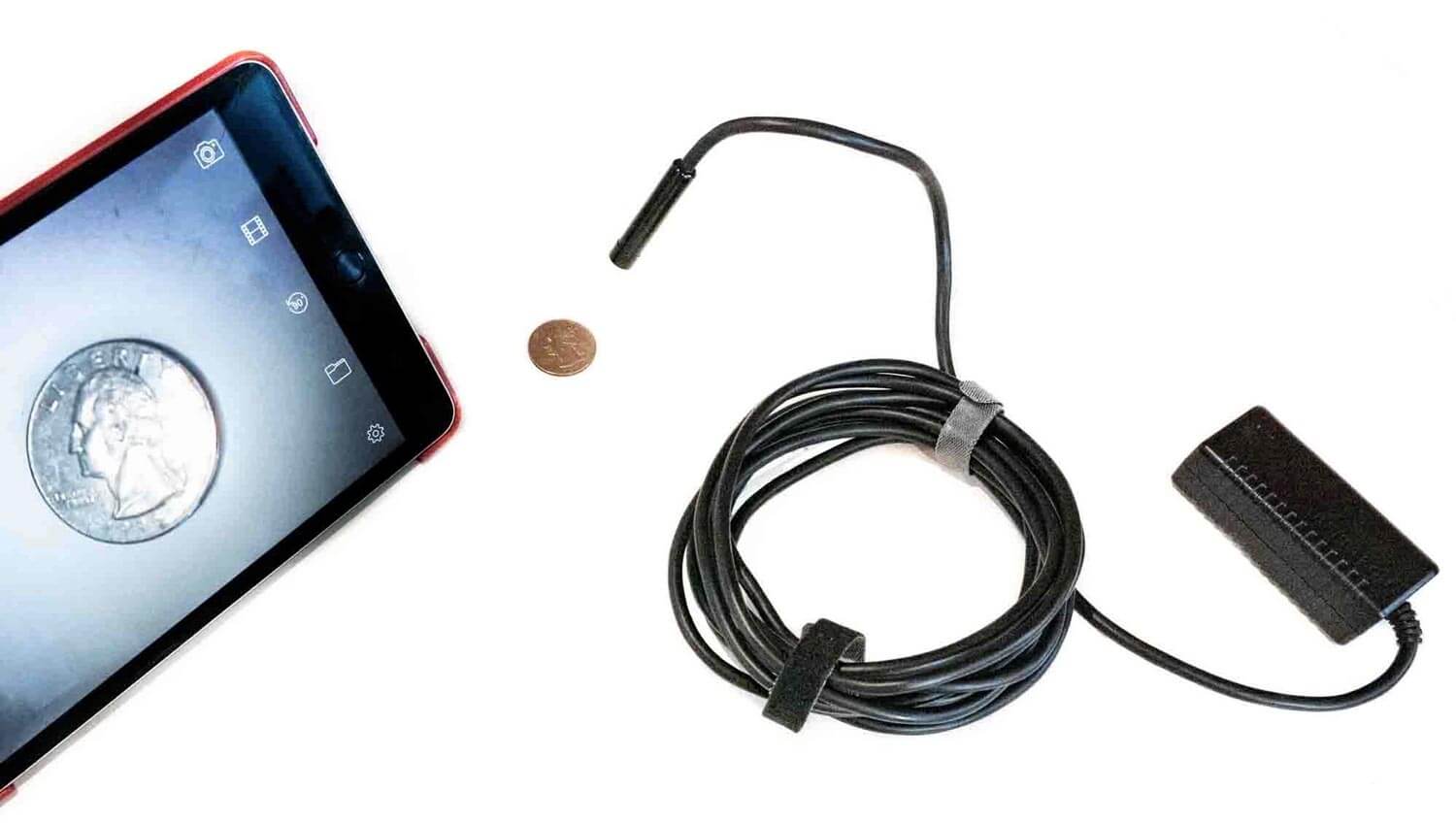
How It Works
The borescope camera connects to your tablet or phone via WiFi. Insert the end of the borescope into the area you can’t get to and watch your mobile device for a live view of the area. You can also take pictures or videos to review later.
The waterproof camera, along with an LED light, allows you to get a view of the unreachable area. The hook and magnetic attachments give you the option of retrieving wires, metal, and foreign objects.
Uses for Borescope Camera
Because we love this tool so much, here are a few real situations where this tool has been a lifesaver.
- Found and removed clogs in the cockpit drain that had been plaguing us for months
- Retrieved wind transducer cable from inside the mast
- Inspected the inside of the sail drive housing and discovered a pin had fallen out – retrieved the pin so it wouldn’t cause damage
- IP67 waterproof
- WiFi accessible via Android and iOS Smartphone, iPhone, iPad, Samsung
- 11.5 foot snake camera cord
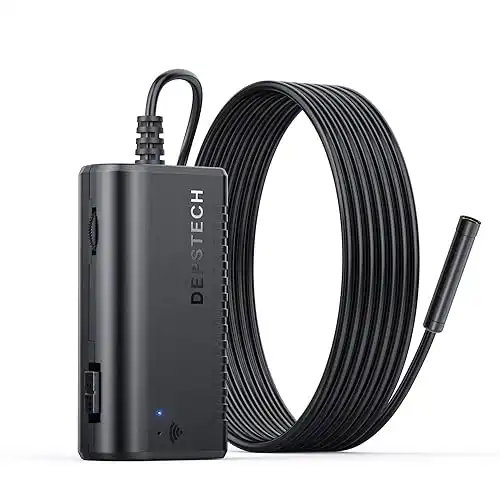
Here is the WiFi-enabled borescope we purchased. We use this tool less frequently, but when it’s needed, it can be incredibly helpful.
The borescope also made our list of the Best Useful Gifts for Sailors .
4. Ratcheting Box End Wrenches
Marine engine bolts and nuts can be difficult to access. The ratcheting box end wrench’s slim profile and ratcheting action are perfect for cramped compartments.
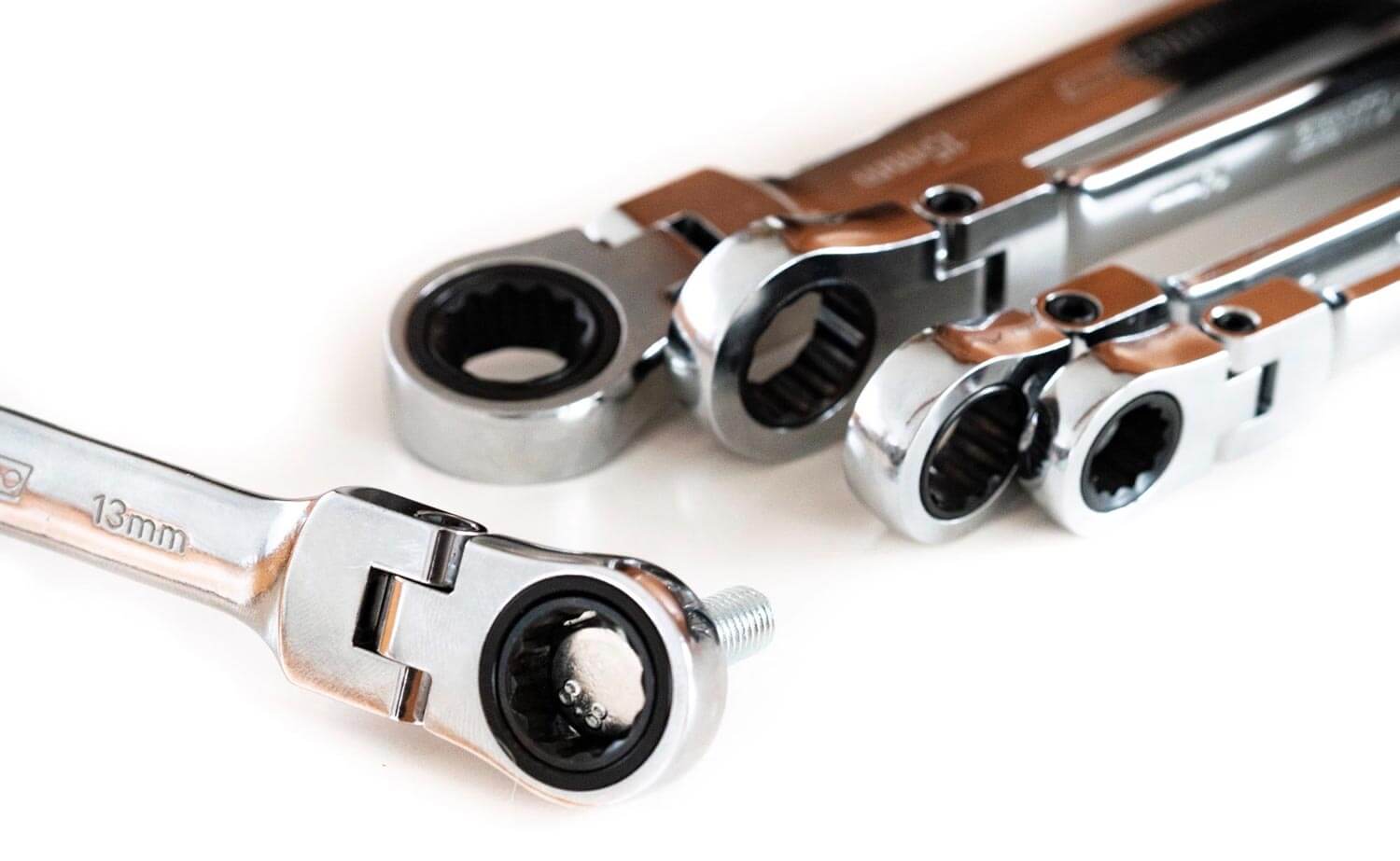
Why You Need Ratcheting Box End Wrenches
- This wrench is excellent for difficult angles. It only needs to be secured onto the bolt or nut once, not after every turn like a standard wrench.
- They will cut your time by 75%. They really shine in areas with little swing room – spots where you can only rotate a few inches in each direction.
- Its small profile gets into many places a standard ratchet and socket can’t.
Limitations
There are a couple of things to be aware of when using a box end wrench.
- The bolt you are tightening will need some resistance. You’ll need to get the bolt started before you can use the ratcheting action.
- It is also easy to get confused about which side of the wrench tightens versus loosens.
- Metric, 6-piece set, 8-19mm
- Chrome vanadium steel construction with corrosion resistance
- Includes roll-up pouch for storage
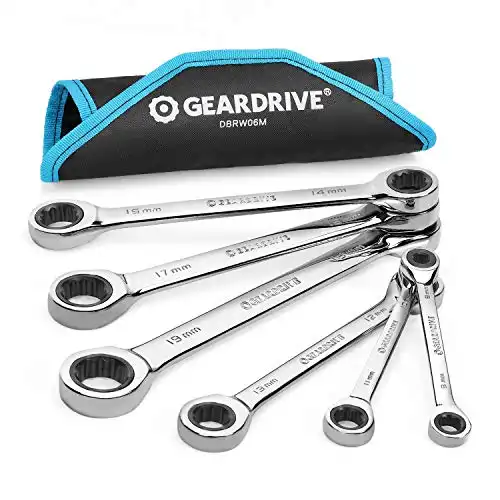
TIPS FOR BUYING A RATCHETING BOX END WRENCH SET: Wrenches with a flex-head style where the box end swivels freely can pop off when adjusting a bolt. Try a fixed head or a high-quality flex-head set where the box end snaps into place at a 30 and 60-degree angle.
We suggest this Gear Drive ratcheting box end wrench set .
UPDATE: We exchanged our Habor Freight’s wrench set twice due to a seized box end before opting for the set at the link above. The Gear Drive set was worth the investment.
5. transfer pump.
Water and other liquids make their way into all sorts of unwanted areas on a boat. This makes a transfer pump an irreplaceable tool.
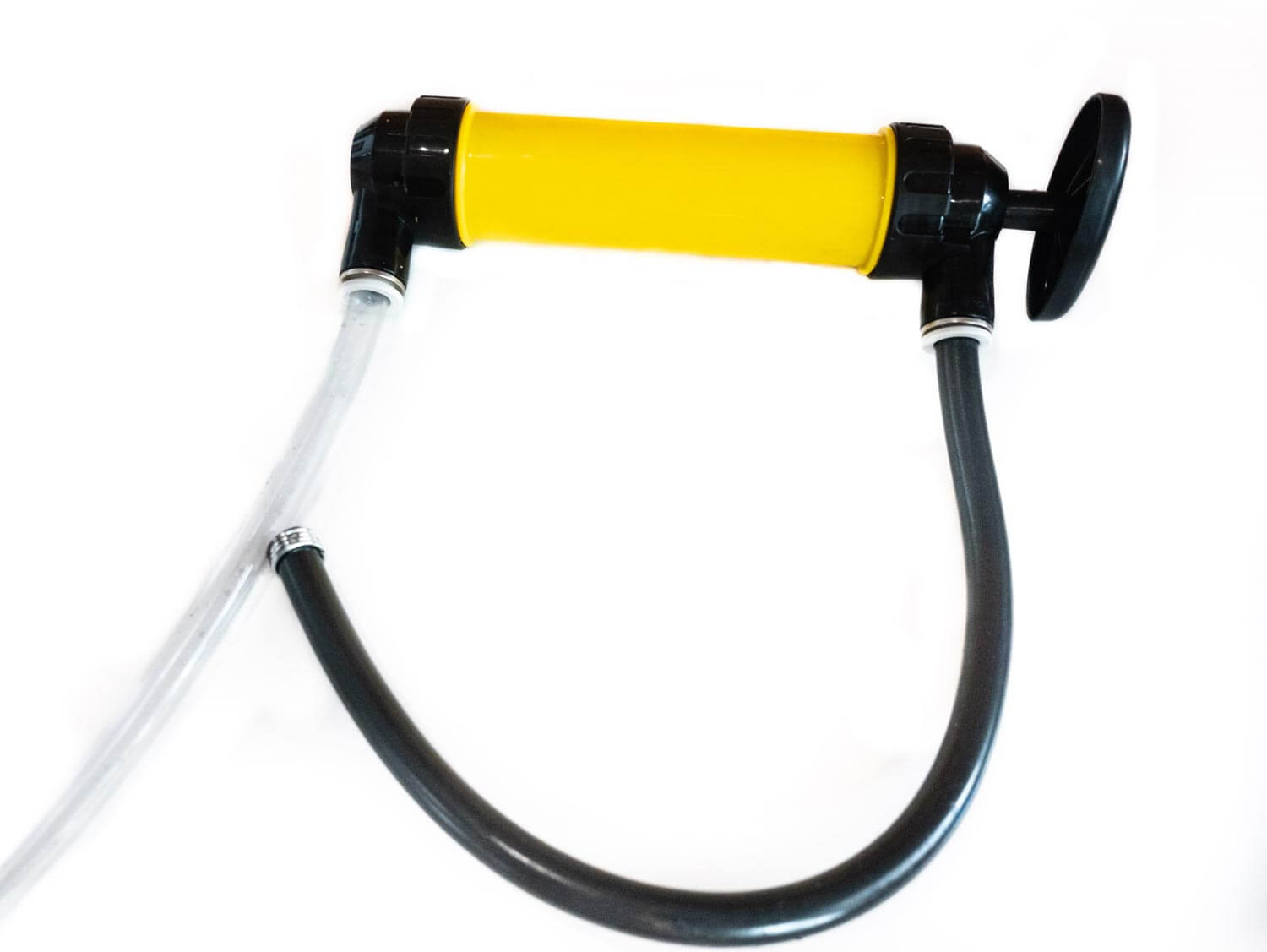
Uses for a Transfer Pump
- Universal gas siphon pump designed for auto and marine use
- Leak free quick-connect
- Small portable size
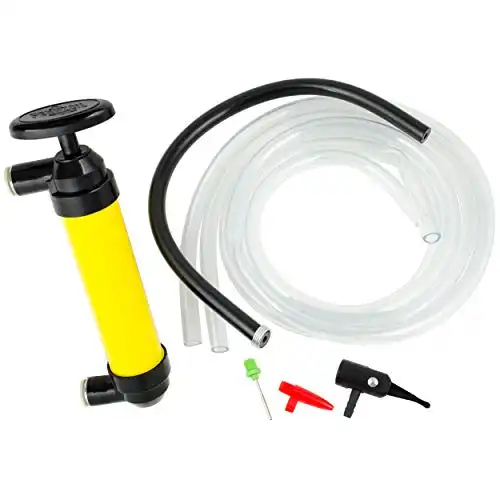
TIPS FOR BUYING A TRANSFER PUMP: There are electric transfer pumps available. We haven’t used them since having a manual pump is a more reliable option. Make sure your pump is rated for oil and fuel. We were glad to have this tool when we overfilled our diesel tank and needed to pump diesel out of the bilge.
We bought our first pump at Harbor Freight, but it didn’t last long. The second transfer pump we purchased was definitely an increase in quality. It is similar to the transfer pump here .
6. Lights and Headlamp
Most of us have a flashlight in our tool kit. But sometimes, we need just the right light for those unique dark holes we have to twist ourselves into on the boat.
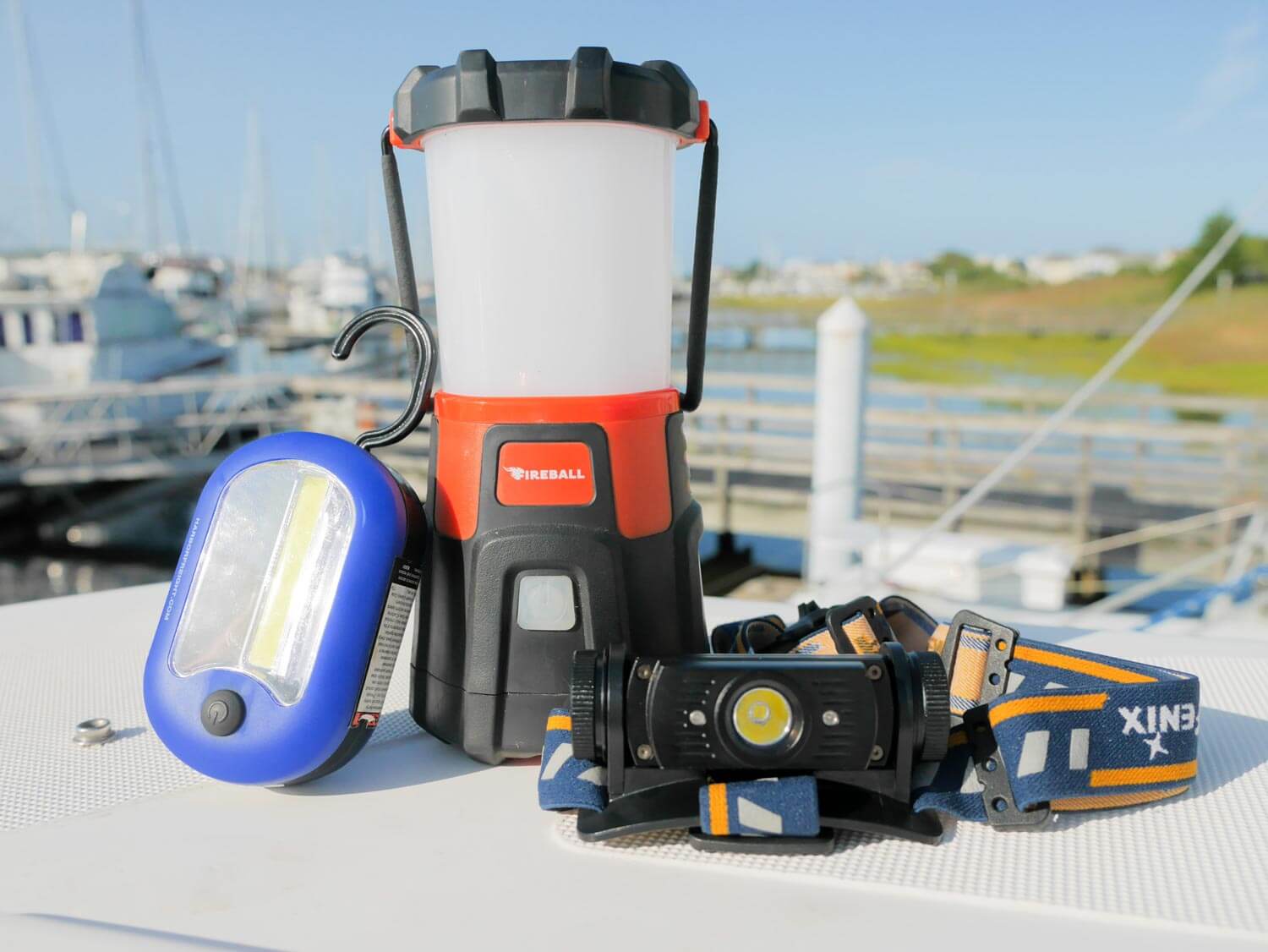
Lights with various attachment capabilities are helpful. We also like to have a few different ways to angle the light. Here are the options we keep in our tool kit.
For times when you need to have full control of your light, a headlamp is a must. A necessity for boat projects, but it’s also handy when working past sunset or pulling up the anchor at night.
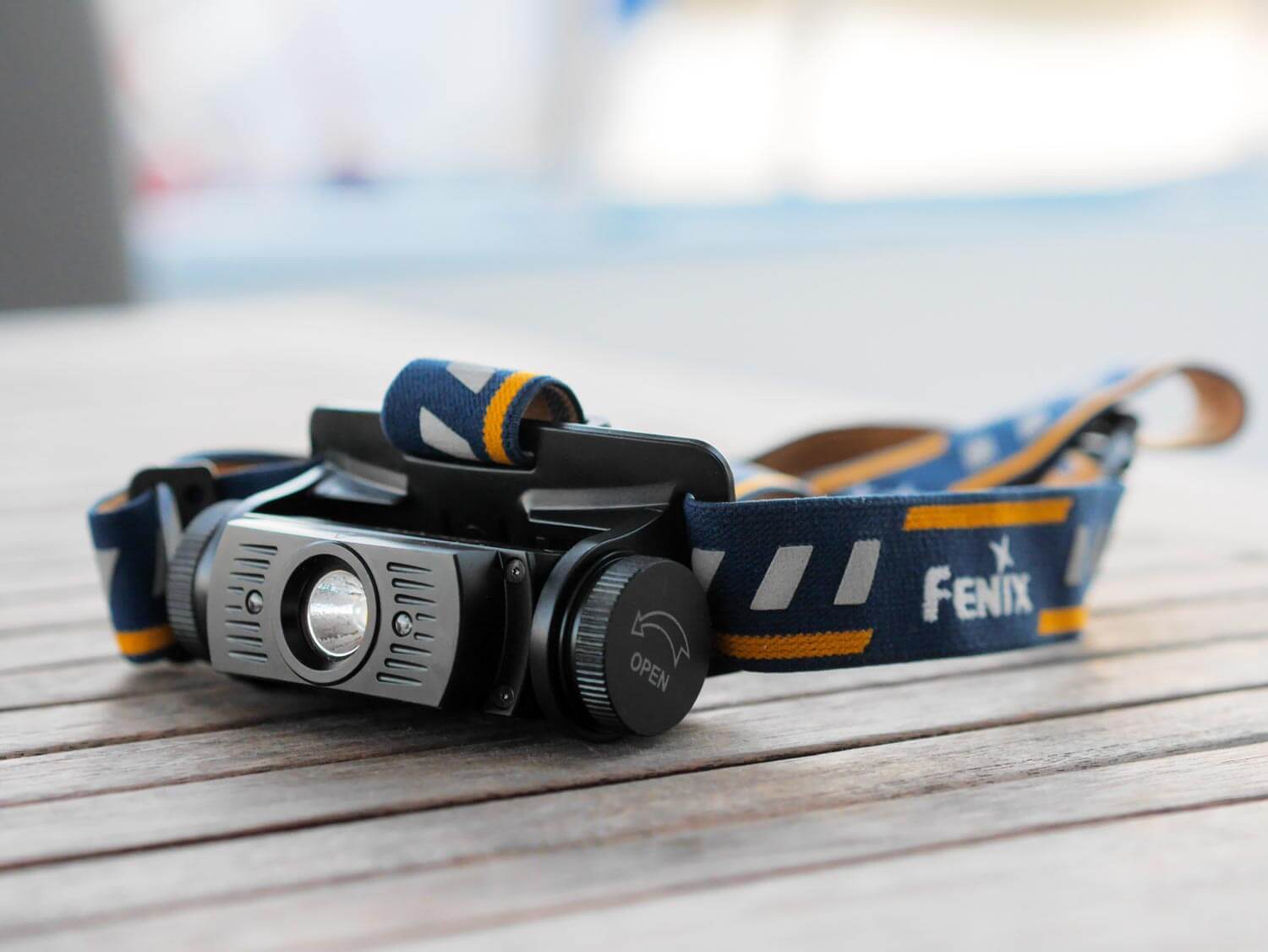
Many headlamps come with a red light setting for night mode, and some (like the one below from Fenix) are even waterproof.
- Rechargeable USB-C LED headlamp, 100 hours of runtime
- Neutral white light with five brightness settings and auxiliary red light
- IP68 w aterproof and dustproof
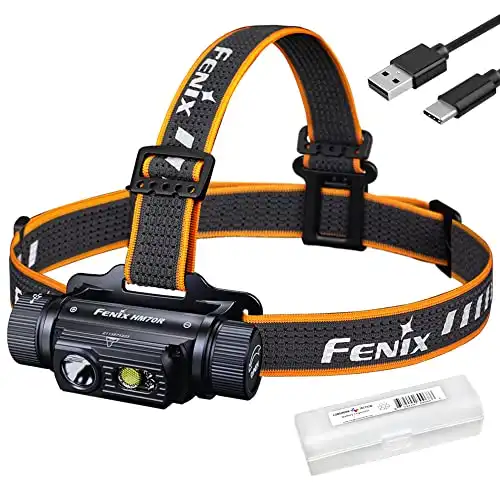
Check out this Fenix headlamp , one of the best sailing headlamps you’ll find.
Lights You Can Hang
Our favorite lights with a hook are from Harbor Freight and are usually free with purchase and a coupon .
The hook is preferable to magnetic lights since there isn’t a lot of metal on a boat. There are plenty of hoses or wires to hang a small light from, especially in the bilge.
These are also perfect for hanging in wardrobes.
The only downside to these lights is they run on AAA batteries instead of recharging by USB.
A lantern is ideal when you need a lot of light in a dark space. It illuminates at 360 degrees distributing light in all the nooks and crannies.

When we’re in a tight, empty anchorage, we also like to hang this light in the cockpit overnight. It makes us more visible to fishing boats and other small vessels that might be out and about in the dark.
This lantern is rechargeable via USB and features multiple modes. It will even recharge your phone!
- Rechargeable USB lantern
- 1000 lumen light
- Can also use as a power bank for phones and other devices
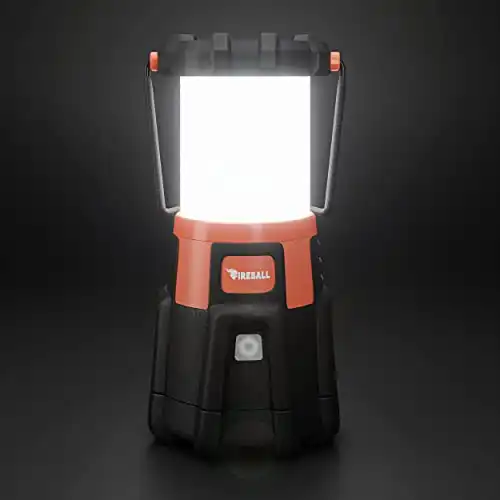
TIPS FOR BUYING WORKING LIGHTS: When looking for a quality light, we aim for an output of around 1,000 lumens to give you a nice, bright light. We try and buy lights that are rechargeable via USB. LED lights have become the standard. They stay cool and extend battery life.
7. pick & hook set.
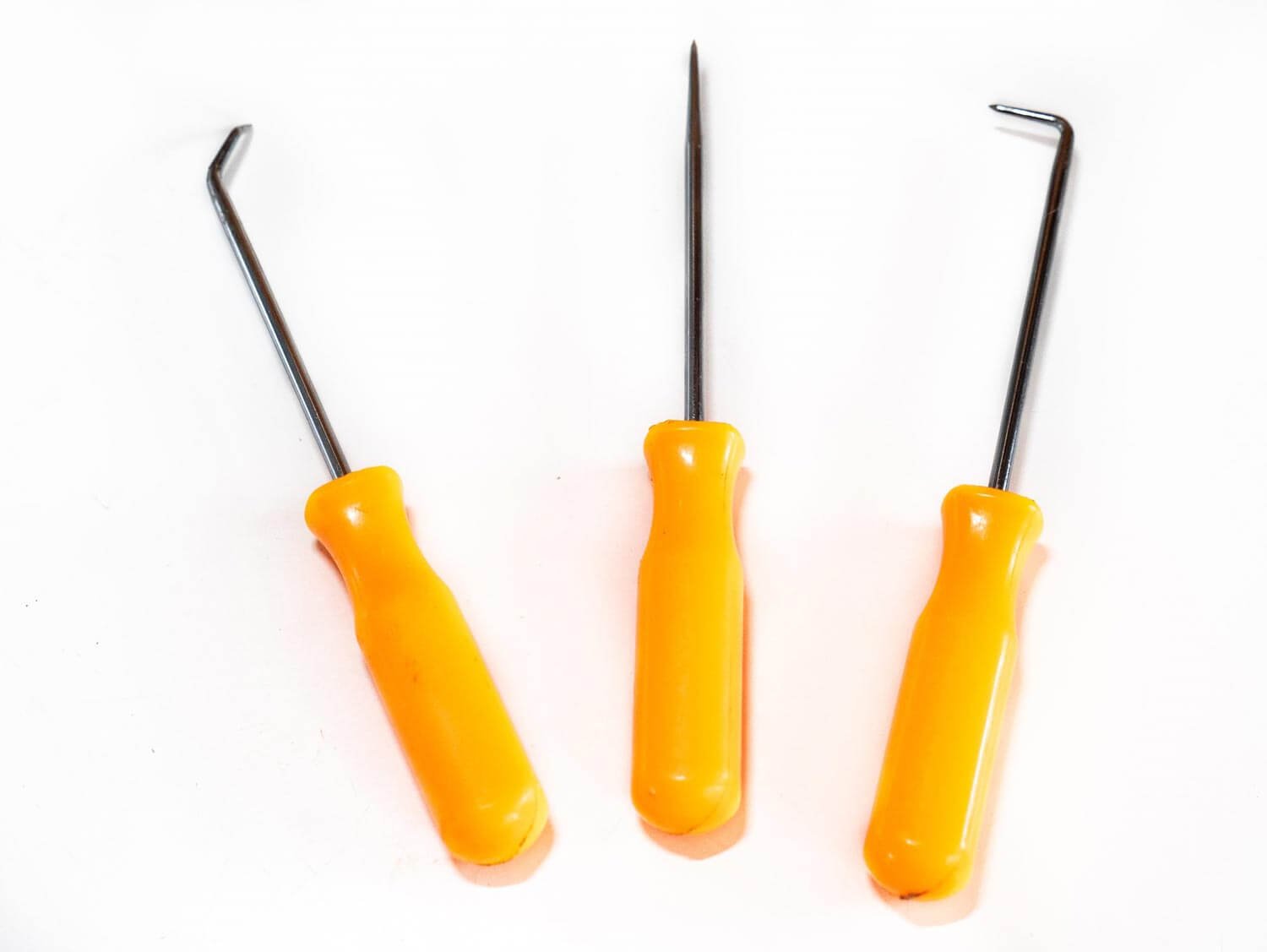
These tools are ideal for precision work. They are handy cleaning aids and removal tools for unique boat projects.
Uses for Picks and Hooks
Tips for buying picks and hooks: we got our set from harbor freight. it was a plus buying the cheaper set. if we ruin one trying to clean an area or pop out a seal, it’s no big deal..
This is our pick and hook set from Harbor Freight .
8. Strap Wrench
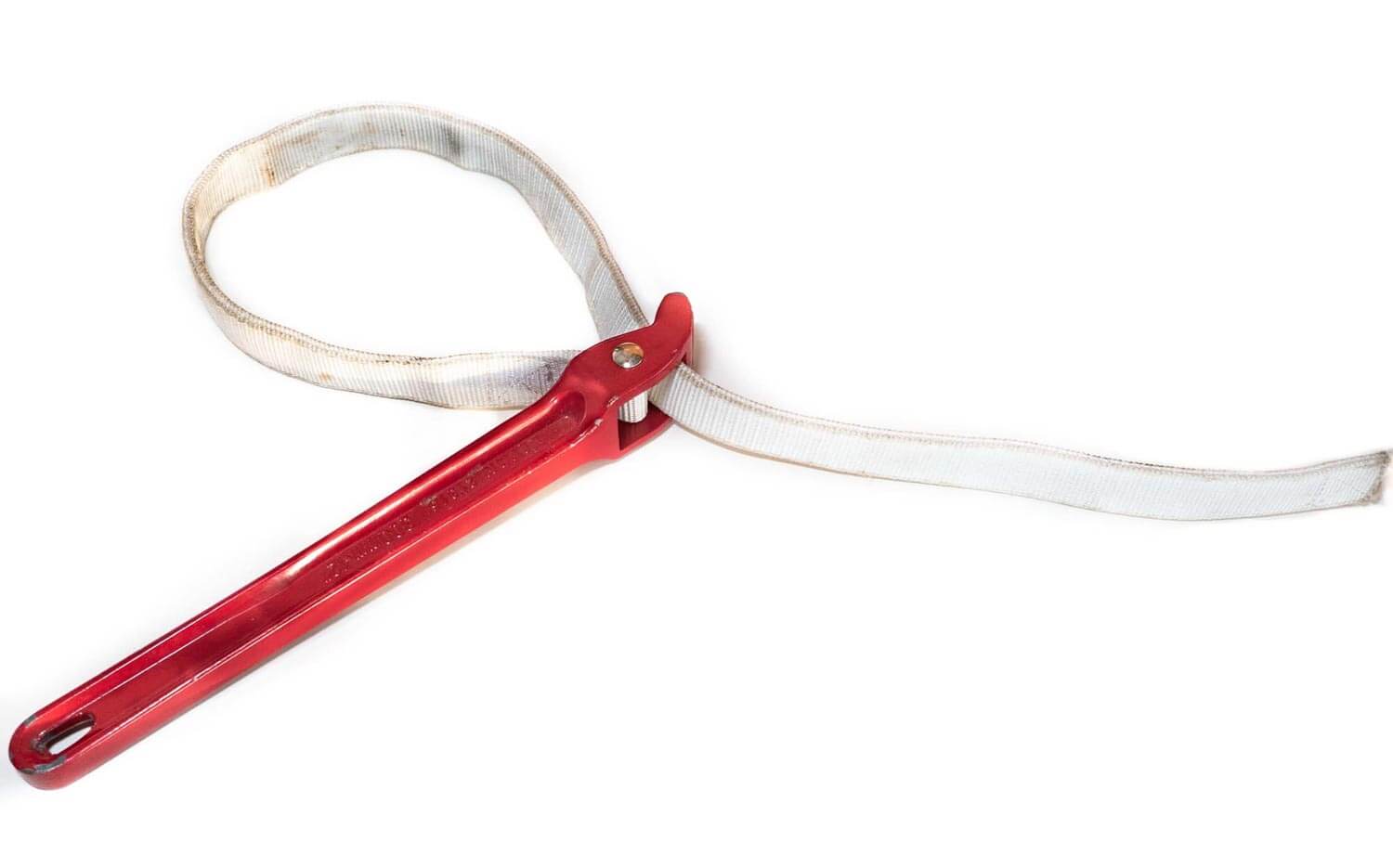
Out of all our sailing tools, we’re surprised by the number of times we reach for the strap wrench. Besides being handy to open a pickle jar, it can loosen the most tightly assembled boat parts.
Anything that’s round the strap wrench can grip.
Uses for a Strap Wrench
- Removing the oil filter on the diesel engine – with the strap wrench, you won’t need a specific oil filter removal tool
- Put torque on a propeller while servicing
- Use this to grip a rotating part such as the pulley on the diesel engine water pump or a propeller – use the strap wrench to hold these in place while you remove the bolt
- Use on anything round where you don’t want to cause damage – the fabric of the strap wrench is gentle on fragile boat parts
- Strap width is 1.05-inches, strap length is 34-inches
- Lightweight aluminum I-beam handle, woven polypropylene strap
- 2-ply double thick strap reduces stretching
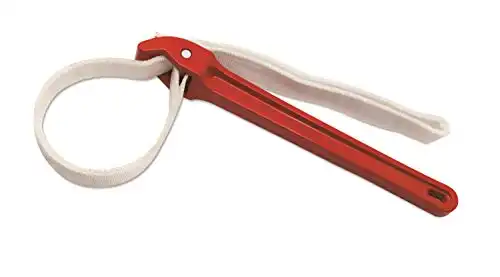
TIPS FOR BUYING A STRAP WRENCH: We like the cloth strap over rubber since it’s more durable and gentler on the item you are turning. The 12-inch strap wrench we have is pretty large. We haven’t found a smaller, similar one. It hasn’t been a problem, but the current one would be difficult to get in a tight space.
You can get our 12-inch strap wrench here .
9. Butane Soldering Iron
If you want to do electrical work, a butane soldering iron is an excellent addition to your tool kit.
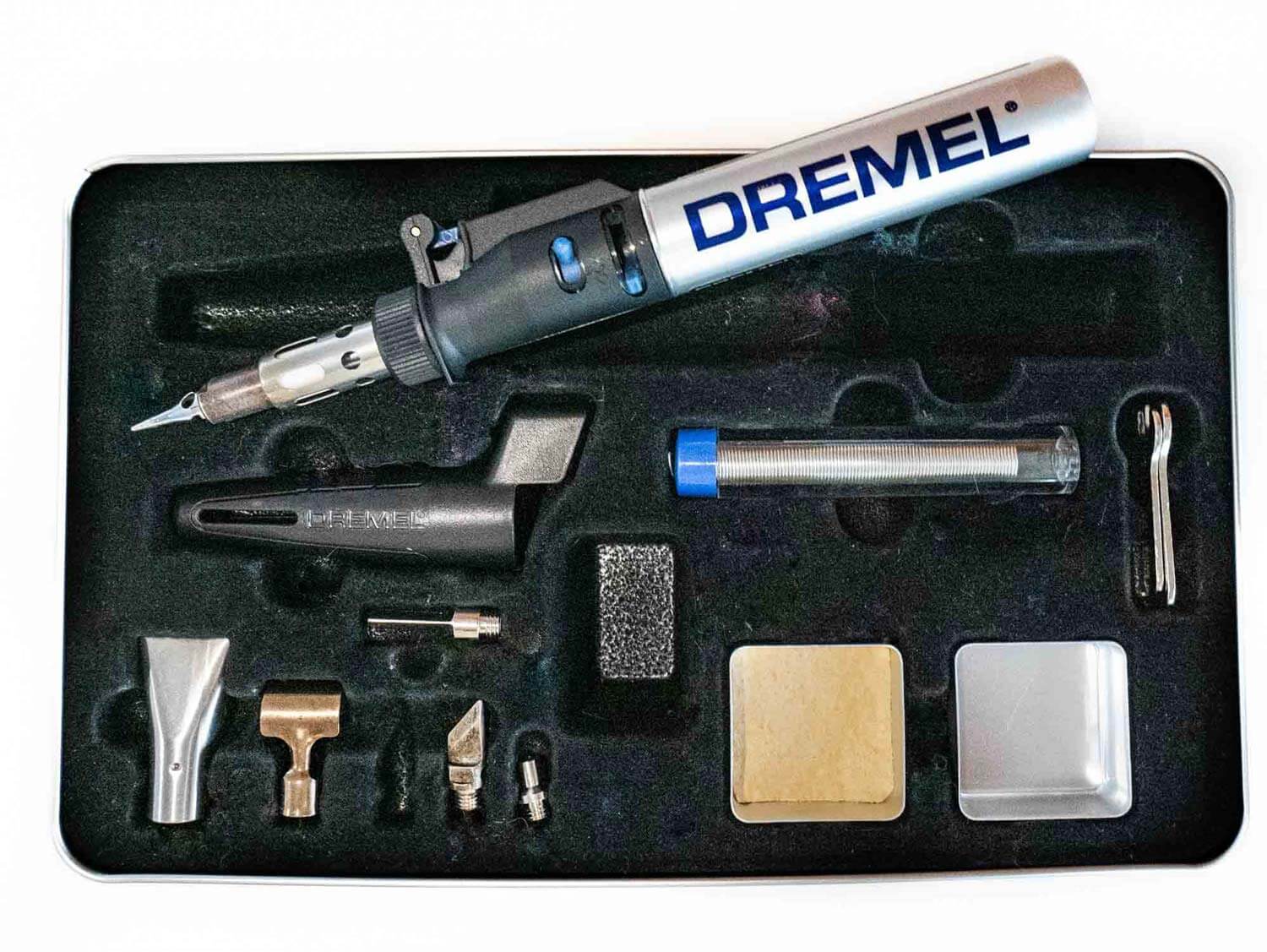
Unlike its electric counterpart, the butane soldering iron is a sleek tool. Do you need to solder wires together down in the bilge? This tool is much easier to handle in tight spaces.
Advantages of Butane Over Electric
- Integrated ignition trigger and safety lock
- Adjustable temperature and flame size
- 14-piece kit for soldering, melting, cutting, welding, and burning
- Tank is refillable (uses liquid butane lighter fuel)
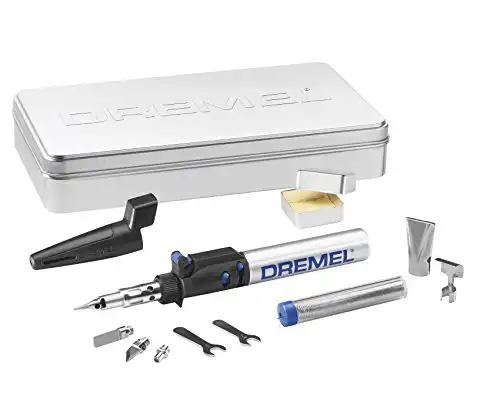
You can see our butane soldering iron here .
IMPORTANT: Before using a soldering iron, you need knowledge of electrical safety. They get extremely hot. You will want to avoid doing damage to yourself or your boat.
What other tools do i need for a sailboat.
Here are some other items that are handy for working on a sailboat.
- cable ties or zip ties
- various pliers including needle nose pliers, locking pliers (or Vise-Grips ), tongue and groove pliers (Channellocks) or an upgrade we highly recommend is KNIPEX pliers
- Loctite Threadlocker (both blue and red) – blue will take care of 90% of your projects
- hose clamps of all shapes and sizes
- duct tape (but also have an assortment – Butyl tape, electrical tape, painter’s tape, Gaffer tape, etc.)
- multimeter and amp-clamp
- temperature gun, or an upgrade we recommend is a thermal camera that attaches to your smart phone
- torque wrench
- Deep Creep lubricant
- The Absorber chamois cloth for soaking up water (we have one for clean jobs such as defrosting the fridge and one for dirtier projects where oil or other liquids might be present).
This isn’t a complete list, but a few more items to help you get started.
Final Advice on a Sailboat Tool Set
Living on a boat requires more tools than almost any living situation you’ll encounter. When you have the right tools, maintaining a boat is more manageable and less stressful. Plus, you’ll save a ton of time, allowing you to spend more hours enjoying your boat and fewer hours working on it.
I hope this list has given you some ideas for multi-purpose tools that will be valuable additions to your boat tool kit.
NOTE: This list of sailors’ tools was written with a large amount of input from Captain Ross. He is the fixer and maintainer of everything on SV Sunnyside.
Want more ideas for boat accessories and gear.
For lists of essential sailboat gear, what to wear sailing, and more, view our complete guide.
Like this post? Save it on Pinterest for later.
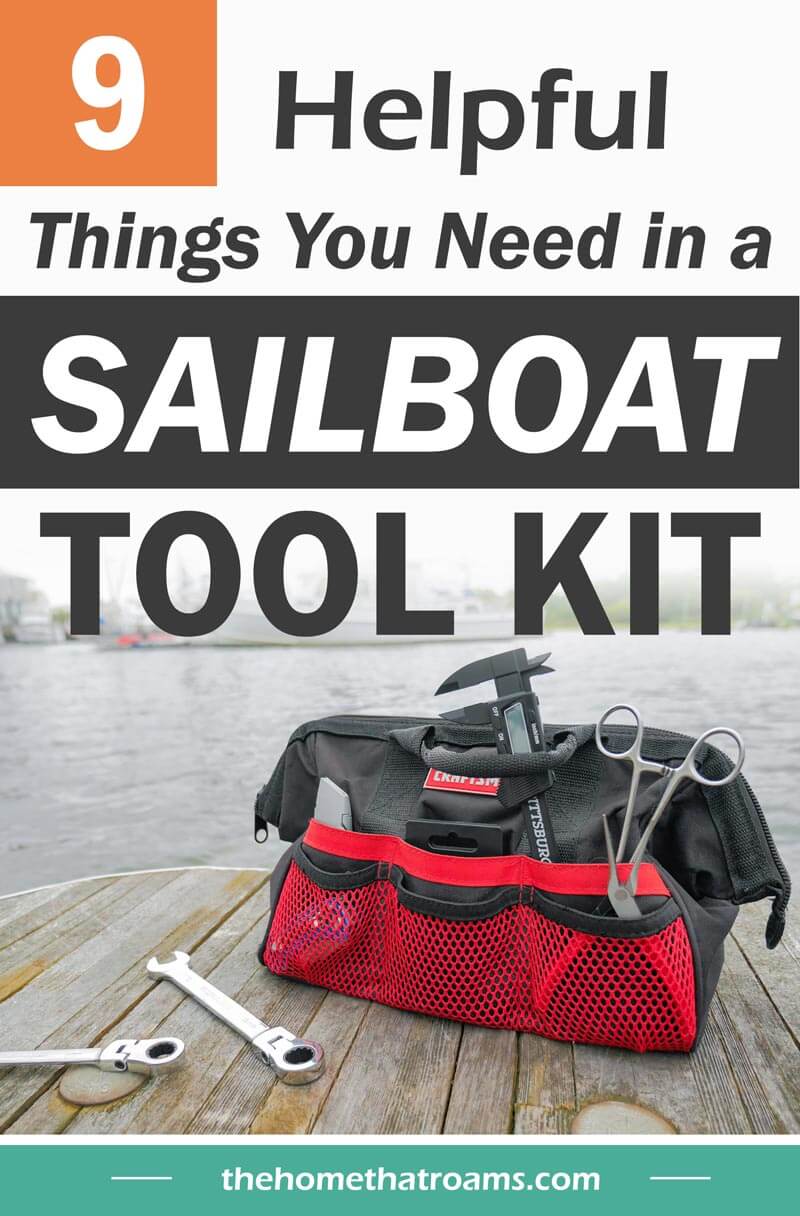
Morgan, the founder of The Home That Roams, has been living nomadically for over five years. She began her journey traveling across the U.S. in a motorhome and cruising on a liveaboard sailing catamaran. Currently, she lives full-time in a travel trailer, sharing resources on RV living and boat life to help others downsize their lives and thrive in an alternative lifestyle.
Leave a Reply Cancel reply
Your email address will not be published. Required fields are marked *
Sign Me Up!
Learn how to live on a boat.
Get weekly tips on how to start traveling full-time on a boat.
View our privacy policy .
Privacy Overview
| Cookie | Duration | Description |
|---|---|---|
| cookielawinfo-checkbox-analytics | 11 months | This cookie is set by GDPR Cookie Consent plugin. The cookie is used to store the user consent for the cookies in the category "Analytics". |
| cookielawinfo-checkbox-functional | 11 months | The cookie is set by GDPR cookie consent to record the user consent for the cookies in the category "Functional". |
| cookielawinfo-checkbox-necessary | 11 months | This cookie is set by GDPR Cookie Consent plugin. The cookies is used to store the user consent for the cookies in the category "Necessary". |
| cookielawinfo-checkbox-others | 11 months | This cookie is set by GDPR Cookie Consent plugin. The cookie is used to store the user consent for the cookies in the category "Other. |
| cookielawinfo-checkbox-performance | 11 months | This cookie is set by GDPR Cookie Consent plugin. The cookie is used to store the user consent for the cookies in the category "Performance". |
| viewed_cookie_policy | 11 months | The cookie is set by the GDPR Cookie Consent plugin and is used to store whether or not user has consented to the use of cookies. It does not store any personal data. |

Yachting World
- Digital Edition

Boat galley accessories: essential cooking tools for cruising sailboats
- Nica Waters
- April 7, 2022
After 30 years trying out various boat galley accessories, long-term cruising sailor Nica Waters offers her top recommendations for kitting out your sail boat's kitchen with a few tried and tested items from our Tech Editor Fox Morgan's Dehler 36 galley…

A well founded boat galley with just the right accessories for your food prepping style can make life on board an absolute joy.
Nica writes “We recently rebuilt the galley on our 28’ cutter, Calypso , the boat we’ve owned and cruised intermittently on since 1992. This time, using the wisdom gained over the past 30 years, we incorporated more usable storage areas, installed a large undermount sink, and even splurged on Corian counters.”
“As we moved aboard in April of 2021, we made sure that the galley items we brought with us are all ones we love and use frequently. After all, having the right tools makes cooking even more of a pleasure.”

The Marine Tech Editor, Fox Morgan loves their linear galley as it is especially well organised with just the right bit of kit in just the right places.
“Working in a confined space with limited storage, it’s a balancing act to make sure you have enough galley kit on board and don’t lack things that would make your life easier. Being judicious about what comes aboard can pay off handsomely both in terms of organization as well as the sense of space. For example, despite being a self-proclaimed cutting board addict, I had to be honest and realize that most of the time I use the same board over and over. I don’t need to take 15 on the boat! Almost everything needs to serve double duty; almost nothing is single use.”
If you’re just setting up a galley on the boat, here are some boat galley accessories you might not have thought of…
Boat galley accessories – knives
At the core of a good galley is its knives . You do not need to buy a complete knife set, which often include a number of knives you don’t need, but rather buy individual ones.
A 9” (or 7”) chefs knife, a serrated blade for cutting bread, and a smaller paring knife are essential; the next one I’d get is a long bladed boning knife for filleting your fresh catch of fish.
Find knives that fit your hand and feel good; some people prefer heavier ones while other people like light blades. Stainless steel blades will dull faster than carbon steel blades, but carbon steel blades will rust. Ceramic blades hold their edge for a long time but are notoriously hard to sharpen.
ZWILLING Chef’s Knife, Blade length: 20 cm, Wide blade, Special stainless steel/Plastic handle
A chef’s knife is an absolute must, ideally you’ll have more than one of these. As a boat galley accessories go, this is an area not to be scrimped on. Buy good quality. There’s a chance it will also be used for cutting and trimming lines on deck at some point too.
Price £63.84
Buy Zwilling paring knife from Amazon.co.uk
Shop for Zwilling knives on Amazon .com

ZWILLING Twin Pollux Bread Knife, steel, Silver/Black
A bread knife is one of the staple boat galley accessories, you might be cutting bread with it… sometimes it’s useful lashed to a pole for lopping a rope off your propeller too. Make sure you buy a good one of these!
Price £30.95
Buy Zwilling bread knife via Amazon.co.uk

Ceramic Blade Paring Knife with Sheath
Tech Editor, Fox Morgan says “Onboard Boogie Nights there’s two paring knives. One steel the other is ceramic and 9 times out of 10 I’ll reach for the ceramic blade. It is light and I like the white blade. It is SUPER sharp and I have already sliced the tips of my fingers off when not paying attention chopping an onion one day while distracted and chatting with my co-skipper. The blade protector stays in place and the knife lives in the cutlery drawer with other stuff. It’s a few years old now but still sharp and still my first choice from the drawer. It’s also great for slicing mooring lines for splicing or repairs. watch out for the super sharp blade really near the handle though. That can catch you out”

Food prepping in the cockpit on a very hot day. Ceramic paring knife in hand. Look carefully, they can be difficult to see with their white blades. They do come in brighter colours, I would recommend trying a bright colour for safety.
Price: £16.99
Buy Ceramic paring knife from Amazon.co.uk
Note: We may earn a commission when you buy through links on our site, at no extra cost to you. This doesn’t affect our editorial independence.
Having chosen your knives, you need to have a place to store them safely, and a way to sharpen them. One of our galley upgrades was a pair of magnetic knife strips which we’ve attached to the underside of the deck in the galley area.

under counter magnetic strip – doubled up for extra security
You do need to make sure these powerful magnets are placed far from any compass or autopilot. We have two strips so the knives are secured in two places along the blade. Our stainless steel knives hold well, which is an indication of the quality of the stainless steel they are made from. (note from Tech Ed: beware that some stainless blades are not fero-magnetic due to their metal composition. So double check this if buying new blades and intend yo hang them safely on magnets.)
MIU France Stainless Steel Magnetic Knife Bar, 15-Inch
Price: £32.87
Buy the MIU France Stainless Steel Magnetic Knife Bar on Amazon
If you store your knives in a general cutlery drawer, be prepared to sharpen them even more frequently as the blade edges will be .amaged and dulled by contact with other utensils, although some knives do come with blade protectors that slide or clip onto the knife blade to keep it tip top and to avoid accidental injury when reaching into the cutlery drawer.
A knife sharpener can range from a simple whetstone all the way up to an electric knife sharpener ; our preferred tool is an easy-to-use hand sharpener that guides the knife to the correct angle.

WORK SHARP Guided Field Sharpener
Price: £32.95
Buy Worksharp field sharpener via Amazon.co.uk
Chef’s Choice Professional Electric Kn ife Sharpener
Price: £217
Buy Chef’s Choice electric knife sharpener from Amazon.co.uk
Though this item possibly fails the ‘multi-use’ test, a Microplane zester is another must-have cutting tool in Calypso’s galley. Coming with its own guard, this slender rasp-style grater makes quick work of ginger, garlic, and parmesan cheese and stores flat; it’s also relatively easy to clean since you have access to both sides of the tool.
Microplane Zester Grater Black for Citrus Fruits, Hard Cheese, Ginger, Chocolate, Nutmeg and Truffle from The Premium Classic Series with Stainless Steel Blade
Price: £18.30
Buy Microplane Zester via Amazon.co.uk
Buy the Microplane zester on Amazon
Boat galley accessories – tongs
Everyone has their own preference as to tools to use to turn food in the pan. While spatulas and spoons, forks and even chopsticks all have their place in the galley, I can’t speak highly enough of these locking tongs .
OXO Good Grips Tongs – 12 inch
We have two pairs as we use them so much. One might be in use at the stove, turning meat or stirring pasta, while the other is being used to toss salad. I find the 12-inch size to be far more versatile than the longer ones, and personally find the silicone-tipped ones go gummy too quickly. Just be careful if using these with a nonstick pan surface.
Price: £27.99
Buy OXO 12-Inch Stainless-Steel locking tongs on Amazon
Colourworks Mini Tongs
These Mini tongs are useful in so many ways around the galley. You can pull a hot packet of wet food out of the the boiling pan with them or give a small pot a stir or flip your bacon with them. These fit into places where the larger tongs do not. Silicon tips can also help to preserve nonstick if you have that on your pans. Tongs of all shapes and sizes are considered one of the most essential boat galley accessories.
Price: £3.49
Buy Mini tongs from The Range
Boat galley accessories – blenders
Rounding out the hand tools category is an immersion blender .
When I lived on land, I used my beloved Cuisinart food processor almost daily. Space and power constraints on the boat mean it can’t come with us cruising, but I really did want something that could do some pureeing and fine chopping tasks.
A good galley alternative is an immersion blender. This stick blender does require an electrical outlet nearby, but fits into small spaces and larger pots with ease.
We call it the boat motor; it makes a lovely smooth vegetable soup as well making quick work of frozen fruit and yogurt for a smoothie.
The accompanying small bowl and blade means that smooth hummus and other luxuries are possible on board.
You can buy kits that come without some of the extra attachments (we in particular question the masher attachment), but they’re more expensive.
Braun MultiQuick Hand Blender
As used for over 10 years on the Tech Eds boat, this tried and tested hand blender has been pressed into action offshore many times, whipping up cake batters and chopping tomatoes and anything else we care to throw at it. One of the best value for money items ever introduced to the galley. It’s powered from a small inverter. Though, sometimes cake making goes a bit awry… sense of humour required when this happens. Thankfully we were moored up when this happened. This Braun hand blender was the secret weapon used in the great Atlantic bake-off during the Azab 2019 race.

utter carnage in the galley as the frosting went for a flyer.

Chocolate and Guinness cake, the SV Boogie Nights signature arrival cake, once we got the frosting in the right place it was utterly delicious and a doddle to make thanks to the little Braun gizmo.
Buy the Braun hand blender via Amazon.co.uk
Buy the Braun 4-in-1 Immersion Hand Blender on Amazon
Best pots and pans
Made-in stainless clad saute pan.
On board, I tend to cook with an eye toward cleanup. Like most cruisers, we’re water-conscious, and one way to minimize water use is to create fewer dirty dishes.
One-pot meals are a good way to put this mantra into practice. A surprise favorite pan for this is a stainless steel 3.5-quart saute pan (if we were a family of 4 still on board, I might like a larger version.)
This straight-sided skillet goes from stove top to oven flawlessly; the tight fitting lid for it means it can also work to cook rice or pasta. Watch for a handle that’s short enough to fit in the oven.
Price: £123.99
Buy the 3.5 quart Stainless Clad Saute Pan on madeincookware.com
Kuhn Rikon Duromatic Inox Stainless Steel Pressure Cooker with Long Handle, 5 Litre / 22 cm
Pressure cookers are another conservation tactic, working to save on cooking fuel as well as time spent in the galley. The premise behind these pots is that they cook foods at a higher temperature by applying pressure, meaning that cooking takes less time.
For example, if we decide at 5 pm that we’d like black bean soup for dinner; the pressure cooker takes beans from dried to yummy in half an hour. This pot doubles as my largest mixing bowl as well as a regular, non-pressurized pot for pasta.
Unfortunately, the Fagor brand we use has been discontinued, but this recommended one has been in use on my friend Behan’s boat for the past ten years.
Price: £132.53
Buy the Kuhn Rikon Duromatic Pressure Cooker on Amazon
Instant Pot Duo Nova 7-in-1 Smart Cooker, 5.7L – Slow Cooker, Rice Cooker, Sauté Pan, Yoghurt Maker, Steamer and Food Warmer
If you have the electricity and storage space to spare, multi-cookers (essentially, electric pressure cookers with a few other bells and whistles) are all the rage in the United States. I’ve never used one but have yet to meet anyone who is not wildly impressed. Many boats are shifting away from propane as a cooking fuel especially as lithium batteries are becoming more widespread, and a multi-cooker is a favourite boat galley accessory for cruisers with an electric galley.
Price: £69.99
Buy the Instant Pot Duo 7-in-1 Electric Pressure Cooker on Amazon

Tefal Ingenio Essential Non-Stick Pots and Pans Set, 5-Piece, Starter Kit
The Tefal Ingenio pans are also a boat galley favourite as they can go from stove top to oven to cool box and back again with their removable handles and clip lids to stop spillage.
The Tech Ed writes “These have been in use onboard SV Boogie Nights for around 8 years now.

Tefal Ingenio pans, with quick release handle removed for better balanced pans when sailing offshore. Stackable and versatile. An excellent investment for the galley.
The small frying pan is looking a bit tired because it get’s the most use but the clip handle, lids and pans are still going strong. The good thing is that you can buy the pans individually so you can make your own set that suits your particular galley needs. The handles are easy to find, often in European supermarkets too.”
Price: £56.99
Buy Tefal Ingenio starter kit from Amazon.co.uk
Best of the rest
Other favorite boat galley accessories and tools are personal: there’s the wide-mouth thermos I use to make yogurt, the citrus juicer I bought in an eclectic hardware store in the Dominican Republic, the French Press coffee maker we use every morning.

Zulay Metal Lemon Lime Squeezer – Manual Citrus Press Juicer
If lemons and Lime are your thing, then much like a garlic press, you’ll love this and it will make life just a little neater. Cocktails and cooking are a little bit better with a dash of citrus. The boat galley accessory you never knew you needed…
Buy Zulay lemon squeezer via Amazon

CLASSIC LEGENDARY FOOD JAR | 1.0 QT
A robust food flask with a wide mouth. Its ubiquitous design can be seen around the globe in the ditty bag of anyone who travels or wants to travel relatively light but head away from it all. This isn’t just a boat galley accessory, but a trekking and hiking accessory too.
Buy Stanley food flask via Amazon

Frieling USA Double Wall Stainless Steel French Press Coffee Maker with Zero Sediment Dual Screen
If you’re a coffee lover then a decent press will really enhance your mornings. Avoid glass and go for something sturdy, reliable and without consumable parts, such as paper filters. The dual mesh inner keeps the coffee grounds away from your cup and you’ll have enough in this press for more than one cup.
Buy Frieling stainless coffee press via Amazon

Luci Solar String Lights + Phone Charger with 100 Lumens
One special tool, although not a galley-specific item, that has immeasurably improved our dining life at anchor is these Luci string lights . Solar powered, they clip easily to our bimini top and provide light and ambience for dinners in the cockpit.
My husband was skeptical at first and now is the first person to reach for them when the sun starts to go down!
Buy Luci Lights via Amazon
Didn’t find what you’re looking for? Head to Amazon’s dedicated sailing page for more marine products.
If you enjoyed this….
Yachting World is the world’s leading magazine for bluewater cruisers and offshore sailors. Every month we have inspirational adventures and practical features to help you realise your sailing dreams. Build your knowledge with a subscription delivered to your door. See our latest offers and save at least 30% off the cover price.

- Paralympic Games 2024
- Paris Olympics 2024
- Lok Sabha Elections 2024
- UK Elections
- Firstpost Defence Summit
- Entertainment
- Web Stories
- First Sports
- Fast and Factual
- Between The Lines
- Firstpost America

Two women and a boat: The ocean-sailing team behind Navika Sagar Parikrama
The second edition of the Navika Sagar Parikrama will be flagged off on October 2 and, thereafter, the courageous duo is expected to be at sea for close to eight months as they navigate more than 21,600 nautical miles (approximately 40,000 km) without any external assistance, relying solely on wind power read more
)
Officially, they are Lieutenant Commander Dilna K and Lieutenant Commander Roopa A, the two women crew of INSV Tarini, setting out on a circumnavigation voyage. To the people around them helping them get ready for their grand quest, they are affectionately referred to as ‘#DilRoo’. This catchy portmanteau of their names reflects the cheerful, if cautious, optimism at the Indian Navy’s Ocean Sailing Node (OSN) in Goa, as the last-minute preparations are going on in full swing. The second edition of the Navika Sagar Parikrama (NSP 2), as the sailing expedition has been called, will be flagged off on October 2 and, thereafter, the courageous duo is expected to be at sea for close to eight months as they navigate more than 21,600 nautical miles (approximately 40,000 km) without any external assistance, relying solely on wind power.
In the words of the Navy spokesman, “The circumnavigation highlights the exceptional valour, courage and perseverance of the officers who will face rigours of high seas, extreme weather conditions, pushing the limits of human endurance. The route will take them through some of the most treacherous waters including the perilous passage around the three great Capes — Cape Leeuwin, Cape Horn and the Cape of Good Hope.”
That they happen to be women officers says much about how, firstly, the Navy is empowering women in several domains and, secondly, how women are responding positively to such opportunities and challenges. To quote the Navy spokesman again, “The voyage is not just a testament to their personal bravery and skill, but also a celebration of the Indian Navy’s commitment to ‘Nari Shakti’ showcasing their indomitable spirit and determination”.
Apparently, this expedition was conceived by the Indian Navy soon after the inaugural Navika Sagar Parikrama (NSP 1), the first ever Indian circumnavigation of the globe by an all women crew of six officers in 2017. It is understood that it was greenlighted by Admiral KB Singh during his tenure as the Navy Chief a few years ago.
Brief Historical Background
Dilna has never met the late Vice Adm Manohar Prahlad Awati and Roopa barely once but the man considered the ‘Bhisma Pitamah’ of India’s Ocean sailing odyssey would certainly be smiling from Valhalla at the rapid strides in this field. Nursing a dream of having an Indian circumnavigate the globe on a sailing vessel, the indefatigable Awati campaigned tirelessly to make that possible. Less than 20 years ago, he finally got the go ahead from the then Navy Chief, Admiral Arun Prakash.
In the two decades since, India has had eight members in the club — naval officers all in Captain Dilip Donde, Commander Abhilash Tomy (twice, both non-stop), Lieutenant Commander Vartika Joshi, Lieutenant Commander Pratibha Jamwal, Lieutenant Commander P Swathi, Lieutenant Commander Aishwarya Boddapati, Lieutenant Shourgrakpam Vijaya Devi and Lieutenant Payal Gupta. ‘#Dilroo’ is aiming to take that figure into double digits. In fact, the traction that these circumnavigation expeditions have garnered, can be gauged even from the iconic status that Abhilash Tomy’s unsuccessful attempt in 2018 received because of his heroic exploits.
In a way, Ocean sailing’s upward trajectory has been similar to chess where India’s recent successes in the game have been attributed to a certain momentum and coming together of both people and institutions. Much like Visvanathan Anand expanded, enlarged and transformed India’s chess culture, so did Awati, Donde and Tomy transform India’s Ocean sailing landscape. It is worthy of note that Donde trained the six women officers of NSP 1 while Abhilash Tomy has been guiding and mentoring Dilna and Roopa. And, similar to chess where some movement and successes happened before Vishy Anand, so did the world of Ocean sailing develop its initial spurs through the expeditions of vessels like ‘Samudra’ and ‘Varuna’ and the commendable work of their crew and skippers like Soli Contractor, Anup Singh, Vijay Vadhera, GA Duke, RS Gill, VK Gawri to name just a few. Due credit also needs to be given to the efforts made by few civilians like Gulshan Rai and the Indian Army expeditions and their Sailing Clubs that competed with and complemented the efforts of the Navy.
In particular, mention must be made of the voyage by an Indian Army team, on a vessel called ‘Trishna’, which was the pioneering Ocean sailing effort in India. One is not even talking of competitive sailing (or Yachting as it is called) in which India has produced many champions; again, mostly from the Navy and the Army. While not the same as Ocean sailing, the fundamentals and the organisational frameworks are often derived from the same foundation. In this connection, the commissioning of Sailing Ships INS Tarangini (1997) and INS Sudarshini (2012) by the Indian Navy for formalised training of all cadets in Ocean Sailing was a remarkable initiative that gave a huge impetus to ‘across the board, boot camp experience’ to almost all officer trainees of the Navy. But that is a story for some other time.
Building an Ocean Sailing Ecosystem
However, the dizzying pace of the last two decades, verily, signals a new chapter in this journey. It is marked not just by circumnavigation but by several other ocean sailing sorties, by the establishment of an Ocean Sailing Node for formalised training and support, by indigenous building of many sailing vessels, and an institutionalised apparatus that backs such endeavours.
An African proverb, subsequently made famous by a book by Hillary Clinton, says that ‘it takes a village to raise a child’. Whether it be putting an astronaut on the moon or preparing a sailor for circumnavigation, an entire ecosystem supports and sustains that objective. It is to our credit that we have been able to build such an ecosystem in our country too. It is noteworthy that Dilna and Roopa have been trained for three years — across many disciplines — owing to the wherewithal created. Let’s have a brief look at the key players and units that have been instrumental in making NSP 2 possible.
At the apex, the Naval Headquarters and Headquarters, Southern Naval Command (SNC) have played a big part in ensuring harmonised orchestration of the many elements that make for their training, logistics and other aspects of preparation. Varied entities from Flag Officers to foot soldiers, Admirals to Agniveers have been relentless in ensuring that files have been pushed and cases pursued. It is in the fitness of things that almost all in the current top leadership of the Navy, across echelons, have been involved, one way or another, in decision making on previous sailing expeditions or in enabling the current one. Thus, they are aware of the many dimensions and variables in such ‘evolutions’ (a term favoured by the Navy) and what needs to be done.
The Indian Naval Sailing Association (INSA), New Delhi, is the nodal agency for Ocean sailing in India. It handles the overall development of sailing in the Navy. Established in 1961 in Kochi, it shifted to New Delhi in early 2000s and has played a more active role ever since. It is also responsible for conducting sailing activities in the country to popularise the sport. It has, over the years, also played a key role in providing ‘a hassle-free experience’ for the designated crew enabling them to concentrate on training.
The INSA is instrumental both in intra agency coordination within the Navy and inter agency coordination with other ministries and departments of the Government. Moving the financial cases, getting government approval for the expedition and programme, liaison with governments and maritime agencies abroad, all of this and more is undertaken by the INSA. It helps that Captain Manish Sain, the Director of INSA, is himself hugely experienced in this field. He has done four years on our Sailing ship INS Tarangini, two years each, at different times, as the Commanding Officer and Navigating Officer. In that capacity, he has not only trained numerous naval officers in ocean sailing but also understood both the staff work and field work aspects of long sailing expeditions. Sain combines being both an ‘ideator’ and implementor and many recent initiatives owe much to him.
Academic Training and Administrative Support
The Ocean Sailing Node (OSN) was set up by the Navy in 2016 at the INS Mandovi precincts in north Goa. It was a far-reaching step by a Service that was cognisant of the need to, firstly, engender an interest across the service for this extreme sport, secondly, provide a formal training facility for producing more ocean sailors and, thirdly, to enable transition of sailing training from a small dinghy (usually around 20 feet length) to keel boat sailing on the typically bigger sailing vessels such as the 56-footers that Tarini and its sister ship Mhadhei are.
Over the last few years, the OSN has conducted many short and long ocean sailing voyages, carried out ocean sailing courses, trained more than 150 personnel, commissioned four 40-ft sailing vessels — named Kadalpara, Hariyal, Bulbul, Neelkanth — for intermediate training and undertaken customised training programmes for cadets of both Indian Naval Academy (INA) and the National Defence Academy (NDA). Interestingly, over a period of time the training has encompassed both men and women and both officers and sailors, thus creating a larger and diverse pool of sailing talent. Captain Prashant Menon, the Officer in Charge of the OSN recollects “in the last inter-command Ocean sailing race, the participants varied from Commodore to Agniveer”.
For NSP 2, Menon has been like the Project Officer. His role has been one of being Divisional Officer for #DilRoo, besides providing maintenance, administrative and logistic support, both to the vessel and to the daring duo. He also conducts academic classes for them on a range of subjects. Dilna is a Logistics Officer and Roopa belongs to the Naval Armament Inspection (NAI) cadre. When they began sailing and volunteered for the Navika Sagar Parikrama, both of them were not conversant with many subjects that form the core of mainstream naval studies,
Thus, over the last three years, they have progressively been trained “in various subjects like seamanship, navigation, communications, ship handling, Rules of the Road (ROR), meteorology, at various Navy schools in Kochi and elsewhere”. The Naval Maritime Academy (NAMAC) at Mumbai trained them on master mariner courses such as Standards of Training, Certification and Watchkeeping for Seafarers (STCW), Automatic Radar Plotting Aid (ARPA), Master Medicare including first aid, Firefighting and Survival techniques at sea.
The Navy’s medical branch pitched in to provide them a full-fledged medical support team, which includes a psychologist and sleep medicine specialist to monitor their health and medical fitness. Above all, INS Mandovi as the mothership has nurtured the vessel and all the support staff, giving OSN the full range of shore support, infrastructure and hand holding where required.
Practical Training
For practical training, #DilRoo have had the finest at their disposal. They have had the benefit of the counsel and advice of our first solo circumnavigator, the legendary Captain Dilip Donde, who is based in Goa. During their initial voyages, they had sailed under the supervision of Capt Vipul Meherishi and Capt Atool Sinha, both highly respected ‘Seadogs’ in the sailing fraternity. From August 23, they had the best in business — Cdr Abhilash Tomy — putting them through their paces. In April this year, just after the duo had returned after a successful transoceanic voyage to Mauritius,
Tomy told me, “When I joined, the women had done some significant sailing as crew. They had grown sea legs… the next step was to make them sail independently and together. My aim during training was to teach them safe and correct procedure for evolutions, and give them an exhaustive knowledge of all the systems in the boat. So, we started with classroom sessions, followed by sessions in the boat, and then sailing sessions ironing out all critical points which could lead to problems - for eg, coming alongside, entry and leaving harbour, hoisting main and reefing it etc…my job was tremendously reduced thanks to the willingness and effort that the women have put in.”
He added, “Merely after a few days of training, they were able to take the boat out of harbour for a day sail, and then a training sortie to Karwar and back…by then we had the confidence to send them to Port Blair and back via Kochi and Chennai, navigating the TSS off Sri Lanka, etc. The next step in training was to send them on a longer passage to Mauritius and back where they could experience all sorts of weather. Personally, I think they have done well, especially in comparison to other crew who have sailed the same route before. They have been safe, and quite professional in dealing with defects in the boat and navigating it, and have brought boat back in an excellent state of preservation.”
Adds Menon, “Our basic idea was that they should do everything independently. From speaking to them on video conference every day when they were at sea, to not doing so at all was an important development.” He recollects that after a voyage to Chennai when Tarini faced extreme bad weather, he was pleasantly surprised that when they returned to Goa, the ship had zero defects. It meant that “not only had they handled the vessel very well, but also, they had learnt how to effect repairs at sea”.
Shipbuilder and Refitter
The other important person in this matrix is Ratnakar Dandekar. Dandekar built the INSV Tarini, a Van De Stat (Dutch design) class, a few years ago, in his shipyard at Goa, for the first edition of the Navika Sagar Parikrama. By then, having built the Mhadhei and with its two successful voyages, Dandekar had acquired considerable experience and expertise in the business. Team #DilRoo too preferred the Tarini for NSP 2 and trained on it to develop that unique bond between the crew and the vessel. Dandekar has now moved up to become the Technical Adviser in ‘Hodi Innovations’, a company started by his son Prathamesh.
Happily, for all concerned, his involvement with Tarini has remained unchanged. It is under his supervision and eagle eye, that the Long Maintenance Period (LMP) of the vessel was undertaken from May to July this year. Essentially, a refit of sorts, it involved dry docking and bottom cleaning, repair of winches, audit of wood and Glass Reinforced Plastic (GRP) that constitutes much of the hull and a major equipment upgrade. Dandekar’s deep and intimate knowledge of the vessel was a significant factor in ensuring that vessel was ready for the circumnavigation expedition.
Popular Support
Ocean Sailing, like Chess and unlike Cricket, Football or Tennis is not quite a spectator sport. The pace is often too slow, the technicalities are esoteric and tactics difficult to comprehend. Therefore, understandably, notwithstanding its charm or the unparalleled demands that it makes on participants, it does not quite engender huge popular support. This, sometimes, tends to obscure the stupendous scale of achievements of those who partake in this extreme sport. Notwithstanding these limitations, there has been some forward movement, over the last few years, in terms of public understanding of this sport.
Arguably, the Golden Globe Race last year (GGR 23) was the tipping point as many in the country followed, with bated breath, Abhilash Tomy’s photo finish in the race and the twists of fortunes. That was the time, when we witnessed some commentaries and reports on the race in some sections of the mainstream media. Digital media platforms were also harnessed to form WhatsApp groups dedicated to following the race with many experts offering their analysis of the race on a daily basis.
This group of people, which gradually expanded to include more sailing enthusiasts and interested laypersons has, subsequently, followed up on other international ocean sailing events where Indians are involved. It is expected that the NSP 2 will also be similarly followed and exploits of #DilRoo written about and commented upon. This may gradually lead to informed commentary on Ocean sailing in our country and must be welcomed independently as a separate development that will further strengthen the cause of this sport.
The Intrepid Duo
While India has in its Ocean sailing catalogue feats of solo sailing and sailing by group of people (usually six), this is among the few occasions it has been done double handed, viz. crewed by only two over such a long distance. While technical proficiency is essential, it is also necessary that the two members have a good understanding among themselves and with the boat. Both need to develop trust, camaraderie and ready faith in each other’s abilities. Interestingly, the two officers’ lives have similar trajectories.
Both have armed forces’ background — Dilna’s father was in the Army while Roopa’s served in the Air Force; both have been actively involved in NCC before joining the Navy and both have led Navy’s Republic Day marching contingents. Dilna is a commerce graduate who joined the Logistics branch in the Navy. She has also been a national level shooter and university level cricket player. Roopa has been a university rank holder in aeronautical engineering who joined the Navy’s Armament Inspectorate branch. She is an active marathon runner. Both of them have sailed on various other long distance sailing expeditions and have logged an impressive 38000 nautical miles of sailing under their belt.
It, therefore, comes as no surprise that ever since they volunteered for this expedition, both women have made INSV Tarini their home. They often stay on the ship even when it is berthed alongside its home port in Goa and they are the ones who clean its decks and sweep its floors and do all the ‘ship’s husbandry’ tasks. Thus, they have developed a deep bonding and attachment with the vessel and a huge stakeholdership with the Navy’s ambitious project.
The personal rapport too has built up over time. As Dilna says, “We have done two long sorties together — to Port Blair and back, and then to Mauritius and back. We understand each other.” Adds Roopa, “I know her strengths and weaknesses and she knows mine. More importantly, we know how to use that to generate overall positive outcomes.” Both of them are looking forward to the expedition, admitting to ‘both excitement and having butterflies in their stomach’. As Roopa puts it “This is a moment we have waited for the last three years. We have sacrificed a lot, trained hard and learnt a lot. It is no doubt a life changing experience.” Dilna chips in “There are mixed feelings. We still have so much to do before casting off. We are aware we will be going through different weather patterns. We are fully prepared.”
Notwithstanding earlier successful ventures of the first three Sagar Parikrama editions, the Navy has been preparing for NSP 2 with even greater levels of rigour and practice. The Navy has exhaustively trained these officers in all aspects of Ocean sailing. Speaking at the curtain raiser to the event, recently, at New Delhi, Vice Admiral Krishna Swaminathan, the Vice Chief of Naval Staff (VCNS), described Navika Sagar Parikrama 2 as “a journey of empowerment, innovation, and commitment to India’s maritime heritage while charting new paths for a brighter and empowered future”. He also reaffirmed Indian Navy’s pledge to uphold the highest standards of professionalism and responsibility, not just on our shores but across the vast expanse of the world’s oceans. In the long term, the Navy is also optimistic that as keel boat sailing becomes an Olympic discipline the skills and talent built in this sport, over all these years, will yield good results.
It would only be fair to give the final word on this expedition to Abhilash Tomy. He opines, “Dilna and Roopa have received adequate training and time on the boat; that besides, the Navy has put in much effort to have the Tarini undergo a refit fit for a circumnavigation. I am quite happy with the way they have been sailing to various ports in the Indian Ocean. The crew has enough experience, and they are raring to go. I can only wish them an uninteresting voyage!”.
Hopefully, all these efforts will bear fruit and the Navy will be able to notch another sailing glory. As they set out on their splendid quest, Dilna and Roopa embody resilience and indomitable spirit. They carry the hopes, wishes and prayers of billions of Indians. Let us wish them luck, raise a toast to the Navy’s humungous efforts and celebrate women power in the country.
Commodore Srikant Kesnur, a Navy veteran, writes on Maritime issues. The views expressed here are his own and do not reflect that of the Firstpost.
Related Stories
)
NSA Ajit Doval in Paris as France proposes final offer price for 25 Rafale Marine jets
)
Indian Navy to boost combat capabilities to counter China's forays in Indian Ocean
)
Beijing’s island-grab playbook: South China Sea tactics and their implications for India
)
INS Arighat: India’s newest naval star shines on a legacy of centuries-old global underwater innovation
)
2 Women Navy Officers Set To Sail Around The World For 8 Months
The 'Navika Sagar Parikrama' expedition was flagged off from the Naval Ocean Sailing Node, INS Mandovi near Panaji, as both the officers sailed on the Indian Naval Sailing Vessel (INSV) 'Tarini'.

The two officers are on the Navy's Tarini boat for the Sagar Parikrama mission
Two women officers of the Indian Navy -- Lt. Cdr Roopa A. and Lt. Cdr Dilna K. -- on Wednesday embarked from Goa on a challenging mission to circumnavigate the globe in over eight months.
Admiral Dinesh K Tripathi, Chief of the Naval Staff flagged off the Navika Sagar Parikrama II expedition from Ocean Sailing Node, INS Mandovi, Goa, today Two Women Naval Officers Lt Cdr Dilna K and Lt Cdr Roopa A embark on the voyage of circumnavigation of the globe onboard… pic.twitter.com/FYhycKjWrc — ANI (@ANI) October 2, 2024
Chief of Naval Staff (CNS) Admiral Dinesh Kumar Tripathi said, "At a time when our nation is once again taking to the seas on its transformational journey to be 'Viksit Bharat', this edition of Navika Sagar Parikrama embodies the indomitable spirit of a 'Sashakt' and 'Saksham' India."
The two women officers are on the Navy's Tarini boat for the Sagar Parikrama mission. It will take eight months to complete the journey and they will return by May 2025. They will cover around 40,000 km during this journey.
Admiral Dinesh Kumar Tripathi complimented the C-in-C South for selecting such an apt date, October 2, which is Mahatma Gandhi's birth anniversary. "And, this challenging endeavour is a fitting tribute to the Father of our Nation, whose life exemplified resilience, perseverance and unwavering commitment built on self-belief and self-sufficiency," said he.
The CNS said, "As the daring duo of Roopa and Dilna embark on this formidable journey, I am sure they will embody these very qualities that Gandhiji represented, and return triumphant from their Parikrama across the seas."
The Naval Chief said, "Parikrama or circumambulation, in Indian tradition reflects the symbolic expression of devotion or reverence. Indian Navy's Sagar Parikrama circumnavigation voyages are thus more than just sailing expeditions --they are a timeless tribute to Lord Varuna and the seas we sail and operate on! This is our way of acknowledging the maritime soul of India and awakening the maritime spirit of every Indian."
"With the spirit of an adventurer, soul of an explorer and self-discipline of a soldier, you -- Dilna and Roopa -- represent the confidence, courage and conviction of today's India and Navy," he added.
"An India that defies societal dogmas and aspires to explore new frontiers. An India that is confident of its capabilities, and has the courage to overcome any challenge along the way. Dilna and Roopa, You are the flag-bearers of this resurgent India. You are embarking on a national mission and not just a naval endeavour. Your story will be an inspiration to every Indian woman to break barriers and redefine 'Nari Shakti.' You will prove to the world that the possibilities in life are in fact infinite, like the oceans itself, limited only by the bounds of our own imagination and determination," the CNS added.
'Tarini' the boat on which the women officers are going to set sail means the 'Divine Saviour'.
The Navy Chief said, "Remember, when the going gets tough, the tough get going, and that tough times don't last, but tough teams do. I am pleased to note that Navika Sagar Parikrama will contribute towards progressing national scientific research in collaboration with National Institute of Oceanography for study on marine microplastics and ferrous content across the seas, Wildlife Institute of India for exploration on MegaFaunas or large sea mammals, Sagar Defence for their drones that promise us spectacular visuals of the voyage, and Defence Food Research Laboratory towards providing customised precooked Indian meals so that our valiant warriors always feel at home."
Promoted Listen to the latest songs, only on JioSaavn.com
Admiral Tripathi said, "Dilna and Roopa, as you set sail, the Indian Navy and our families join me in wishing you Fair Winds, and Following Seas ... I will be personally monitoring your entire journey. I look forward to hearing your stories of adventure, fortitude and resilience. May you have a memorable journey and a lifetime of memories."
(Except for the headline, this story has not been edited by NDTV staff and is published from a syndicated feed.)
Track Budget 2023 and get Latest News Live on NDTV.com.
Track Latest News Live on NDTV.com and get news updates from India and around the world .
India Elections | Read Latest News on Lok Sabha Elections 2024 Live on NDTV.com . Get Election Schedule , information on candidates, in-depth ground reports and more - #ElectionsWithNDTV
Watch Live News:

Sailing yachts like Mike Lynch's are 'unsinkable bodies', CEO of boat manufacturing firm says
Bayesian superyacht which sank off Italy is an "unsinkable" vessel, Giovanni Costantino, CEO of The Italian Sea Group, said.
By Ashna Hurynag, news correspondent and Eleonora Chiarella, producer
Sunday 25 August 2024 08:48, UK
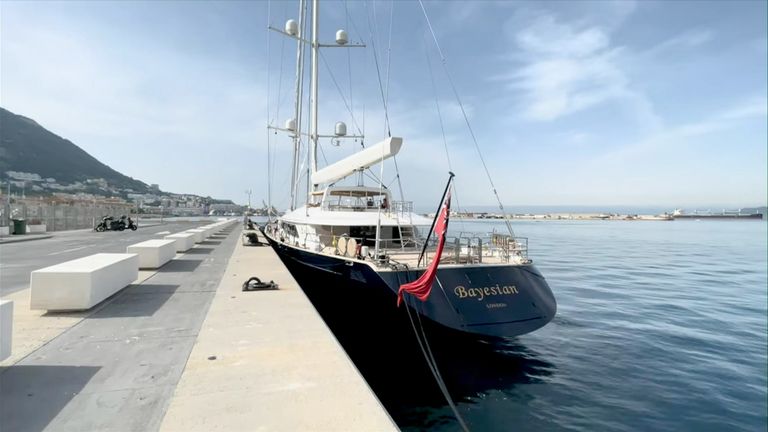
Vessels like Mike Lynch's stricken superyacht are "unsinkable", according to the chief executive of the firm which makes and sells them.
Giovanni Costantino, CEO of The Italian Sea Group, told Sky News there are no flaws with the design and construction of the Bayesian superyacht which capsized in a storm off the coast of Porticello, Sicily, on Monday.
Five bodies were found by divers on Wednesday - taking the number of confirmed dead to six.
The Italian Sea Group also owns the firm that built British tech tycoon Mr Lynch's Bayesian, and Mr Costantino said the vessels "are the safest in the most absolute sense".

"Being the manufacturer of Perini [boats], I know very well how the boats have always been designed and built," he said.
"And as Perini is a sailing ship... sailing ships are renowned to be the safest ever."
He said their structure and keel made them "unsinkable bodies".
Read more on this story: Why search of superyacht wreck has been so difficult Hero mum 'slept with baby on deck when storm sank yacht'
Be the first to get Breaking News
Install the Sky News app for free

Mr Costantino said news of the sinking "put me in a state of sadness on one side and of disbelief on the other".
"This incident sounds like an unbelievable story, both technically and as a fact," he said.
It is understood Italian prosecutors investigating the incident are continuing to hold interviews with the survivors.
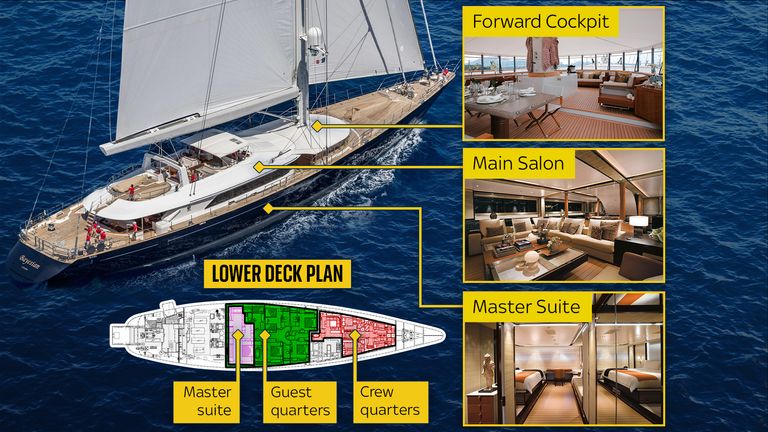
On Tuesday they questioned the captain for more than two hours to help reconstruct what happened and provide useful technical details.
Four British inspectors are also in Porticello and have begun a preliminary assessment of events.
It is understood they will look at all relevant aspects of the incident, including the design, stability, and operation of the vessel. They will also examine the effects of the weather conditions experienced.

Keep up with all the latest news from the UK and around the world by following Sky News
Twenty-two people were on board the vessel, 15 of whom were rescued - including Briton Charlotte Golunski and her one-year-old daughter Sofia.
Divers will resume efforts on Thursday morning to bring ashore a body they found earlier. One more person remains missing.
Related Topics
- Superyacht sinking

- AMERICA'S CUP
- CLASSIFIEDS
- NEWSLETTERS
- SUBMIT NEWS

Drama on fifth day of Louis Vuitton Cup Final as British and Italians remain even at 4-4


Related Articles


IMAGES
VIDEO
COMMENTS
Starting at only $119. World Wide shipping. Tiller covers, clutches and other accessories. World class Quality, Handmade Sailboat Tillers. Buy direct from the manufacturer and save.
By Steve D'Antonio. August 22, 2024. This manual wire stripper cuts small machine screws and, in a pinch, will crimp solderless terminals as well. Steve D'Antonio. "Tools are your good friends.". Those are the opening words of the US Navy's Use of Tools manual, first printed in 1945. It goes on to explain: "Why?
The following tools fall into this category: Largest flat-blade screwdriver that will fit in the bag, also used as pry bar. Two multi-blade screwdrivers (large ratchet unit and smaller one with specialty blades) Three small jewelers screwdrivers two flat blades (small and tiny) and one Phillips. Eight ratcheting box wrenches two 7/16 inch, two ...
Fortunately, an astonishing number of common repairs can be made with just five basic tools, which should be aboard every boat. They are: 1) a 6in adjustable wrench; 2) slip-joint pliers of similar size; 3) needle-nose pliers; 4) a #2 Phillips-head screwdriver; 5) a 3/16in slot-head screwdriver.
Sailing Tool Bag Contents. Ratcheting screwdriver with double drive and 30 bits. Two putty knives. Stubby screwdriver set. Phillips and flat head screwdriver set. 8″ extra large screwdriver. Vise-grip locking pliers. Metric AND SAE hex key sets. Slip joint, long nose, and diagonal pliers.
Scissors can prove useful in many situations that might come up during sailing. From cutting line to cutting fiberglass, emergency gaskets, and sandpaper for filing corrosion, you will likely get a lot of use out of your scissors. 5. A Flashlight, Back-Up Batteries and Bulbs, and Maybe Some Marine Lights.
The amount of power you will need depends on your habits and the equipment aboard. Five hundred amp hours is a starting point for today's cruisers and 1,000 amp hours will be better. Radios, lights, fans, microwave ovens, TVs, and electronics all need good battery capacity and strong voltage to function.
Katie and Mike Gabriel. Drill and driver with lithium rechargeable batteries: The drill is pretty straightforward, but let's talk about the driver. I don't see these in many boat toolkits, but it is one of my top-used tools. With a screw bit, the driver zips screws in and out at lightning speed.
A 17-piece wrench set or a full complement of 1/2in drive sockets are likely to be nothing more than expensive ballast aboard most coastal cruising boats. Carry only those tools that fit the fasteners that hold the various bits of your boat together and you will have what you need and won't be burdened by what you don't.
Two versions. The first is for simple boats, the second is the starting point for more comprehensive cruising boat kits. ULTRALIGHT KIT. On a dinghy it combines day needs (sunscreen and minor first aid) and a very few basic tools. On my sport boat it is pure tool bag, since my day bag contains the food, water, radio and such.
Bringing an oil drainer only makes sense for long sailing trips. But it's such a clean and hassle-free way to do an oil change. For most marine motors, you need to change the oil every 100 hours. However, changing the oil more often is better for the engine. 100 hours may seem like a lot, but it's actually not.
The modern cruising boat is a complicated machine that needs to function off the grid in a harsh marine environment. It requires constant maintenance and on-the-fly fixes that would make MacGyver proud. Assuming that your vessel has the usual tool kit of wrenches, screwdrivers and duct tape, here are useful tools to have aboard.
The tools and materials required to maintain and repair everything on a boat will barely fit in a room. Just the kit required to maintain vital systems will raise the waterline of a large boat and is impractical in a smaller boat. Fortunately, when day sailing and even cruising locally, all we really need to do is get back to the dock … any dock.
Leatherman Wave - Best Sailing Multitool. This knife has four main blades: straight, serrated, wood saw, and metal saw with coarse and fine files, all of which can be locked open. The wood saw was easily the best on the test and ferociously sharp. Both cutting blades can be opened singlehanded. It has good needlenose pliers, with wire cutters ...
The following tools are more specialized for specific boating needs but are crucial to have on board: 1. Marine sealant and caulk gun. A tube of marine sealant, along with a caulk gun, is essential for sealing leaks and cracks in your boat's hull, as well as sealing areas around hardware installations. 2.
The Ultimate Boat Maintenance Guide. 1. Multi-Tool. A multi-tool is the bare minimum for quick jobs, and you can pack it easily if you're overnighting or cruising on other people's boats. The basics include flat and Philips head screwdrivers, pliers, assorted knives, a saw, and in even a corkscrew. 2.
In addition, here is a trick for taking care of your tools when changing the raw water impeller. First, spray the area around the water pump with water dispersant oil spray. Change the impeller. When done, wash the entire area around the water pump and any tools used with freshwater. After that, dry the area and any tools you used with a water ...
Sailing Tools: A Comprehensive Guide for Enthusiasts. September 22, 2023. Michael Thompson. Accessories, Guides. Sailing is a thrilling adventure that demands precision, skill, and the right tools. Whether you're a seasoned sailor or a newbie eager to hoist your first sail, having the right sailing tools can make a world of difference in your ...
Other gear: 1 anchor for inshore. at least 2 anchors for offshore (preferably 3 - 2 storm anchors) tool kit for minor repairs on rigging, sails, and engine. multimeter for checking the wiring. full tank of fuel. spare parts (plugs, fuses, etc.) heaving line 50'-70'.
The Boat's Medical Kit. A medical is a must-have accessory in any sailboat. It should have partitions with each partition meant for a particular class of injury. The kit should also be readily available to the crew and have common drugs, bandages, and a first-aid kit.
The most important ones are a refrigerator, a compass, a VHF Radio, patching materials, a sails repair kit, and others. As listed above, this equipment is a must-have while you're cruising. However, this is not an all-encompassing list but a general list. Accessories and equipment are based on your needs, your course, and your sailboat.
The tools and spares you shouldn't sail without. Give a thought to your inventory this winter to keep you cruising next season, says Rachael Sprot as she takes you through the tools you need on a boat. Carrying a decent set of spares and tools gives you independence and extends your cruising range. Credit: Rubicon 3.
We haven't found a smaller, similar one. It hasn't been a problem, but the current one would be difficult to get in a tight space. You can get our 12-inch strap wrench here. 9. Butane Soldering Iron. If you want to do electrical work, a butane soldering iron is an excellent addition to your tool kit.
A bread knife is one of the staple boat galley accessories, you might be cutting bread with it… sometimes it's useful lashed to a pole for lopping a rope off your propeller too. Make sure you ...
Unlock next-level power for every scenario with EcoFlow' new DELTA 3 and RIVER 3 series! Enjoy @EcoFlowTech exclusive preorder offer! Get a Free DELTA Bag on...
It was a far-reaching step by a Service that was cognisant of the need to, firstly, engender an interest across the service for this extreme sport, secondly, provide a formal training facility for producing more ocean sailors and, thirdly, to enable transition of sailing training from a small dinghy (usually around 20 feet length) to keel boat ...
New Delhi: Two women officers of the Indian Navy -- Lt. Cdr Roopa A. and Lt. Cdr Dilna K. -- on Wednesday embarked from Goa on a challenging mission to circumnavigate the globe in over eight months.
Top 10 Best Boats 2025 Nominees Leopard 46, Xquisite Solar Sail 60. Xquisite 60 Solar Sail The new flagship in the Xquisite Yachts sailing line is the 60 Solar Sail, a no-luxury-left-behind bluewater cat that that employs hybrid propulsion to maximize energy autonomy.
Sailing yachts like Mike Lynch's are 'unsinkable bodies', CEO of boat manufacturing firm says. Bayesian superyacht which sank off Italy is an "unsinkable" vessel, Giovanni Costantino, CEO of The ...
Alinghi capsized while on a training sail. Posted on 29 Sep Drama and thrilling action in Barcelona Louis Vuitton Cup Final tied 2-2 after a breezy day INEOS Britannia and Luna Rossa Prada Pirelli, the outstanding finalists in the Louis Vuitton Cup were kept on standby prior to racing today as a solid Mediterranean 'Garbi' breeze pushed ...